- FOR PROFESSIONALS
- PATIENT PORTAL
- TELETHERAPY
We have beds available!

What Is a Bad Trip?
Editorial Policy | Research Policy
Psychedelic drugs such as LSD, mushrooms, and Molly can cause hallucinations known as a “bad trip”. Learn what causes a bad trip, how to identify warning signs, and how to stop it.
A trip refers to the intoxication from a drug that causes hallucinations. It is called a trip because the sensations that a psychedelic ( hallucination-causing ) drug causes can be so strange that it feels as if you are in a whole different world. A bad trip, also sometimes called a bad acid trip, occurs when the trip a psychedelic drug causes is negative.
Bad trips can lead to excessive fear, agitation or emotionally disturbing situations. Someone who is having a bad trip may feel as if time is standing still and may have disturbing hallucinations that cause extreme fear or mood swings.
What Causes a Bad Trip?
There are several things that can increase the probability of a bad trip , but anyone who is using psychedelic substances is at risk of having a bad trip. Some of the things that can increase the risk of having a bad trip include:
- Taking higher doses of a psychedelic drug
- Being in a negative emotional state before using or while using psychedelics
- Being in settings with excessive stimulation
- Using alcohol at the same time as using a psychedelic drug
- Not having someone stay with you while using psychedelic drugs
- Not drinking enough water
While avoiding these risks can reduce your chances of having a bad trip, anyone can have a bad trip at any time while using psychedelics. Someone who has been using psychedelic drugs for years and has never had a bad trip can have a bad trip while using, even if they have not changed anything about how they use.
Drugs That Can Cause a Bad Trip
Any drug that can cause hallucinations and lead to a trip can cause a bad trip. These drugs are called psychedelic drugs and are often used for the hallucinations they create. Some common psychedelic drugs include:
- LSD – Lysergic acid diethylamide (LSD), also known as acid , is primarily taken for the hallucination that it creates. LSD is probably the best known psychedelic drug.
- DMT – N,N-Dimethyltryptamine (DMT) is a powerful psychedelic drug that can lead to a bad trip. Because of how strong the effects of DMT are, it is more likely to lead to a bad trip than many other psychedelic drugs.( See More: What is DMT
- Mushrooms – Psilocybin mushrooms, also known as “shrooms” or “magic mushrooms,” are hallucinogenic fungi that can lead to a bad trip. A bad mushroom trip may also be referred to as a bad shroom trip.
- Molly – Molly, a slang name for the drug MDMA , is a psychedelic drug that is commonly used in parties or raves. Bad molly trips are more common in situations where people become dehydrated from over-partying.
- Salvia – Salvia, also known as “sage of the diviners,” is a hallucinogenic drug that is shorter-acting and more potent than many other psychedelic drugs. Bad trips while using salvia are reported to be more terrifying than those experienced while using other psychedelic drugs.
- Marijuana – Bad trips while using marijuana are uncommon, but can definitely still occur. Some of the most common bad trip symptoms occurring with weed are anxiety and facial numbness.
Symptoms of a Bad Trip
Bad acid trip symptoms are highly individualized and may be different from previous bad trip symptoms for the same individual. Some common bad trip symptoms include:
- A sensation that time is standing still
- Negative thoughts or interpretations of events around you
- Extreme paranoia
- Extreme and sudden mood swings
- Negative hallucinations that may include sensations, sounds or sights
If you are with someone who is experiencing these symptoms and they have recently been using a psychedelic drug, they could be having a bad trip. If you are with someone who is having these symptoms and you are not sure if they have taken any drugs, you should take them to the nearest hospital or call 911.
How to Stop a Bad Trip
Stopping a bad trip may not be possible, but there are things that can be done to help someone who is having a bad trip . If someone is having a bad trip, they should be moved away from noise and stimulation, as this can make a bad trip worse. A bad trip guide can also help. This involves having someone who is sober stay with the person having the bad trip and talk them through the trip. Not everyone will benefit from a bad trip guide, and some people may develop a paranoid attitude towards the guide or even become aggressive.
Some medications may help to stop a bad trip, but these can only be given in a hospital. Calling 911 or going to the nearest emergency room can help provide someone who is having a bad trip with these medications.
Related Topic: Treatment options for LSD

Carbonaro, T.M., et al. “ Survey Study of Challenging Experiences […]egative Consequences .” Journal of Psychopharmacology, August 20, 2016. Accessed August 14, 2019.
Davis, Kathleen. “ Salvia: What Are the Effects? ” Medical News Today, January 16, 2019. Accessed August 14, 2019.
Sturtz, Rachel. “ Refinery29: 7 Ways To Help Someone Who’s Having A Bad Trip .” Multidisciplinary Association for Psychedelic Studies, 2019. Accessed August 14, 2019.
The Recovery Village aims to improve the quality of life for people struggling with substance use or mental health disorder with fact-based content about the nature of behavioral health conditions, treatment options and their related outcomes. We publish material that is researched, cited, edited and reviewed by licensed medical professionals. The information we provide is not intended to be a substitute for professional medical advice, diagnosis or treatment. It should not be used in place of the advice of your physician or other qualified healthcare providers.
We can help answer your questions and talk through any concerns.
- VIRTUAL PROGRAM
- Call 24/7: 877-505-4673 TAP TO CALL

- Hallucinogens and Tripping
- Addiction Blog
- Drug Addiction Treatment
Education efforts on substance abuse tend to leave out one important class of drugs: hallucinogens. Although humanity has used them for various purposes for thousands of years, the average person understands them poorly, and research is still revealing new and surprising information about them. What do hallucinogens do, and how dangerous are they? This guide will give you the information you need to understand hallucinogens and tripping, as well as the consequences of abusing this class of drug.
What Are Hallucinogens?
Simply put, hallucinogens are drugs that cause the user to have hallucinations. These hallucinations represent an extreme distortion in how the person perceives reality and the stimuli in the world around them. They may see anything from subtle visual and auditory changes to heavily warped representations of their surroundings, and may even visualize things that are not there at all. Hallucinogens also alter emotion and cognition, producing intense emotions from extreme euphoria to debilitating terror depending on a variety of factors.
What Are the Types of Hallucinogens?
Schedule i vs. schedule ii hallucinogens, what is tripping, what to do when someone is having a bad trip, can you overdose on hallucinogens, are hallucinogens addictive, how is a hallucinogen addiction treated, choose gateway foundation for hallucinogen addiction treatment.
“Hallucinogen” is an umbrella term that covers three separate categories of drug. Each category possesses a certain set of effects that determine how people use them, as well as different levels of relative safety.
1. Psychedelics
Psychedelics are the most commonly known hallucinogen and are a staple of pop culture. When people wonder what hallucinogens do, they’re usually asking about psychedelics. The origin of the term springs from the Greek words “psyche,” meaning “soul” or “mind,” and “delein,” meaning “to manifest.” This alludes to the idea that psychedelics bring out hidden elements and visions from the recesses of the human mind. Proponents of psychedelics believe they have the power to unlock divine or otherwise spiritually profound experiences. Psychedelics are further classified into two categories: serotonergic psychedelics and serotonin releasers.
Serotonergic Psychedelics
Serotonergic psychedelics are known as the “classic” psychedelics. Their method of action modifies the normal transmission of serotonin within the central nervous system (CNS). Serotonin is responsible for a multitude of functions in the body, including mood balance and sensory perception. It is often referred to as the “happy chemical” due to its influence on feelings of happiness and well-being.
Lysergic acid diethylamide, more commonly known as LSD or acid, is an illegal semi-synthetic drug famous for causing extreme distortion of sensory perception as well as hallucinations. It is partially derived from a fungus called ergot, which grows on certain grains. LSD activates serotonin receptors and stimulates serotonin production. The receptors affected are those that help us perceive and interpret the world, and LSD causes them to filter out less stimuli, leading to overstimulation. This overstimulation produces significant changes in cognition, perception, attention and emotional state.
LSD was originally created in 1938 as a way to treat respiratory depression, and its hallucinogenic properties were discovered through accidental absorption into the skin. During the 1960s, it became popular for recreational use. In 1967, the Drug Enforcement Administration (DEA) classified it as a Schedule I drug, and its popularity has decreased since.
2. Psilocybin
Psilocybin is a hallucinogen found in certain types of “magic mushrooms.” This Schedule I substance is used recreationally for the euphoria and distortion of the senses it induces. Psilocybin doesn’t always cause the user to have full-fledged hallucinations. Typically, it changes the way people perceive people and objects that are actually present in the environment. The hallucinogenic effects of this substance usually take under 30 minutes to begin after ingestion and may last around four to six hours.
Psilocybin is most commonly brewed into a tea or used in the preparation of a food item, as its flavor is quite bitter and unpleasant. Some psilocybin comes in capsules filled with the powder of dried and crushed mushrooms. Psilocybin has a wide range of potency, which depends on factors including:
- Mushroom species
- Origin and growing conditions
- Period of harvest
- Fresh or dried state
One thing many people don’t realize is that dried mushrooms are significantly more potent than fresh ones. This fact may lead to inexperienced individuals taking too much and having negative experiences.
3. Mescaline and Peyote
Mescaline is the active ingredient found in the fruit and seeds present on the outside of the peyote cactus. When using peyote for its hallucinogenic effects, people gather and dry the fruit or seeds. They can be eaten or brewed into a tea, as well as ground into powder for capsules similar to those made from psilocybin mushrooms. The pure form of mescaline, mescaline sulfate, can be synthesized in a lab environment, resulting in a crystalline white product.
Mescaline produces an altered state of consciousness that many people report as being euphoric and dream-like, which can last for around 10 to 12 hours. Mescaline has been used by many indigenous peoples as a religious sacrament for thousands of years and is one of the oldest psychedelics known. In these cases, the hallucinogenic experience is purposely extended for multiple days.
Serotonin Releasers
The other broad category within psychedelics is serotonin releasers. This class includes “club drugs” such as MDMA . The effects of hallucinogens in this category include:
- Feelings of openness
- Increased empathy
- Feelings of general love
- Increased self-awareness
- Mild auditory and visual distortions
The mild hallucinogenic effect in combination with the emotional effects of serotonin release are often viewed as enhancements to social and music experiences.
2. Dissociatives
Dissociative drugs can be very dangerous. They create visual and auditory distortion like psychedelics, but they are also accompanied by the sensation of floating and feeling detached from reality or one’s body. Dissociatives frequently cause:
- Impaired motor function
- Memory loss
The effects of dissociatives are very unpredictable and some users end up feeling them for days after ingesting the substance.
Phencyclidine (PCP) or “ angel dust ” is a street drug sold as a powder to be dissolved in water. It is sometimes dissolved in alcohol, typically with disastrous results. PCP was developed in the 1920s as an anesthetic, and its ability to eliminate pain is one of its more dangerous aspects when used recreationally. It contributes to a sense of invincibility that leads users to take extremely dangerous actions, such as jumping out of windows or walking into traffic.
The effects of PCP often include feelings of euphoria combined with distortions in the perception of light, color, sound and touch as well as time. PCP has many surprising street names, including:
- Embalming fluid
- Killer weed
- Rocket fuel
- Super grass
Ketamine , developed in 1962 , started out as an anesthetic. However, its hallucinogenic effects precipitated its use as a recreational drug. Ketamine produces a sensation of floating and dissociation, which typically lasts only an hour or less, but other effects that alter the senses, as well as judgment and coordination, can last for up to 24 hours.
If someone takes a large dose of ketamine, they may enter what is known as a “K-hole.” This state occurs when the user is almost completely sedated, and people describe it as having a near-death or out-of-body experience.
Dextromethorphan (DXM), also called “robo,” is one dissociative hallucinogen most people don’t realize is highly accessible to those who want to abuse it. Its cough-suppressing capabilities make it a common ingredient in a variety of “extra strength” over-the-counter cough syrups and cold medications. At low dosages, DXM may create low-grade visual distortions and have a mild stimulant effect. At high doses, it displays the same dissociative effects of hallucinogens like Ketamine and PCP. DXM is especially popular among teens and young adults because it is relatively easy to obtain.
3. Deliriants
Deliriants are the least desirable of hallucinogens for recreational use. Rather than inducing a semi-lucid state like psychedelics do, deliriants cause a state of delirium. People under the influence of deliriants may do things like:
- Have complete conversations with imaginary people.
- Finish a complex task like getting dressed only to find that they never actually started the action.
- Be unable to recognize themselves in a mirror.
These effects tend to evoke feelings of fear and panic rather than the pleasurable experience most people are seeking when they use hallucinogens.
DPH (Benadryl)
The most common deliriant is diphenhydramine (DPH), which is used as an antihistamine in the popular medication Benadryl. When taken outside the recommended dosage, DPH has extreme sedation and deliriant effects. People who take too much Benadryl frequently report having vivid and terrifying hallucinations akin to bad nightmares.
The DEA labels most hallucinogens as controlled substances . Schedule I drugs are those determined to meet the following criteria:
- High potential for abuse.
- No accepted medical use in treatment in the United States.
- Lack of accepted safety for use of the substance even under medical supervision.
Schedule I hallucinogens include psilocybin, LSD and mescaline. Most hallucinogens fall under Schedule I.
Schedule II substances are described in the following terms:
- High potential for abuse
- Currently accepted for use in medical treatment in the United States
- Can lead to severe psychological or physical dependence
PCP is a Schedule II drug.
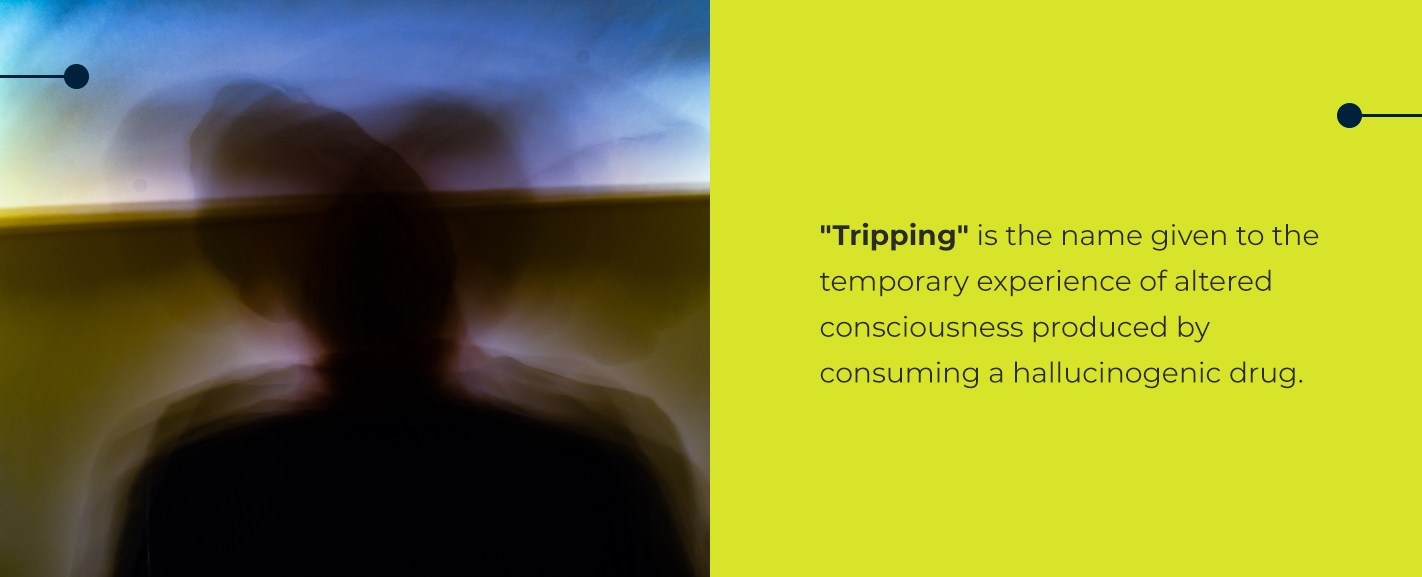
Someone on a trip will experience emotional changes as well, affecting how they feel about themselves, others and the world at large. These changes may be perceived as positive or negative, based on several unpredictable variables.
Good Trips vs. Bad Trips
People take hallucinogens with the intent to have a positive experience. A positive hallucinogenic experience is marked by a pleasant dream-like state, enjoyable perceptual distortions and in some cases spiritual realizations. A person will come out of a good trip feeling fulfilled, whether recreationally or on a deeper level.
Bad trips are comparable to nightmares. In a bad trip, visual and auditory distortions are frightening and may take the shape of monsters or more abstractly frightening entities. A bad trip induces fear and often panic, which can cause people to feel like the world is ending or that they are in imminent danger. A bad hallucinogenic experience creates paranoia and a feeling of losing one’s mind, which is often more than enough to keep people from trying this class of drugs again.
Being around someone who is having a bad trip can be a stressful situation whether or not you are also consuming hallucinogens. Here are five tips you can use to help someone who is having a bad trip.
1. Don’t Panic
Remaining rooted in reality is one of the best ways to help someone on a bad trip. The person is likely agitated and paranoid, which makes them highly sensitive to the cues of the people around them. Remaining calm throughout the ordeal will help keep the tripping person’s fear from escalating and may help them calm down.
2. Reaffirm Safety
One of the worst parts of a bad trip is the feeling of danger and impending doom. The person may feel that something or someone is “out to get them” and reminding them that they are in a safe place with people who care about them can help reduce their disorientation and paranoia.
3. Try Breathing Exercises
As panic sets in, a tripping person might start hyperventilating, leading to further negative physical effects like rapid heart rate and high blood pressure. If you can, get the person to participate in some simple exercises to help regulate breathing and calm them down.
4. Offer Water
Giving the person a glass of cold water can help in two ways. For one, panicking over a bad trip can increase dehydration, creating physical symptoms that make the trip even worse. Additionally, having to hold onto a glass of water and coordinate the action of drinking can force the person to focus more on reality instead of continuing down the rabbit hole of a bad trip.
Psychedelics are not inherently toxic and do not cause overdoses in the way most people think of them. Taking a large dose of psychedelics is not likely to harm organs through inherent toxicity, and will simply result in an extreme, uncontrollable trip that can easily turn bad. However, hallucinogens can cause people to act in dangerous and erratic ways that may lead to life-threatening injuries.
Dissociative and deliriant drugs, on the other hand, can be extremely dangerous if taken in overdose quantities. For instance, the effects of a ketamine overdose include:
- Respiratory depression
- Hypotension
- Bradycardia
- Heart attack
For this class of hallucinogens, an overdose can be fatal if the person doesn’t receive medical care in time.
They can be, although psychedelics are not known to cause physical dependence. LSD, for example, does not cause compulsive drug-seeking behavior and is therefore not considered addictive in the traditional sense. However, continued use does result in tolerance, and the person using it will eventually have to take more and more to achieve the desired effect. This is highly dangerous given how unpredictable all hallucinogens can be.
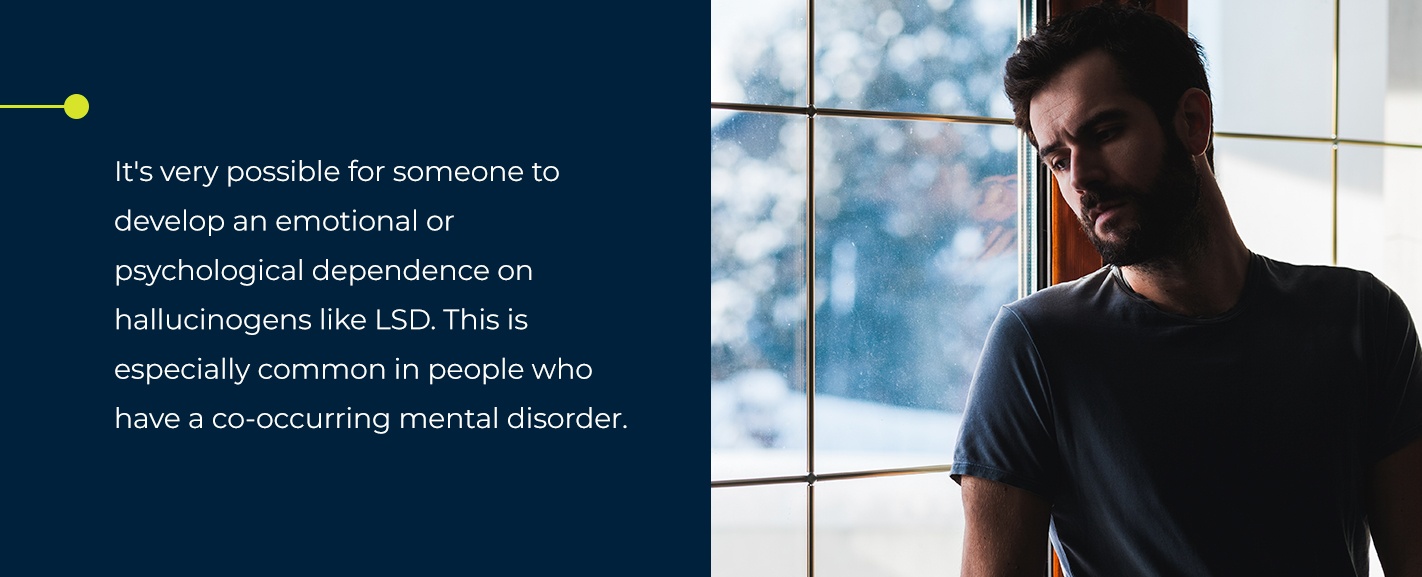
Other types of hallucinogens such as PCP and ketamine can be highly physically addictive and produce common symptoms of addiction such as headaches, drug cravings and severe sweating upon cessation of the drug. Regardless of the category, one of the long-term effects of hallucinogens is addiction.
Like other types of addiction, addiction to hallucinogens can be treated at multiple levels of care. Depending on the severity of the addiction and the presence of other issues such as mental illness or abuse of multiple drugs, a person can receive effective treatment in these formats.
1. Residential Treatment
Residential drug rehab centers are an effective option for people who are struggling with a dual diagnosis or abusing multiple substances at the same time. The structured and supportive environment eliminates the opportunity to relapse and provides the most rigorous level of treatment.
2. Partial Hospitalization
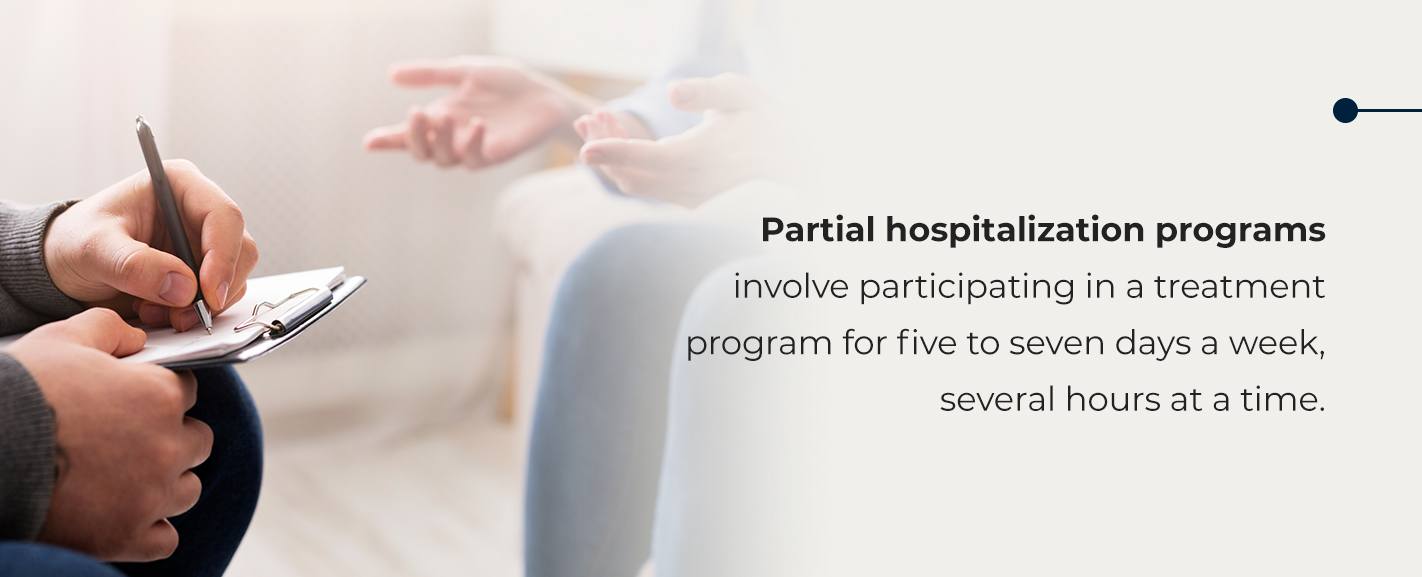
3. Outpatient Treatment
For people who have been abusing hallucinogens only and have not developed severe drug-seeking symptoms, outpatient treatment can be highly effective. These programs offer many of the same treatment methods available in residential and partial hospitalization programs on a flexible part-time basis. They are ideal for people who need addiction treatment but can’t give up responsibilities like work, school or childcare.
4. Therapy and Support
For any addiction treatment program to be successful, it must include robust offerings of therapy and support groups. To overcome addiction and begin on the path to a successful recovery, individuals have to get to the root of underlying issues that contributed to the development of their substance abuse problems.
Each individual may benefit from therapy differently. Those who have trouble identifying and processing their emotions can benefit greatly from dialectical behavioral therapy (DBT). People whose addiction arose as a result of a traumatic event or traumatic circumstances can benefit from trauma-informed therapy .
Processing one’s addiction and recovery in groups is essential for helping people realize they are not alone. Interacting with peers who understand the issues at hand is beneficial in building a support network for treatment and beyond. A good addiction treatment program will also offer family therapy to help inform and support the family system in recovery. Having multiple clinical services is a hallmark of an effective treatment program.
Although hallucinogen addiction is relatively rare, it can be just as devastating as addiction to other substances — especially if the substance being abused is a dissociative or a deliriant. Gateway Foundation understands the importance of using evidence-based treatment to combat all addictions, and we offer a wide variety of therapy options for those who are struggling with hallucinogen and other addictions.
If you or someone you care about is abusing hallucinogens, Gateway Foundation can help. Our team of experts is ready to create a personalized addiction treatment plan that addresses the unique needs and circumstances of each individual. Reaching out for help can feel frightening, but the long-term effects of hallucinogens make it imperative to seek treatment as soon as possible. To learn more about the programs and services available at Gateway Foundation, call us at 877.505.4673 or contact us online . Our knowledgeable and compassionate representatives are ready to answer your questions and get you or your loved one started on the path to recovery from hallucinogen addiction.
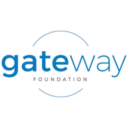
Gateway Foundation
Gateway Foundation is a recognized leader in evidence-based addiction treatment proven to get results. Our experts in Addiction Medicine—including highly educated clinical and medical professionals and expert psychiatrists and nurses—deliver care that never stops. For over 50 years, Gateway Foundation has been helping individuals and their families recover from addictions and behavioral health issues and is the only provider that covers the entire state of Illinois with 16 facilities from the Wisconsin Border to the Kentucky Border. Gateway has specific programs focusing on substance use disorders, trauma, depression, anxiety, and other co-occurring issues. We’re licensed by the state of Illinois and accredited by the Joint Commission. We are in-network with all the major commercial insurance plans. Gateway Foundation: Addiction medicine, saving lives.
Summer Substance Use Among Youth
Violence, Substance Abuse and Mental Illness

Addiction Destroys Dreams, We Can Help
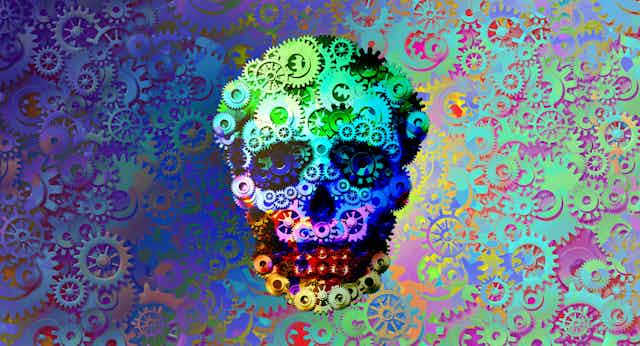
Using ‘trip killers’ to cut short bad drug trips is potentially dangerous
Professor of Neuropharmacology, University of Central Lancashire
Disclosure statement
Colin Davidson has previously received funding from the National Institute on Drug Abuse (NIH, USA) and the European Community for projects related to stimulant drug abuse and novel psychoactive compounds respectively. He is currently a paid consultant with the Defence Science Technology Laboratory (MOD) working on new psychoactive compounds.
University of Central Lancashire provides funding as a member of The Conversation UK.
View all partners
As interest in psychedelics has grown, so has interest in ways to end a bad trip. Recent research reveals that people are giving potentially dangerous advice on social media on how to stop a trip that is less than pleasurable.
Psychedelics cause changes in a person’s perception of reality. One of the earliest descriptions of a psychedelic experience in western literature can be found in Aldous Huxley’s 1953 book The Doors of Perception . Huxley describes mostly beautiful visions while tripping on mescaline.
And then there were the Beatles seeing “tangerine trees” and “marmalade skies” and “a girl with kaleidoscope eyes”.
The last few years have seen a resurgence of illicit use, not only of established psychedelics, such as LSD and magic mushrooms (psilocybin), but also of the novel psychoactive substances that are psychedelics, such as AMT, 5-MeO-DALT, mCPP and methoxetamine.
There is also renewed interest in studying these drugs as treatments for mental health conditions, such as post-traumatic stress disorder (PTSD) and depression. Even a single dose of these drugs appears to have long-term therapeutic effects.
But not all trips are pleasurable. Research shows that if someone is in a bad mood or depressed then they are more likely to have a bad trip , as are people who take too high a dose.
This sort of experience might include extreme fear, time standing still and mood swings. Very high doses of LSD can also cause agitation, vomiting, high blood pressure, hyperthermia and other nasty side-effects. But at regular doses, psychedelics are relatively safe .
To mitigate against bad trips, people will often take the drug in a relaxing and safe environment, and they might include a friend, or “trip sitter” to look after them for the duration of the trip. This was a common practice in the 1960s among people taking psychedelics.
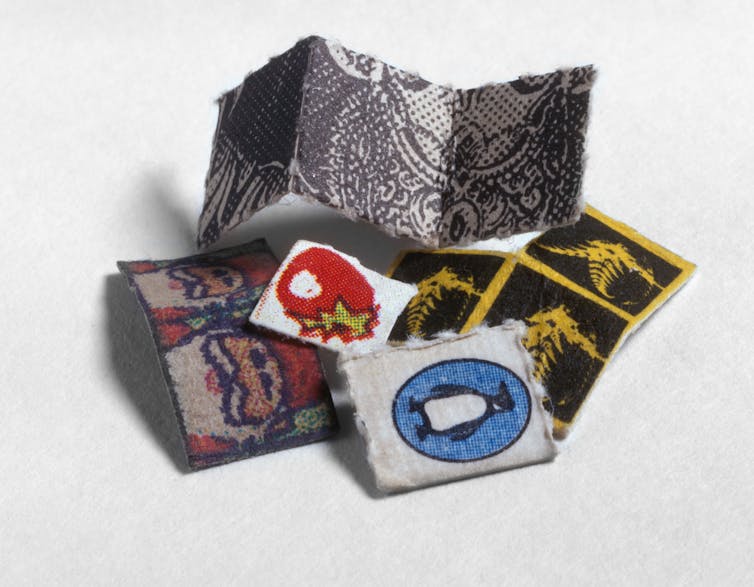
Trip killers
More recently, though, some psychedelic users have been turning to “trip killers” to end a bad trip. These are drugs that can either block the direct effects of the psychedelic or simply reduce the anxiety associated with a bad trip.
Few clinical studies have examined trip killers, but one has found that ketanserin – a drug used to treat high blood pressure – reverses the psychedelic effects of LSD.
A recent article in the Emergency Medical Journal analysed posts on Reddit about trip killers. The researchers found 128 threads with 709 posts from 2015 to 2023.
Trip killers were discussed most often for LSD (235 posts), magic mushrooms (143 posts) and MDMA (21 posts). The most commonly suggested trip killer was Xanax (an anxiolytic) followed by quetiapine (an antipsychotic), trazodone (an antidepressant) and diazepam (an anxiolytic). Alcohol, herbal remedies, opioids, antihistamines, sleep medication and cannabinoids were barely mentioned.
Receptor blocking
LSD and magic mushrooms create their effects by activating certain proteins in the brain. These are called 5-HT2A receptors and are usually activated by the neurotransmitter serotonin (5-HT). There are 14 known 5-HT receptors, but psychedelics have specific activity at only the 5-HT2A subtype.
To kill a trip then, one simply has to give the drug user another drug that blocks (rather than activates) the 5-HT2A receptor. Many prescription drugs can do this and they tend to be antipsychotic drugs .
Quetiapine from the list above is one popular example, while another antipsychotic, olanzapine, was mentioned in 14 posts in that study. Similarly, the atypical antidepressants trazodone and mirtazapine also block the 5-HT2A receptor.
One can think of these trip killers as working in the same way that naloxone would be used for heroin or fentanyl overdose. These drugs activate mu opioid receptors in the brain, while naloxone blocks these receptors. Naloxone is therefore used to treat life-threatening respiratory depression from opioid overdose.
Another option for the psychedelics would be to decrease the anxiety associated with the trip by taking anxiolytics, such as benzodiazapines – alprazolam (Xanax) and diazepam (Valium) being the most popular in the posts analysed above. These would also help the drug taker to fall asleep.
Some of the trip-killing drug doses suggested in the Reddit posts were high. For example, quetiapine was suggested to be used at 25mg to 600mg, but clinical guidance for these drugs suggests a single dose of up to 225mg.
The doses suggested on Reddit for alprazolam are 0.5mg to 4mg but the clinically suggested maximum dose is usually 2mg to 3mg. Four milligrams could cause low blood pressure, oversedation and respiratory depression. Unfortunately, benzodiazepines are also highly addictive and can lead to overdose deaths.
People who turn up at A&E suffering from a bad trip or overdose of a psychedelic will be reassured in a calm environment. If that doesn’t work, they are likely to be given an antipsychotic or low-dose benzodiazepine, at a clinically advised dose.
Read more: A brief history of drug-fuelled combatants
- War on Drugs
- Psychedelics
- Richard Nixon

Assistant Editor - 1 year cadetship

Executive Dean, Faculty of Health

Nutrition Research Coordinator – Bone Health Program

Lecturer/Senior Lecturer, Earth System Science (School of Science)

Sydney Horizon Educators (Identified)
Breaking News
What’s it like to take a $249 drug-free psychedelic trip? We found out
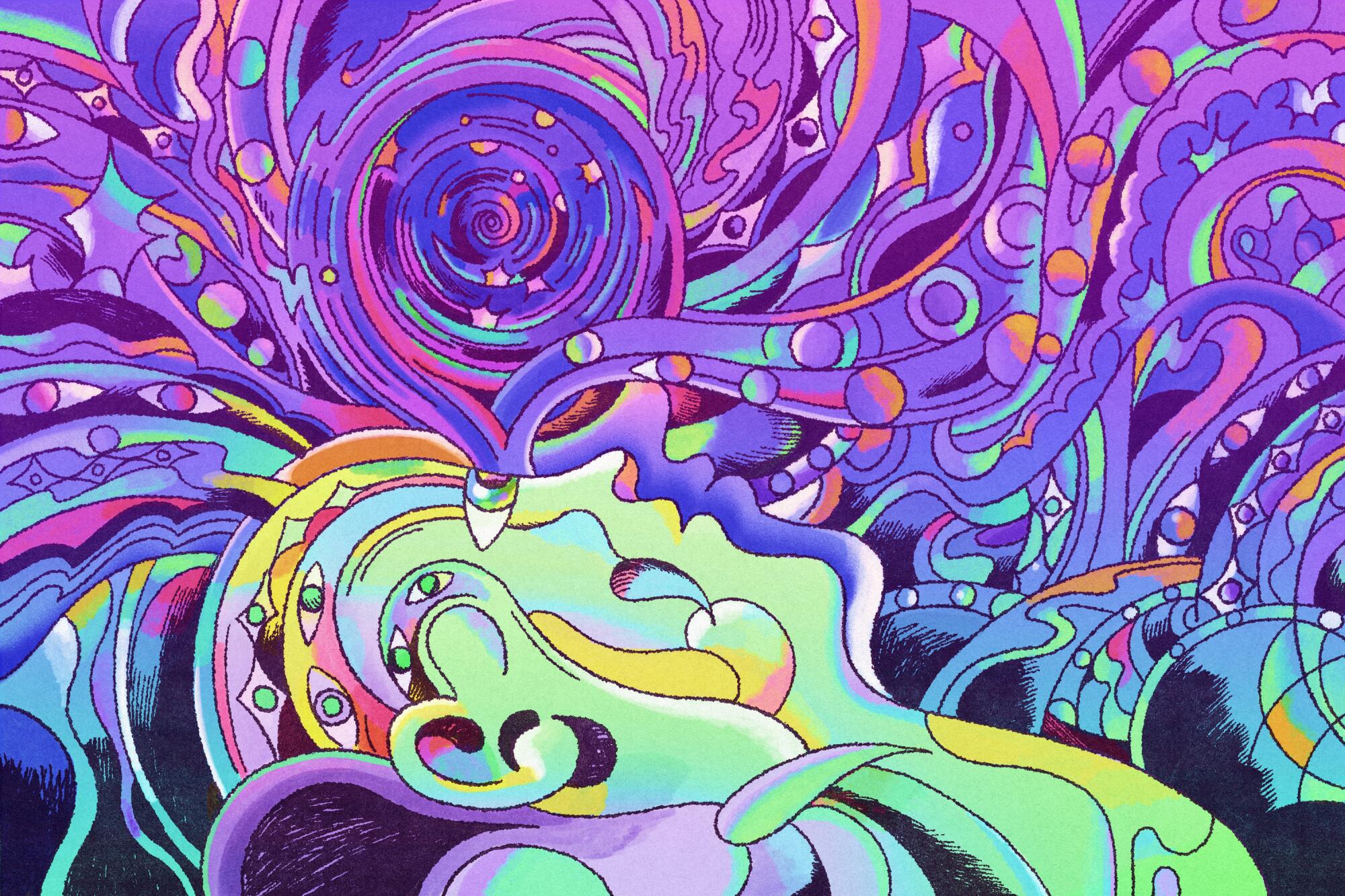
- Show more sharing options
- Copy Link URL Copied!
I’m familiar with magic mushrooms from back in the day. I took them a couple times in college — including on a particularly memorable Halloween — and thoroughly enjoyed the experience. So I was curious about a Santa Monica-based startup called the Reality Center that’s been trying to expand the mind and aid in healing the body via digital psychedelics — a proprietary combination of pulsing lights, sounds and vibrations — instead of consuming drugs.
Psilocybin, the active ingredient in magic mushrooms, is enjoying a peak pop-culture popularity not seen since the 1970s. Although illegal at the federal level, its consciousness-altering properties have shown promise in helping to treat PTSD, depression, anxiety and addiction. And recently I’ve heard Angelenos at cocktail parties swapping stories about their adventures in microdosing mushrooms (taking extremely small amounts) as casually as they might have discussed cannabis a decade ago.

Scientists explore using psychedelics to treat alcohol, drug disorders
Psilocybin and many other psychedelics are broadly prohibited under federal law. But U.S. researchers have been legally scrutinizing their use in scores of clinical trials.
Jan. 2, 2023
The use of psilocybin mushrooms was legalized in Oregon in 2020 and decriminalized in Colorado as of January, but recent efforts to give similar access to Californians have so far been unsuccessful (though a handful of cities — including San Francisco, Oakland and Santa Cruz — have passed resolutions effectively decriminalizing magic mushrooms).
For Angelenos, that means experimenting with psychedelic drugs requires breaking the law or taking a trip — as in an actual physical one — to one of the above shroom-friendly locales.
That made the idea of taking a legal psychedelic trip right here in Southern California (even under the guise of “sensory wellness”) appealing, though the price tag — $249 for a 60-minute session — gave me pause. Could a drug-free drug trip be worth that much? Especially when compared to the cost of magic mushrooms in the decriminalized marketplace? (Shelby Hartman, co-founder and editor-in-chief of L.A.-based psychedelics-focused magazine DoubleBlind, said an eighth of an ounce of whole, dried psilocybin mushrooms — enough for a serious trip — is currently “somewhere around $40 to $50.” That means flying round-trip to Denver and munching magic mushrooms the old-fashioned way would be about the same price as an hourlong digital trip.)

Palm Springs’ weed lounge game is hot right now — especially compared to L.A.
Pot smokers looking for social sesh options should consider heading to Palm Springs, which has 10 licensed consumption lounges compared to L.A.’s zero.
Feb. 8, 2023
But if the Reality Center’s magic technology really could alter someone’s consciousness the way magic mushrooms or other psychedelic compounds could, especially over several sessions (the company says the benefits increase over multiple sessions), maybe the results — therapeutic or recreational — would be worth every consciousness-expanding penny. There was only one way to find out.
I booked an hourlong session (and used a promo code for new customers, saving me $50 off my first session) via the Reality Center’s website, and then filled out two follow-up documents including a medical waiver (attesting that I didn’t have any implanted medical devices, photosensitivity or epilepsy). The other was a kind of New-Agey questionnaire that asked about my goals for the session, my astrological sign and my least favorite color.
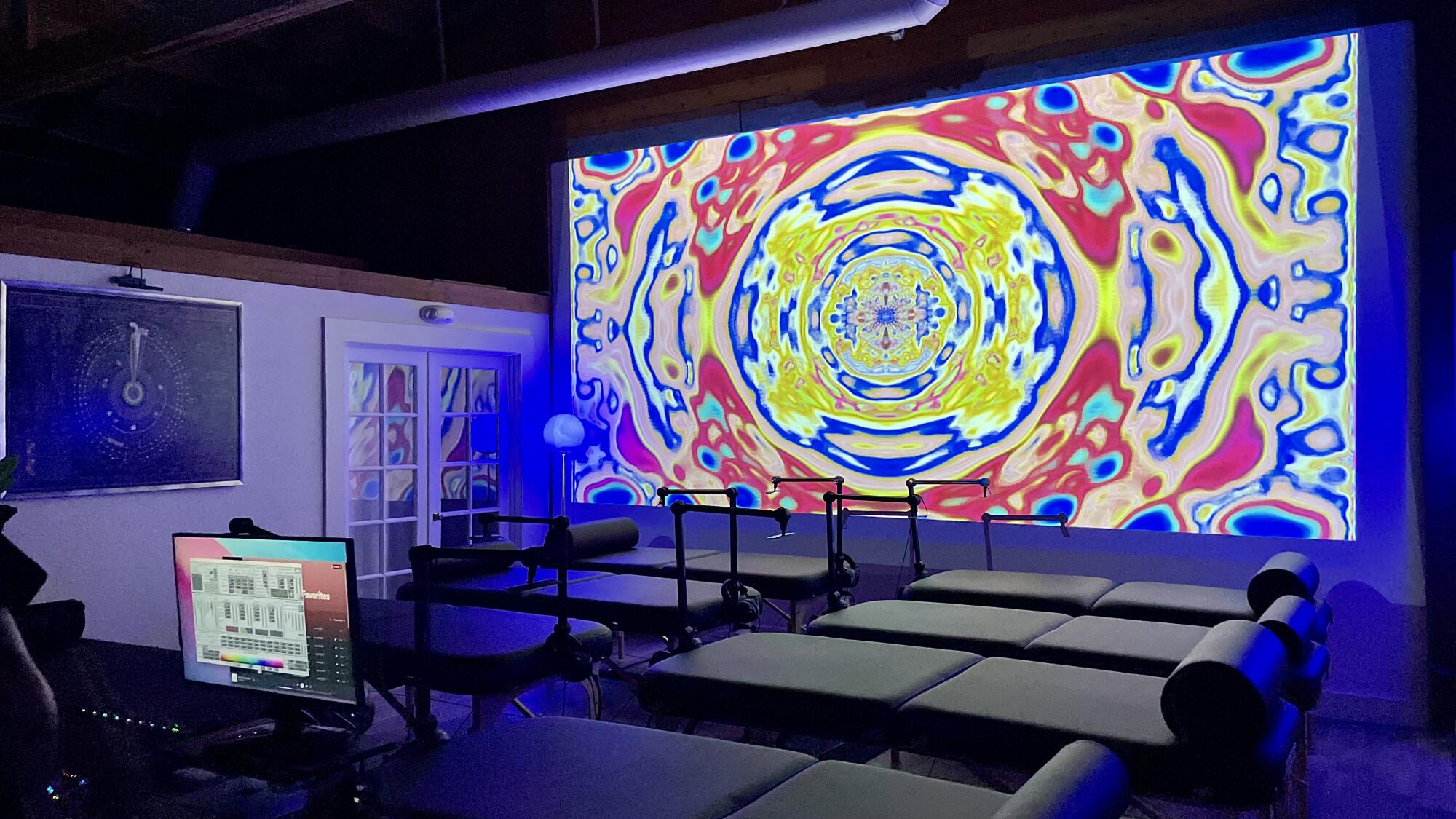
A few days later, I was on a bustling stretch of Santa Monica’s Second Street, where the portal to expanded consciousness appeared to be sandwiched between a hostel and a hot yoga studio. I found four other adventurous spirits were already queued up outside.
We were all ushered inside a dimly lit cluster of rooms by Tarun Raj and Jonathan Chia. (The former an artist and inventor and the latter a U.S. Army combat veteran, they co-founded the company with Benji Tucker and Don Estes.) The largest of the rooms inside the Reality Center felt like a trendy Hollywood fitness space set up inside a high-tech recording studio with a handful of massage tables in the middle, a trippy wall-sized video screen on one side and a rave-worthy stack of audio and visual equipment topped with a computer screen on the other.
“What we’re doing is sort of like neuroscience DJing,” Raj said after someone pointed out the equipment’s resemblance to a DJ setup. He explained that the role of the person behind the controls (known as the “reality manager”) is to use the various sensory inputs to, in his words, “jump-start” the mind and body and move it toward a near-meditative state. It’s an approach based on Estes’ theory of sensory resonance, which posits that the body’s autonomic nervous system can essentially be “reset” by synchronizing all of the major sensory mechanisms together — visual, aural and vibrational.
The foursome of aspiring psychonauts I’d arrived with would be launching from this room, which Chia said can accommodate groups of up to eight people at a time.
Smaller rooms around the periphery were set up for different scenarios. One space was for vocal analysis (which includes creating a kind of visual voice print designed to help you amplify and manifest your intent), one for postsession integration, one for a two-person experience (“Like when couples get a massage together,” Chia said) and one for the Wavetable experience. It was this last room that was to be my departure lounge.
Chia, who was my session’s reality manager, first asked me to remove my shoes and glasses and lie down on what looked — and felt — like a massage table with a foot-thick soft-sided waterbed layered on top. He explained that the mineral-heavy liquid inside the squishy layer was designed to mimic that of the human body. As I prepared to take my journey, Chia shared a little bit of his own.
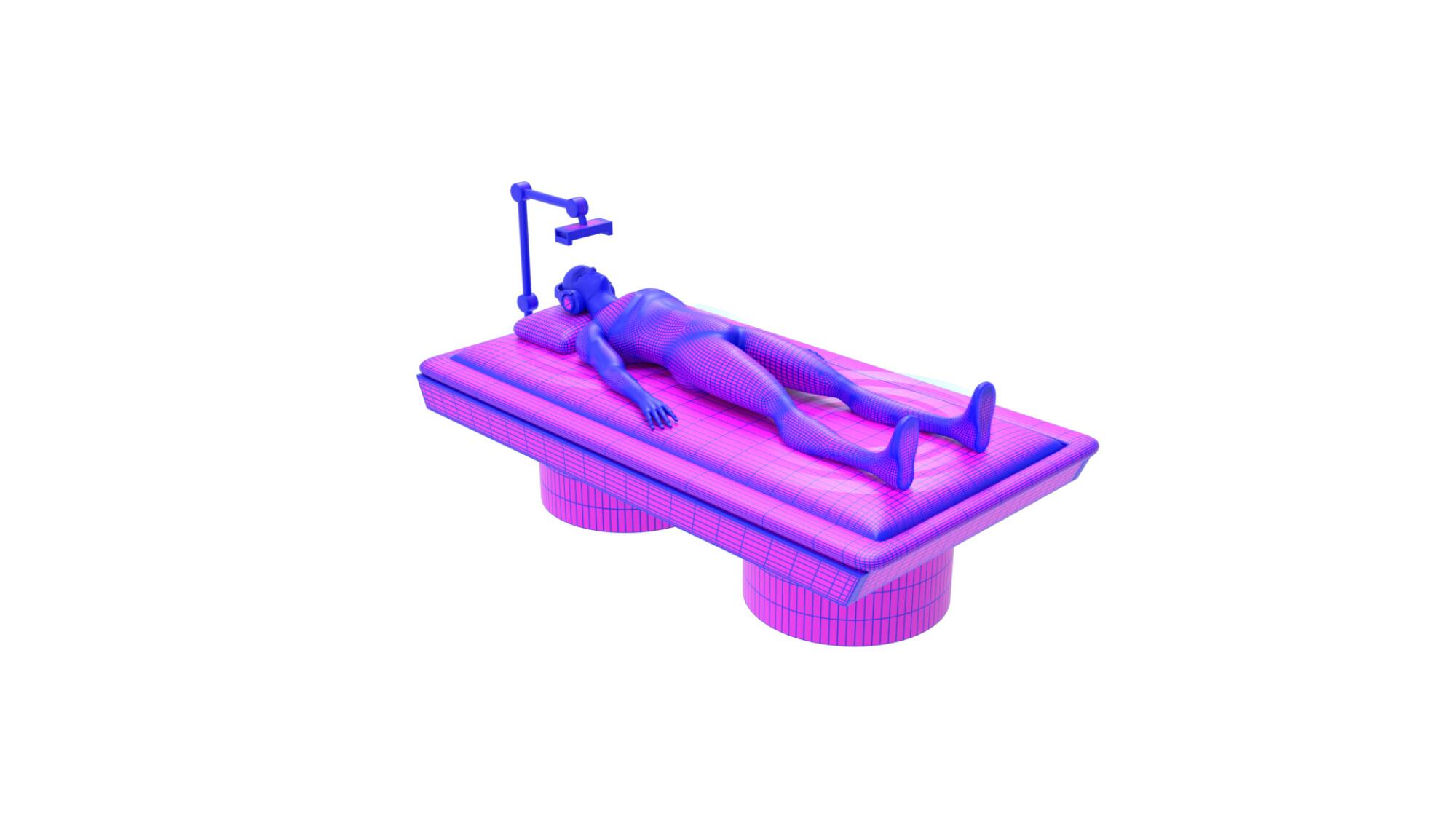
As a military veteran, he had originally tried to treat his post-traumatic stress by self-medicating with drugs and alcohol. His path to sensory wellness began after Raj, a longtime friend, introduced him to the healing power of reiki. Fast-forward to January 2022 when, having joined forces with Tucker and Estes, the Reality Center became a reality.
My session started with Chia leading me through some simple breathing exercises. Then he asked me to imagine myself in one of my favorite places (I pictured a mossy, wooded glen near my family home in Vermont) surrounded by the people who were important in my life (I imagined my family — a generation in each direction — with everyone wearing white like in the Season 1 finale of “Modern Family”). “You are rooted like a sequoia,” he said calmly into my headset, “strong and reaching up toward the sky.”
From here on out, things got next level pretty quickly. With my eyes firmly closed, I could full-on “see” the pulsing lights positioned just inches from my face — mostly cascading, melting and swirling whorls of color. Chanting, tinkling bells and crashing waves swelled into my headphones at the same time as rumbling and vibrating increased on all sides of me. From time to time, I could hear calming spoken-word snippets (“We find one ember. And very gently we fan that ember. Blow on it, it gets brighter. And from that ember we rebuild the fire ...”).
The ‘gnarly and painful’ therapeutic potential of ‘magic mushrooms’
Psilocybin, the psychoactive component of “magic mushrooms,” is the most-studied psychedelic, but there’s a lot we don’t know about how it works.
Feb. 14, 2023
Maybe halfway through, I became unmoored — detached as if I’d suddenly been cut free from a parasailing tether I didn’t know I’d been connected to my whole life. I had the sensation of hurtling through space. When waves crashed in my ears in concert with the rumbling beneath me and the rippling patterns lit up my optic nerves, it seemed as if I was nothing but sand passing through a reality sieve, all my constituent molecules dissolving at the waterline of a vast ocean.
I was one with the swirling fractal rainbow aura at the center of the universe and, for a brief moment, it felt as if I was staring backward through time to observe my own swirling double-helix strands of DNA taking shape out of the cosmic soup of nothingness. I felt hot tears well into the corners of scrunched-shut eyes. They were tears of gratitude, tears of suddenly feeling at peace, as if just for a nanosecond I’d been lucky enough to get a glimpse behind the curtain, to peek at the run-of-show road map of the universe and see where my dust-speck self fit into it.
Eventually, the sound, the pulsing lights and the vibrations began to ebb. As I once again became aware of my surroundings, I heard Chia’s voice urging me to take a few deep, centering breaths.

‘Magic mushrooms’ would be decriminalized in California under new bill
The possession and personal use of “magic mushrooms” and ayahuasca could be decriminalized under a new psychedelics bill introduced Monday backed by veterans.
Dec. 19, 2022
As I sat up, things seemed that kind of clean-windshield different you feel after a particularly good therapy session. I had the sense that many hours had passed, though Chia assured me only 56 minutes had elapsed since I had removed my shoes and glasses. As I left the Reality Center and walked across the street to my car, the sun felt brighter.
Was it my imagination or did the abstract design painted over the bank of elevators really look like the fractals I’d just seen from behind closed eyes? And was that the throaty rumble of passing cars synchronizing with the nearly imperceptible vibrations in my solar plexus?
Some of those feelings could be a kind of immediate-post-experience placebo effect, but a full week later I still saw things — large and small — that remind me of that midsession moment when I looked the universe right in the all-seeing eye and saw it wink at me. I see it in the hummingbirds flitting past my window, hear it in the gurgle of my emptying dishwasher and feel it in the vibration of the cellphone in my pocket.
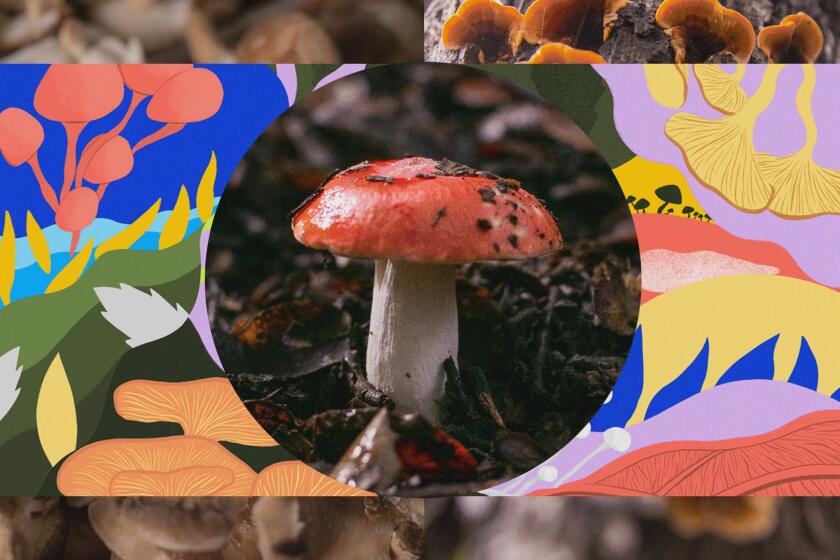
Mushrooms are everywhere. Here’s how to forage, eat and grow the mighty fungi in L.A.
While interest in magic mushrooms, or psilocybin, is driving renewed cultural interest in mushrooms, non-psychedelic fungi are also capturing our attention.
Feb. 1, 2023
So, yeah, the ride was well worth the ticket price for me. And here are several reasons why it might be worth it for you too.
1. It’s totally legal
This is probably the biggest upside of taking a technodelic trip. Even if you go to a place where psilocybin has been decriminalized under state (or city) law, its status as a Schedule 1 drug at the federal level will make it a nonstarter for many people. (And tripping while keeping one eye open for the man isn’t exactly relaxing.) That’s not an issue with digital psychedelics. Unless you happen to live somewhere where music, pulsing lights and vibrating massage tables are against the law — in which case you’ve got more problems than psychedelics can solve.
2. $249 is the ceiling — not the floor
The price I paid was for one of the more expensive experiences: a 60-minute session on the waterbed-like Wavetable. Also on offer are half-hour sessions with the same set-up (for $149) and a couple of options that swap out the squishy layer of mineral-heavy liquid for a vibrating massage table (one hour for $99, a half-hour for $59). That’s not including any potential first-timer discounts like the promo code that shaved $50 off my maiden voyage.
The cost of a session could drop all the way to zero if you’re a qualifying military veteran. According to Chia, since it opened last year, the center has provided free treatments to 250 veterans and their families and discounted services to another 50. (Interested veterans should reach out to the Reality Center through its website for additional information.)
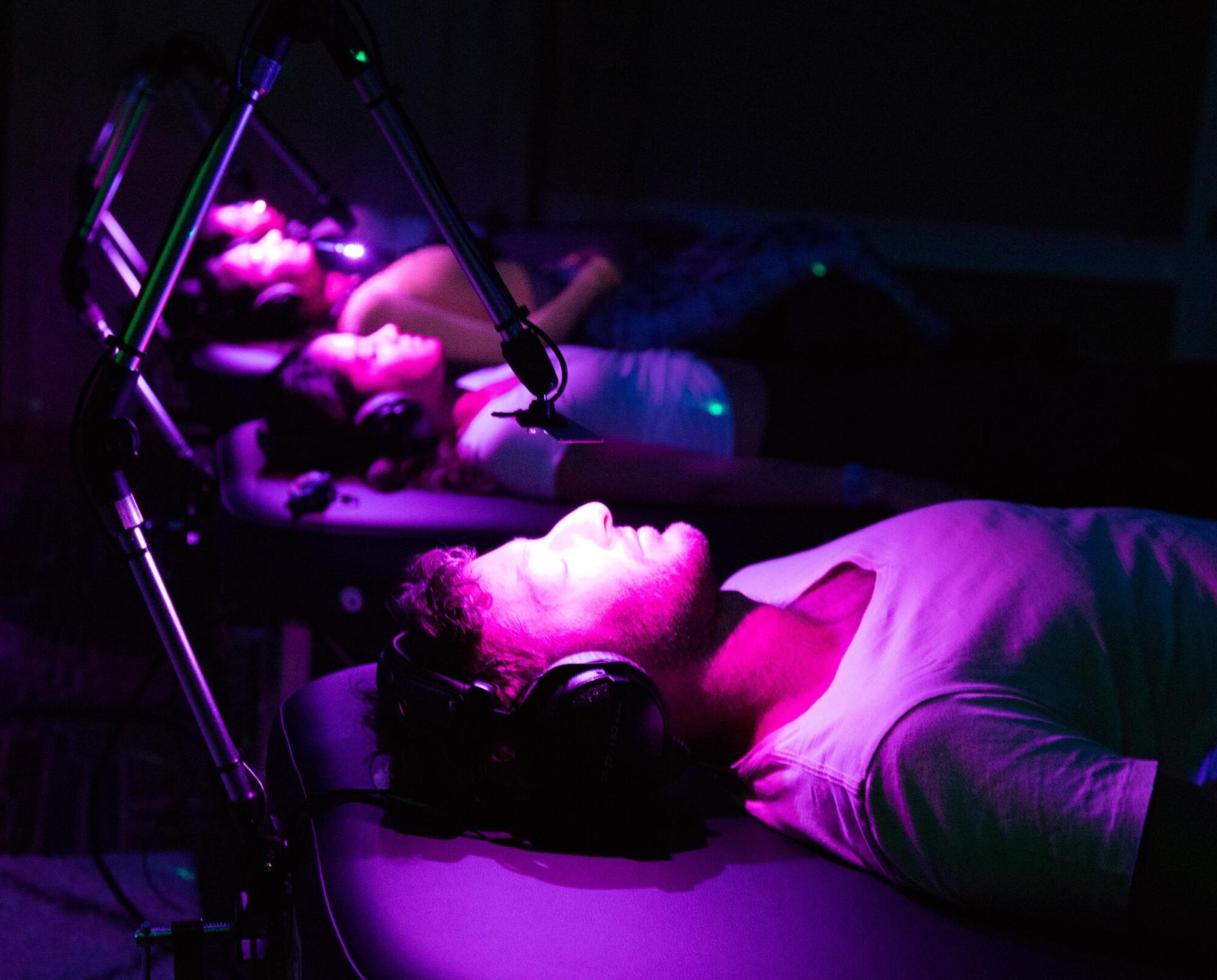
3. It’s super-convenient
The length of a drug-induced trip depends on a lot of factors. If you ingest magic mushrooms, you’re essentially booking a four- to six-hour flight with some lingering effects that can be felt long after that. When you go the digital route, an hourlong session is just that, making it possible for overscheduled Angelenos to wedge this approach to sensory wellness into their lives as easily as booking a massage or taking a yoga class. (The day I visited the center, one of the foursome I arrived with at 11 a.m. said: “I’ve got to be somewhere at quarter of 12, will that be OK?” It absolutely was.)
4. It can be a real trip
I was surprised that the digital trip felt so much like the analog ones I remembered from my college days. Most familiar were the trippy visuals (though here through closed eyes instead of open ones) and the midtrip epiphany, the realization that we’re insignificant specks of dust and integral parts of the great cosmic game plan at the same time.
5. Consider it preflight for a deeper dive
Doubleblind editor in chief Hartman said digital psychedelics — not just the treatments offered at the Reality Center but also virtual reality and augmented reality experiences in the space — also can be valuable for otherwise unprepared first-time psychonauts.
“I think for sure what they can do is give people a sense of what the sensorial experience of being on a psychedelic might be like,” Hartman said. “Specifically when it comes to visuals. If you haven’t done a psychedelic in which you’ve had a strong visual experience, it’s very hard to understand what that’s like — it can be profound and it can be overwhelming.” She explained that the kind of drug-free drug trips served up by the Reality Center can give people an eye-opening sense of what they’re in for if and when they embark on an old-school psychedelic trip.
6. The bottom line
Because the pop-culture ascendancy of the magic mushroom is all but assured (another bill to decriminalize psylocybin in California was introduced late last year), the Reality Center’s biggest value may be that it’s not just giving us a glimpse inside ourselves but at the future too.
More to Read
The longest, strangest trip: some psychedelic drug users are stuck with unwelcome highs.
April 30, 2024

Kratom products have gone unregulated in California, unnerving both fans and critics
April 29, 2024

Pot shops owed millions in taxes. So, California sold their bongs and pipes, and made $2,075
Feb. 27, 2024
Sign up for our L.A. Times Plants newsletter
At the start of each month, get a roundup of upcoming plant-related activities and events in Southern California, along with links to tips and articles you may have missed.
You may occasionally receive promotional content from the Los Angeles Times.

Senior features writer Adam Tschorn is a former small-town newspaper editor, game-show question-and-answer man and fashion scribe who joined the Los Angeles Times in 2007. He currently covers a wide range of pop-culture topics with a focus on cannabis culture. Holding a B.A. in philosophy and an M.A. in journalism, he feels perfectly suited to looking at things, asking “why?” and writing down the answers.
More From the Los Angeles Times

Entertainment & Arts
For Anne Hathaway, going five years without booze is a bigger milestone than ‘middle age’

Science & Medicine
To save Black lives, panel urges regular mammograms for all women ages 40 to 74
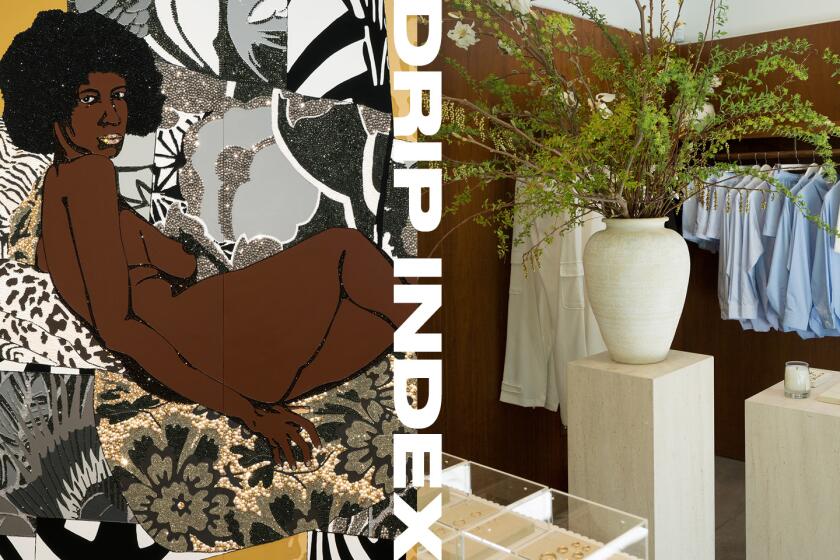
8 L.A. happenings in May to get you ready for summer

27 very L.A. ways to spend time with Mom — or not — on Mother’s Day
Thank you for visiting nature.com. You are using a browser version with limited support for CSS. To obtain the best experience, we recommend you use a more up to date browser (or turn off compatibility mode in Internet Explorer). In the meantime, to ensure continued support, we are displaying the site without styles and JavaScript.
- View all journals
- Explore content
- About the journal
- Publish with us
- Sign up for alerts
- 28 September 2022
Taking the tripping out of psychedelic medicine
- Elie Dolgin 0
Elie Dolgin is a science journalist in Somerville, Massachusetts.
You can also search for this author in PubMed Google Scholar
Psychedelic drugs can cause lasting effects on the brain. Just a single dose of these mind-altering substances can spur neurons to grow new offshoots called dendritic trees and branches that engage with their neighbours, creating elaborate networks of interconnected brain cells. This rewiring of neural circuitry helps to boost mood, combat depression and increase overall feelings of wellness. It can happen within days, and the benefits can last for months.
Access options
Access Nature and 54 other Nature Portfolio journals
Get Nature+, our best-value online-access subscription
24,99 € / 30 days
cancel any time
Subscribe to this journal
Receive 51 print issues and online access
185,98 € per year
only 3,65 € per issue
Rent or buy this article
Prices vary by article type
Prices may be subject to local taxes which are calculated during checkout
Nature 609 , S80-S82 (2022)
doi: https://doi.org/10.1038/d41586-022-02869-4
This article is part of Nature Outlook: Psychedelic medicine , an editorially independent supplement produced with the financial support of third parties. About this content .
Ly, C. et al. Cell Rep. 23 , 3170–3182 (2018).
Article PubMed Google Scholar
Dunlap, L. E. et al. J. Med. Chem. 63 , 1142–1155 (2020).
Cameron, L. P. et al. Nature 589 , 474–479 (2021).
Kaplan, A. L. et al. Nature https://doi.org/10.1038/s41586-022-05258-z (2022).
Article Google Scholar
Cao, D. et al. Science 375 , 403–411 (2022).
Dong, C. et al. Cell 184 , 2779–2792 (2021).
Davoudian, P. A., Shao, L.-X. & Kwan, A. C. Preprint at bioRxiv https://doi.org/10.1101/2022.03.18.484437 (2022).
de la Fuente Revenga, M. et al. Cell Rep. 37 , 109836 (2021).
Download references
Related Articles

Sponsor feature: Why regulators say now is the time to explore psychedelics
- Drug discovery
- Psychiatric disorders

Plastic pollution: three numbers that support a crackdown
News Explainer 24 APR 24

Refining the impact of genetic evidence on clinical success
Analysis 17 APR 24

Obesity drugs aren’t always forever. What happens when you quit?
News Feature 16 APR 24

Targeting RNA opens therapeutic avenues for Timothy syndrome
News & Views 24 APR 24

The rise of eco-anxiety: scientists wake up to the mental-health toll of climate change
News Feature 10 APR 24
Use fines from EU social-media act to fund research on adolescent mental health
Correspondence 09 APR 24

Rwanda 30 years on: understanding the horror of genocide
Editorial 09 APR 24

After the genocide: what scientists are learning from Rwanda
News Feature 05 APR 24
Call for postdoctoral fellows in Molecular Medicine, Nordic EMBL Partnership for Molecular Medicine
The Nordic EMBL Partnership is seeking postdoctoral fellows for collaborative projects in molecular medicine through the first NORPOD call.
Helsinki, Finland
Nordic EMBL Partnership for Molecular Medicine
Associate or Senior Editor (microbial genetics, evolution, and epidemiology)
we’re seeking an editor who has a critical eye, a deep understanding of their subject and interests beyond, and who can think on their feet.
London, New York, Philadelphia or Pune – Hybrid working model.
Springer Nature Ltd
Description test
Berlin (DE)
Springer Nature Group
Postdoctoral Associate- Molecular Cell Biology
Houston, Texas (US)
Baylor College of Medicine (BCM)
Associate or Senior Editor, Communications Medicine
Job Title: Associate or Senior Editor, Communications Medicine Location: Philadelphia, New York, Jersey City, Washington DC (Hybrid Working) Closin...
Jersey City, New Jersey
Sign up for the Nature Briefing newsletter — what matters in science, free to your inbox daily.
Quick links
- Explore articles by subject
- Guide to authors
- Editorial policies
How to Survive a Bad Trip, According to a Psychedelic Therapist
How to set an intention for your drug trip.
Dr Andrea Jungaberle.
At-Home Genetic Testing Can’t Tell You If You’re Going to Have a Bad Trip
Psychedelic use on the rise as gen z seeks to ‘enhance connectedness’, tripping on your lunch break: inside the rise of casual dmt use, is it possible to create an ethical psychedelics company, one email. one story. every week. sign up for the vice newsletter..
By signing up, you agree to the Terms of Use and Privacy Policy & to receive electronic communications from Vice Media Group, which may include marketing promotions, advertisements and sponsored content.
- Alzheimer's disease & dementia
- Arthritis & Rheumatism
- Attention deficit disorders
- Autism spectrum disorders
- Biomedical technology
- Diseases, Conditions, Syndromes
- Endocrinology & Metabolism
- Gastroenterology
- Gerontology & Geriatrics
- Health informatics
- Inflammatory disorders
- Medical economics
- Medical research
- Medications
- Neuroscience
- Obstetrics & gynaecology
- Oncology & Cancer
- Ophthalmology
- Overweight & Obesity
- Parkinson's & Movement disorders
- Psychology & Psychiatry
- Radiology & Imaging
- Sleep disorders
- Sports medicine & Kinesiology
- Vaccination
- Breast cancer
- Cardiovascular disease
- Chronic obstructive pulmonary disease
- Colon cancer
- Coronary artery disease
- Heart attack
- Heart disease
- High blood pressure
- Kidney disease
- Lung cancer
- Multiple sclerosis
- Myocardial infarction
- Ovarian cancer
- Post traumatic stress disorder
- Rheumatoid arthritis
- Schizophrenia
- Skin cancer
- Type 2 diabetes
- Full List »
share this!
December 20, 2023
This article has been reviewed according to Science X's editorial process and policies . Editors have highlighted the following attributes while ensuring the content's credibility:
fact-checked
peer-reviewed publication
trusted source
Potentially harmful 'trip-killers' to cut short 'bad' drug trips, emerging concern, warn doctors
by British Medical Journal
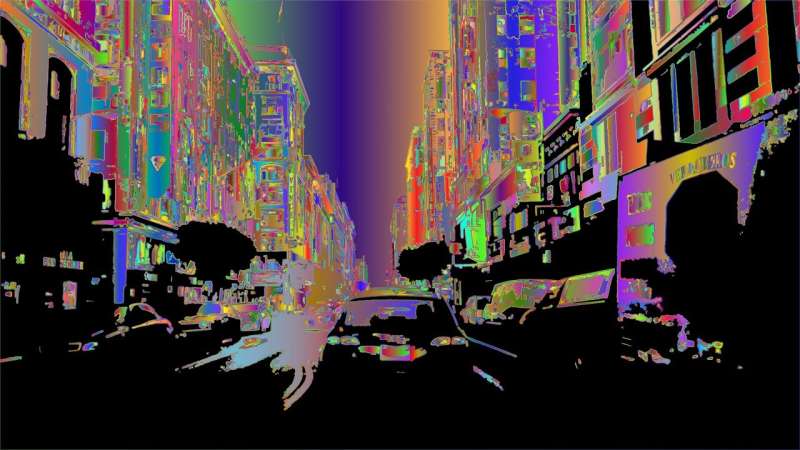
The use of potentially harmful 'trip-killers' to cut short 'bad drug trips' after taking psychedelics, such as LSD or magic mushrooms, is an emerging concern, warn doctors in a research letter, published online in Emergency Medicine Journal.
Their analysis of relevant threads on the social media platform Reddit, shows that drugs such as benzodiazepines (sedatives) and antipsychotics are the options most frequently recommended, but warnings about their potential side effects are rarely included, they highlight.
The intensity of a psychedelic drug trip can cause distress, agitation, and even psychosis, point out the authors, citing recent research indicating that more than 8% of drug-related attendances at European emergency care departments involve psychedelic drugs .
And this proportion may very well increase as the clinical use of these agents expands, they suggest.
One of the ways to cut short, or lessen the intensity of, a bad trip and avoid potentially requiring hospital treatment, is to take additional mind altering drugs, dubbed 'trip-killers.'
Although not new, this option has gained much greater traction on social media in recent years, note the authors, who did a systematic keyword search of Reddit, looking for relevant threads in English to gain a better understanding of trip-killer use.
They found 128 threads created between 2015 and 2023, yielding a total of 709 posts.
Top of the league table, with 440 recommendations, amounting to nearly half (46%) of all the trip-killers mentioned in posts, were various benzodiazepines, followed by several different antipsychotics (171;18%).
One in 10 recommendations were for antidepressants, while one in 20 were for alcohol. Opioids, antihistamines, herbal remedies , such as camomile and valerian, and prescribed sleeping pills, attracted 3% each. Cannabis and cannabidiol each took 2% of the vote share.
Trip-killers were mostly discussed in reference to countering the effects of LSD (235 recommendations), magic mushrooms (143), and MDMA, popularly known as ecstasy (21).
Only 58 posts mentioned potentially harmful side effects.
"The popularity of benzodiazepines raises concerns," write the authors. "Benzodiazepines are addictive and have been repeatedly implicated in overdose deaths. The doses described on Reddit risk over-sedation, hypotension [ low blood pressure ], and respiratory depression [stopping breathing or shallow breathing]," they point out.
Doses of one of the recommended antipsychotics, quetiapine, were also high (25–600 mg), they note, with only a few posts differentiating between fast and slower release formulations.
"Information on trip-killers isn't available through drug advice services, despite the probable risks they pose," highlight the authors.
Explore further
Feedback to editors

Closing the US/Mexico border during COVID-19 increased HIV transmission, study finds
11 minutes ago

Cardiologists train large AI model to assess heart structure, function
14 minutes ago

Deep-learning decoding for a noninvasive brain-computer interface
22 minutes ago

Study finds network of inflammatory molecules may act as biomarker for risk of future cerebrovascular disease
4 hours ago

Brief anger may impair blood vessel function, says new research

Popular teenagers sleep less than their peers, study finds
9 hours ago

Patients with rheumatoid arthritis have unique and complex autoantibody patterns, study reveals

Study gauges effectiveness of COVID-19 burden mitigation policies
16 hours ago

Neuroscientists discover two specific brain differences linked to how brains respond during tasks

An electrifying discovery may help doctors deliver more effective gene therapies
Related stories.

Risk of overdose higher when opioid agonists are prescribed with other medicines
Aug 3, 2023
Opioid analgesics reduce use of antipsychotics in persons with Alzheimer's disease
Mar 26, 2018

Benzodiazepines may decrease mortality in congestive heart failure
Jan 24, 2019

Antipsychotic withdrawal—an unrecognized and misdiagnosed problem
Jan 9, 2023

Benzodiazepines associated with increased risk of Alzheimer's disease
Aug 13, 2018

Withdrawal syndrome following discontinuation of psychotropic drugs: What we know
Sep 25, 2020
Recommended for you

Treatment-related pain may be 'socially contagious'
18 hours ago

A better COVID treatment for the immunocompromised? Researchers create a non-toxic potential alternative to Paxlovid
23 hours ago

What goal-directed learning is and why it's important for adolescents to learn from their actions
22 hours ago

Omega-6 fatty acids could cut risk of bipolar disorder, study suggests
20 hours ago

Staying fit boosts kids' mental health
Let us know if there is a problem with our content.
Use this form if you have come across a typo, inaccuracy or would like to send an edit request for the content on this page. For general inquiries, please use our contact form . For general feedback, use the public comments section below (please adhere to guidelines ).
Please select the most appropriate category to facilitate processing of your request
Thank you for taking time to provide your feedback to the editors.
Your feedback is important to us. However, we do not guarantee individual replies due to the high volume of messages.

E-mail the story
Your email address is used only to let the recipient know who sent the email. Neither your address nor the recipient's address will be used for any other purpose. The information you enter will appear in your e-mail message and is not retained by Medical Xpress in any form.
Newsletter sign up
Get weekly and/or daily updates delivered to your inbox. You can unsubscribe at any time and we'll never share your details to third parties.
More information Privacy policy
Donate and enjoy an ad-free experience
We keep our content available to everyone. Consider supporting Science X's mission by getting a premium account.
E-mail newsletter
Let’s Talk About Bad Trips: Separating Difficult from Traumatic
Bad trips are a polarizing concept in psychedelics. acknowledging that they exist - and knowing how to work with them - can be healing..
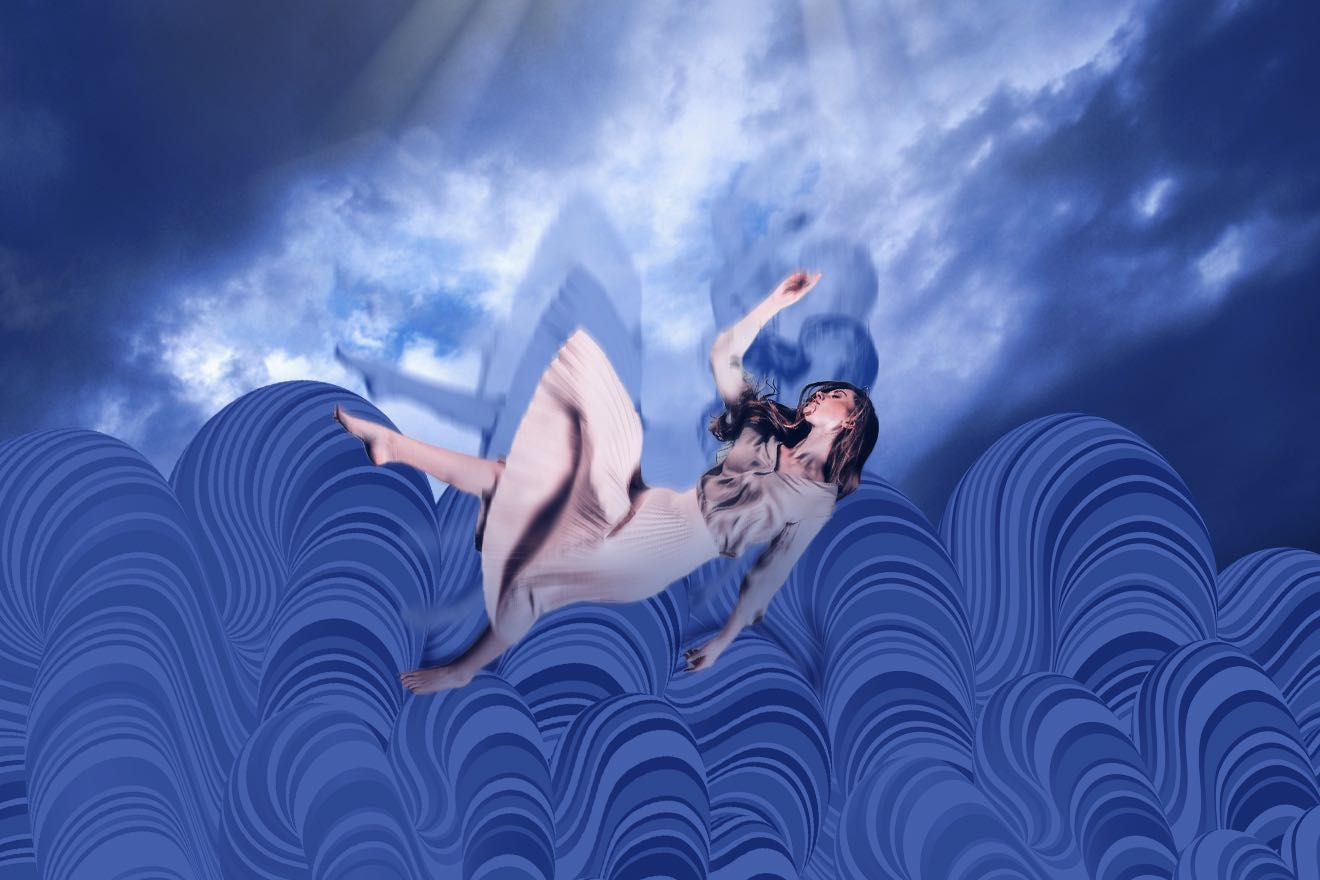
Want to start a war on social media? Post something like this: “Bad trips exist.”
As somebody who has worked in the psychedelic space for years now and has supported many, many people during their trips, it’s time to come out of the closet and say it: people can be harmed by psychedelics, and bad trips exist.
But allow me to define the term “ bad trip ,” because the vague phrase has become too polarized to be meaningful.
When I talk about bad trips, I’m not talking about the harrowing, painful journeys to the underworld from which we return raw and exhausted, with some important piece of our healing work having been catalyzed.
When I talk about bad trips, I mean the trips that register in the body as a trauma or injury to the nervous system. And that is not , in fact, the same thing as a difficult trip.
What happens when we deny this truth is that we inadvertently alienate those who have had traumatic or harmful experiences. These people have endured a trauma, and are now being told that they have not.
So let’s talk about traumatic trips: The psychedelic experiences that leave us injured. Thankfully, they are rare.
I’m not just speaking from my observations as a clinician, but also from personal experience: I had a traumatic psychedelic experience on ayahuasca many years ago. I was decidedly “not okay” afterwards and required much time and support to recover.
Despite the shock and injury to my nervous system, I eventually used psychedelics again. In fact, in the eight or so years that have passed since the traumatic trip, I have openly supported the legalization of psychedelics, and have built two businesses centered around empowering people to heal with psychedelics.
I have also taken sabbaticals from my practice to work in other countries as a psychedelic facilitator. I am now a lead educator in the country’s first training program for psilocybin facilitators to be licensed by Oregon’s Higher Education Coordinating Commission (HECC). I’m a ketamine prescriber, and I train other prescribers in the use of ketamine for treating chronic pain and mood disorders. I lead and run intensive healing retreats. I’ve also taken my own fair share of mind altering substances in a variety of sets, settings, and time zones.
All of which is to say: I am no newcomer to the world of psychedelics.
And yet I cannot swallow the field’s echo-chamber-like mantra that “there is no such thing as a bad trip .” In fact, I find the rabidity with which some of my fellow cosmonauts deny the existence of bad trips to be rather disconcerting. In the more-than-one heated debate I’ve had about this topic, I’ve noticed certain patterns – or myths, if you will – around the topic of traumatic trips. I address each one here.
Myth: Bad Trips Only Happen When the Set and Setting Are Improper
If the word “only” didn’t appear in the above sentence, it would be true. In my experience in working with hundreds of patients who have used psychedelics – and in administering psychedelics myself – I’ll say that the vast majority of traumatic trips happen when the environment is not safe, calm, and supportive.
When we talk about set and setting in psychedelic harm reduction , we mean two things: (1) the person’s mindset when they took the drug, and (2) their physical environment. If somebody had just had an argument with their spouse before taking LSD, for example, that’s their set. If they were at a noisy, crowded music festival, that’s the setting. Perhaps unsurprisingly, the majority of bad trips happen when individuals on drugs feel overwhelmed in a noisy, chaotic setting like that of a concert or party. Drug-drug interactions are also often at play during difficult trips, for example, when people combine alcohol with psychedelics.
When people insist a little too strongly that, “There’s no such thing as a bad trip, if the set and setting are right,” I feel uneasy. It’s perhaps like asking a rape survivor, “Yeah, but what were you wearing?” (If you think the analogy of a bad trip and rape is too far of a reach, you luckily have never had a traumatic trip.)
There are other factors in psychedelic harm reduction that influence the outcomes. These include the substance being used, the dosage taken, and the people you’re with.

The night of my traumatic trip was the third of a three-night ayahuasca ceremony. I was there with my then-partner. I liked the other people attending. I trusted the facilitators completely and knew they were well trained and highly esteemed by their colleagues. The medicine was pure. The environment was soothing and well contained. The music was beautiful. The first half of the third ceremony was trippy, strange, and lovely.
After I drank my second dose of the brew, however, I was decidedly NOT OKAY. I will not describe the experience here, but I will say two things about it: (1) I felt like my nervous system was being gang raped, repeatedly, and (2) I can now absolutely understand why people with psychosis sometimes choose to die by suicide.
The facilitators of the circle took care of me, pulling me out of the ceremony space and letting me try to calm down outside. Somebody stayed with me at all times until I vomited up the salt water they gave me to drink.
There’s one factor of harm reduction we don’t discuss enough: dose. It’s possible that the second cup of ayahuasca I drank that night contained more voltage than my nervous system could handle – that it was too much, too fast, and too hard for me.
The Influence of Neuroticism
Aside from the environment, another factor that can predict bad trip potential is neuroticism. Neuroticism is one of the “Big Five” traits thought to collectively form the full picture of personality.
People who score high on neuroticism tend to overthink things, typically have a hard time relaxing, and may feel irritated in noisy settings or stressful situations. These folks are often described as “high strung.”
At least two studies have shown that people who score high on neuroticism scales are more likely to have a challenging psychedelic trip than those who score lower. [1] , [2] The theory behind this is that if a neurotic’s negative thoughts or feelings arise during a psychedelic trip, the person might get pulled into an amplification spiral of their own negativity.
But does that mean it’s somebody’s fault that if they tend towards neurosis and they have a bad trip? Aren’t psychedelics supposed to help heal negativity? What does it mean that the same drugs that help soothe negative thoughts and feelings can also make us feel worse? (Let a neurotic chew on that one.)
Once again, we could very easily slip into the territory of victim blaming if we are not mindful.
While writing this article, I took the Big Five Personality Test online. I scored in a higher-than-average percentile for negative emotionality (neuroticism). That may explain why grumpy cat is one of my heroes and why my friend Greg refers to me as “a female Larry David.” It could also explain why I’m one of the unlucky few who have had a traumatic psychedelic trip. (Side note: I also scored pretty high on open mindedness, so that could explain why got into psychedelics in the first place.)
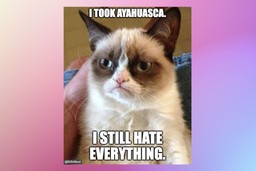
Myth: Bad Trips Are Actually Just Difficult Experiences That Haven’t Been Integrated
I continue to stay in this field because traumatic trips are, indeed, exceedingly rare, and because the healing gains people typically experience from psychedelics are unparalleled by any other intervention I’ve found.
Working regularly with patients in non-ordinary states of consciousness, I see that the most challenging experiences are often the most rewarding. Drawing from my previous experiences in volunteering with the Zendo Project and White Bird , I teach my students the tenants of “trip sitting.”
As one of the Zendo principles states: difficult is not necessarily bad. Note that the phrase is not “difficult is not bad,” but rather, “ difficult is not necessarily bad. ” In other words, difficult can sometimes be bad.
Another layer to this argument is that if you wait long enough, the bad experience will prove itself to be good. This does, indeed, happen to many people after their challenging journeys. Yet there is a difference between suggesting this to a bad trip survivor and insisting that “everyone gets the trip they need.”
Many of my new-age peers have become allergic to the word “bad,” especially within the context of bad trips. “Is anything really bad?” I’m often asked. The argument here, as I understand it, is that with every cloud there comes a silver lining, and that silver lining might just hold a very valuable teaching for us.
I admit that my own traumatic trip gave me a lesson: It taught me that there is indeed such a thing as a bad trip. Another gift was that my bad trip helped me to better understand, validate, and support others who have been harmed by psychedelics. Another lesson was this: my bad trip was an amplifier of the toxic positivity that I see running rampant in the psychedelic field.
In fact, a patient once confessed to me, “I’m just so mad at her” – her being ayahuasca – “but everyone in the group is so in love with Great Grandmother that if I say one bad thing about her, it’ll be like heresy.” I noticed that he was clenching his jaw and only breathing into the upper part of his chest. I leaned forward, looked him in the eye, and said: “Tell me exactly what you think about that bitch – you won’t offend me.”
By the end of the hour, he had raged, wept, and laughed. His breath was reaching his abdomen and his jaw was relaxed. The client messaged me some days later, saying, “That was so healing for me just to be heard, to be able to say mean things without being afraid somebody would cancel me. Thank you.”
Perhaps for this client, “the medicine” was to be heard without anybody trying to stop him from expressing anger. Maybe the bad trip was just part of the arc that took him to that finale. I don’t know.
Myth: There’s No Such Thing as Bad
There’s that old story about the Zen master, whose son got a new horse. “What good luck!” The neighbors said. “We’ll see,” said the master. One day the son was thrown from the horse and broke his leg. “How terrible!” Said the neighbors. “We’ll see,” said the master. Then the country went to war, and the army came to recruit soldiers. Because the young man’s leg was broken, they army didn’t take him to battle. “How good!” said the neighbors. “We’ll see,” said the Zen master. Perhaps there is no good or bad.
What I’ve always found lacking in this story about the Zen master was the voice of his son – the one who actually fell from the horse.
Is a bad trip like falling from a horse? It absolutely can be. Yet something about the “you just haven’t integrated it yet, there’s gold there” argument feels like a dismissive bypass. Let us consider other situations in which we could apply such a statement:
- After getting food poisoning and vomiting for hours
- After taking penicillin and breaking out in a full body rash
- After going on a horrible date
- After surviving a sexual assault
- After your child has been diagnosed with a life-threatening illness
- After losing a loved one to cancer
- After surviving a terrible accident that has resulted in disability
- After your cat has been run over by a car
- After losing a house to foreclosure
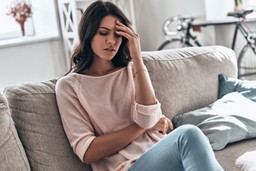
Would we really tell the people in the above hypothetical situations that there was no such thing as bad shellfish? No such thing as a bad drug reaction or a bad date? No such thing as rape? No such thing as a bad diagnosis, a bad prognosis? Or how about just a bad day? Or something as non-threatening as a bad movie, a bad haircut, or a bad parking job? Would we really tell somebody whose child just died to avoid using the word “bad” to describe her condition?
Perhaps it is true that none of these things are bad, and that all of them are blessings in disguise. But would we really get righteous about it on social media, the way some of us do about denying bad trips?
And what’s so bad about saying “bad,” anyway? Must everything truly be a blessing? (The neurotic writing this article needs to know.)
I’d also like to share the story of Becks. Becks was a 24-year-old female patient of mine with anorexia nervosa who did MDMA-assisted psychotherapy to heal from PTSD (post-traumatic stress disorder) rooted in childhood sexual abuse.
In a follow-up visit, Becks told me that the MDMA-assisted therapy session (done with an underground provider) had done wonders for her. She was getting much more mileage out of her weekly therapy sessions. She was now remembering things she had repressed previously, and she was able to stay present when the memories arose.
Becks had also forgiven herself. She explained that without realizing it, she had blamed herself for what happened to her when she was a child, punishing herself through self-denigrating thoughts, food restriction, and high-risk drinking. Her MDMA-assisted therapy session helped her identify this pattern and realize that she didn’t deserve the blame or the punishment. Having forgiven herself, Becks was now sleeping better at night, eating when she was hungry, and avoiding alcohol. Clearly, much healing had occurred for her.
Yet Becks felt discouraged and worried. “I don’t think I’m doing it right,” she told me while pulling at the rings on her fingers.
“Why’s that?” I asked.
“Well,” she explained, “I know I’m supposed to get to this place where I feel like the trauma was a blessing – and that hasn’t happened.”
“You think you’re supposed to get to a place where you think that being repeatedly molested as a child is a blessing? ” I asked her.
“Yes,” she said with a defeated sigh as she looked at her shoes.
“Where’d you get that idea?”
Her head snapped up to look at me, breathless, huge-eyed. And then she burst out laughing. The laughter turned to tears. She sobbed and babbled something about a podcast she’d heard. Then she laughed some more. Her face lit up and the color returned to her cheeks.
“Becks, was being molested by your stepbrother every night a blessing?” I asked her.
“No, it was a fucking horrible nightmare that I wouldn’t wish on my worst enemy,” she declared.
“Okay,” I said, “and is it possible that it was a fucking horrible nightmare and that you still get to heal and have a happy adult life starting right now?” I asked.
“ Fuck yeah,” she said. And the look on her face told me she believed it.
(This, by the way, is what happens when you go to a doctor who scores high on neuroticism scales: We acknowledge and celebrate that life might be a fucked up mess sometimes, and that we can still heal even if we don’t buy into toxic positivity.)
(Also: I do have patients who come to see their traumas as gifts. It truly is a powerful and important step in their healing. But let’s not assume that healing cannot happen in other forms. Everyone’s path is different and valid.)
Myth: Talking About Bad Trips Is Going to Harm the Psychedelic Movement
On the day I graduated from medical school, I took an oath to First, Do No Harm . Sometimes, First, Do No Harm means doing the uncomfortable thing or saying what others don’t want to hear. In this case, it means acknowledging that there are risks to using psychedelic substances, and a traumatic trip is one of those risks.
Every therapy, every medicine, every experience comes with risks and benefits. One risk of taking vitamin C is that too much can cause diarrhea. One risk of antibiotics is that they can lead to vaginal yeast infections. One risk of using acetaminophen (paracetamol) is that it’s hard on the liver. One risk of eating a vegan diet is that it can deplete vitamin B12 stores and subsequently trigger depression. One risk of a life-saving surgery is that it can result in a lethal infection. And so forth.
Psychedelic medicines also come with their risks, and the risk of a traumatic trip should be on that list. Admittedly, it should be in small letters, towards the bottom of the list, next to the words “very rare when used in therapeutic contexts.” But traumatic trips are, in fact, “a thing.” They’re part of the fine print.
As far as I know, bad trips have not been reported in any of the clinical trials on psychedelics – but keep in mind that we haven’t had too many people go through the clinical trials as compared to the number of folks doing psychedelics “in the wild.” Bad trips may have also been down-played in the trials as “dysphoria” or “agitation” by the researchers.
Are the possible risks of psychedelic medicines worth wagering for the potential benefits? The answer to that question can only be answered on a case-by-case basis – as with any intervention.
For me personally: The healing engendered by psychedelics has far outweighed and more than redeemed the harm I’ve endured. Every time I take a psychedelic medicine now, I understand that I am taking a risk, and I make the clear, informed decision to proceed – or not to proceed, depending on the circumstance.
When I advocate for the destigmatization and legalization of psychedelics, furthermore, I don’t just act out of love for the movement: I act out of love for my patients.
What’s going to injure the psychedelic movement even more than a level-headed discussion about traumatic trips is the harm that may be caused by denying them.
How to Talk to a Bad Trip Survivor
So, what should we say to a survivor of a traumatic trip? Anything but: “There’s no such thing as a bad trip.”
If somebody tells you they’ve endured a bad trip, treat them as if they’d just told you that they survived an accident, an assault, or another kind of shock. Offer them comfort and support. Listen. Don’t ask them to prove the truth of what they say happened.
Essentially: treat them as you would treat the survivor of any kind of experience that was too much, too hard, and/or too fast for their mind, body, or spirit.
Remember that the word “trauma” does not refer to the distressing event itself, but rather to the resulting emotional and neurological response. Trauma can harm a person’s sense of Self, their sense of safety, their ability to navigate relationships, and their ability to regulate their emotions. Trauma, in other words, is injury to the nervous system that ripples outward. (To be clear: Trauma does not mean simply feeling uncomfortable or offended, as some people mistakenly use it.)
Even if integration of the experience would be helpful for the survivor – and might even help them stop using the term “bad trip” to describe it – that cannot happen at the beginning. The first thing the bad trip survivor likely needs is to know that they are safe now . The nightmare has ended, and they are loved and supported by trustworthy people who care.
How can we help others feel safe? By our presence. By regulating our own breath. By listening. By letting them know that we believe them. By showing empathy. By making them soup, gifting them a massage, or offering to pick their kids up from school. By being kind.
Even if the traumatic trip was the result of poor planning, improper set and setting, or other user error, hold your tongue for now. Think of how you might react if a friend was in a terrible car accident that resulted from driving when they were overly tired.
Think of how you might respond if a child dragged a chair to the kitchen counter and climbed atop it to try and reach the off-limits cookie jar sitting high up on a shelf – only to tumble backwards and slam onto the floor. Would you shout, “Well, that’s what you get for climbing on the chair!” while the poor kiddo cried on the linoleum? I hope not. I hope you would sit by their side, hug them, and stroke their hair. Once you felt their breathing return to normal and the smile return to their face – and not a second sooner – might you ask, “Honey, remember what we said about climbing on the furniture?”
Healing From My Bad Trip
It took me almost eight years to feel like I had fully integrated my bad trip. Curiously, what helped me complete the arc from wound to health was a peyote ceremony.
What prolonged my healing was people insisting that there was no such thing as a bad trip. I heard this line in my ayahuasca circle, at psychedelic conferences, on social media, on podcasts, and in books. The experience-denying and victim-blaming made me feel angry and alone.
Another factor that delayed my full recovery was peer pressure. Buckling to the well-intentioned insistence of friends, I returned to the ayahuasca circle (and other psychedelic circles) sooner than I truly wanted to. This meant that I was taking medicines with a mindset of doubt and fear, which resulted in several dysphoric, confusing, and terrifying journeys that only compounded the injury.
I was fortunate to find a healer who believed in bad trips and who confirmed that I was not fully in my body. Through regular sessions, I was able to return. While my therapist hadn’t had much psychedelic experience herself, she at least believed me. That allowed us to start from a place of trust and not from a place of defensiveness. I also took a break from psychedelics and instead cultivated gentler, more predictable health-affirming practices like singing and going to the gym.
Years after the experience, I read about the concept of “too much, too hard, too fast” in a book about psychedelic facilitation. I felt a surge of heat rush to my face as I read the words; hot tears filled my eyes. I hadn’t made it up. It had happened to me. I wasn’t weak, or stupid, or crazy. But why was the truth so hard for other people to accept?
I’m grateful to my own stubborn will to get better – to that spark within me that keeps me seeking out people, places, and things that can help me heal, grow, and learn.
There was, indeed, some good that came from my bad trip on ayahuasca all those years ago. The seams of that horrific shroud were sewn with golden thread. I am grateful for the blessings gleaned.
I am also grateful to my unconditionally supportive family, friends, and partner, and to Grandfather Peyote for helping me weave the blessings into my life and pull back the heavy curtain.
I had a bad trip, and that’s okay.
And you know? Considering that I’m a neurotic, I’m pretty proud of myself for saying so.
Follow your Curiosity
[1] Barrett FS, Johnson MW, Griffiths RR. Neuroticism is associated with challenging experiences with psilocybin mushrooms. Pers Individ Dif. 2017 Oct 15;117:155-160. doi: 10.1016/j.paid.2017.06.004 .
[2] Petter Grahl Johnstad (2021) The Psychedelic Personality: Personality Structure and Associations in a Sample of Psychedelics Users, Journal of Psychoactive Drugs, 53:2, 97-103, DOI: 10.1080/02791072.2020.1842569
You may also be interested in:
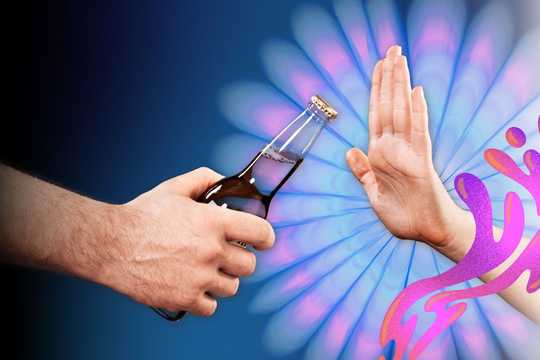
Mental Health

Trip Killers: How To Stop an Acid Trip
Occasionally, a psychedelic trip can take a turn for the worse. This group of “trip killer” drugs are used by experienced trip sitters and medical professionals to stop the trip in its tracks.
What Are Trip Killers?
1. alprazolam (xanax), 2. lorazepam (ativan), 3. diazepam (valium), 4. clonazepam (klonopin), 5. zolpidem (ambien), 6. quetiapine (seroquel), 7. olanzapine (zyprexa) , how long do trip killers take to kick in, psychedelics that have trip killers, psychedelics that don’t have trip killers, 1. are you in over your head, 2. are you or those around you at risk, 3. do you need to sober up asap, who shouldn’t use benzodiazepine-based trip killers, 1. the “bad trip”, 2. you or your trip sitter realize it’s time for a trip killer, 3. you enter “the placebo effect”, 4. the trip killer begins to take effect, 5. the trip comes to an end , 6. you feel almost sober, 1. sourcing the trip killers responsibly, 2. get the dose right, set (mindset), final word: using trip killers .
In most cases, “a bad trip” is just your mind’s way of showing you factors in your past or present life that need to be confronted and dealt with. However, in some cases, a bad trip can become nightmarish to the point that it may put yourself or others in danger.
In these situations, it may be beneficial to have some form of a trip killer on hand to get you out of the negative headspace and effectively “kill” the trip.
Let’s delve into what trip killers are, when to use them, explore the risks, and discuss what to expect when you use one halfway through a psychedelic journey.
Trip killers are substances that help mellow out or block the effects of psychedelic substances. They “bring you back to reality” when a trip takes a dark turn.
Trip killers are taken with the intent to end a psychedelic trip. There is no one substance that will help end a psychedelic experience, and not all trip killers are effective for all psychedelics — you have to use the right trip killer depending on what substance you’re using.
The most common trip killers are benzodiazepines, but other drugs, such as certain antipsychotic medications, can also be effective.
Just as it’s important to know the right dose of the psychedelic you’re using, it’s important to take the right dose of trip killers too. Some of these substances are exceptionally potent and should be taken with great care.
Trip killers are a last resort and should only be used when the effects of a bad trip start to become dangerous to oneself or others.
Ideally, people who are at risk of such an experience will be under the supervision of a trained psychedelic facilitator who can help walk the user through the challenging visions they may be receiving. In many cases, the bad trips are where most of the benefits of psychedelics derive from — so stopping them in their tracks should be avoided if possible.
Top 7 Trip Killers
By far, the most effective and commonly used trip killers are benzodiazepine drugs . We’ll look at these substances first because they offer the strongest and fastest-acting way to end a psychedelic experience.
Benzodiazepines aren’t for everyone; some people should avoid them entirely. In these cases, there are other options available (keep reading).
It’s important to note that benzodiazepines can be dangerous, especially if mixed with other sedative drugs or alcohol. They’re also notoriously addictive. Taking benzos habitually doesn’t end well for anybody.
For now, let’s take a look at the most common trip killers:
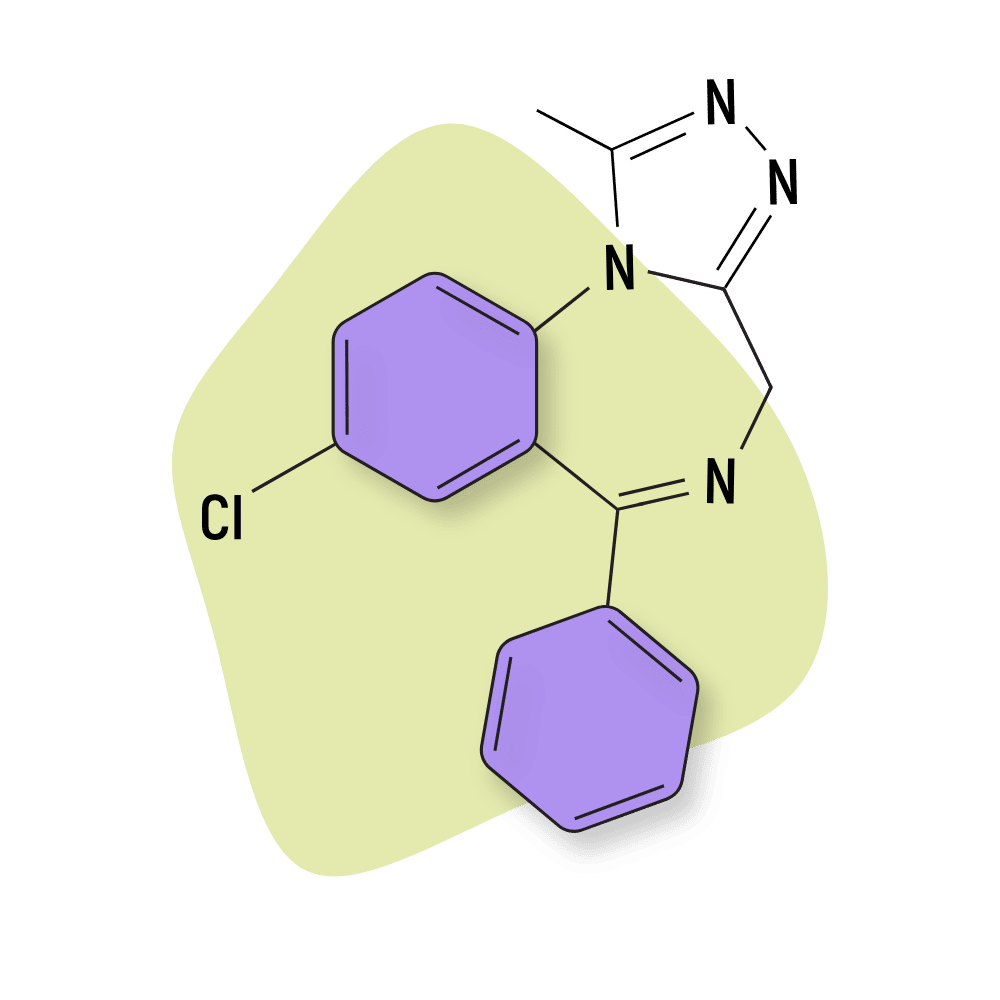
Alprazolam is one of the fastest-acting trip killers in the benzodiazepine family — but it’s also one of the shortest-lasting. The effects of Xanax, although fast-acting, only last for around four to six hours.
Xanax is a favored trip killer among psychonauts purely because of its fast-acting nature. It’s designed for people to use at the first sign of an anxiety attack to stop it in its tracks.
The effects of alprazolam start to kick in within 15 minutes or so and reach peak effects in as little as 45 minutes.
Xanax does have a habit of wiping your memory, in a sense. When consumed with other substances or at too high a dose, it can make you black out and lose all memory of the previous night.
When you consume Xanax as a trip killer, you should be prepared to lie down and get some rest. When you awake, you may have an extremely blurry memory and struggle to recall anything about the experience. This can be a positive or negative point, depending on what you want to achieve from the psychedelic trip.
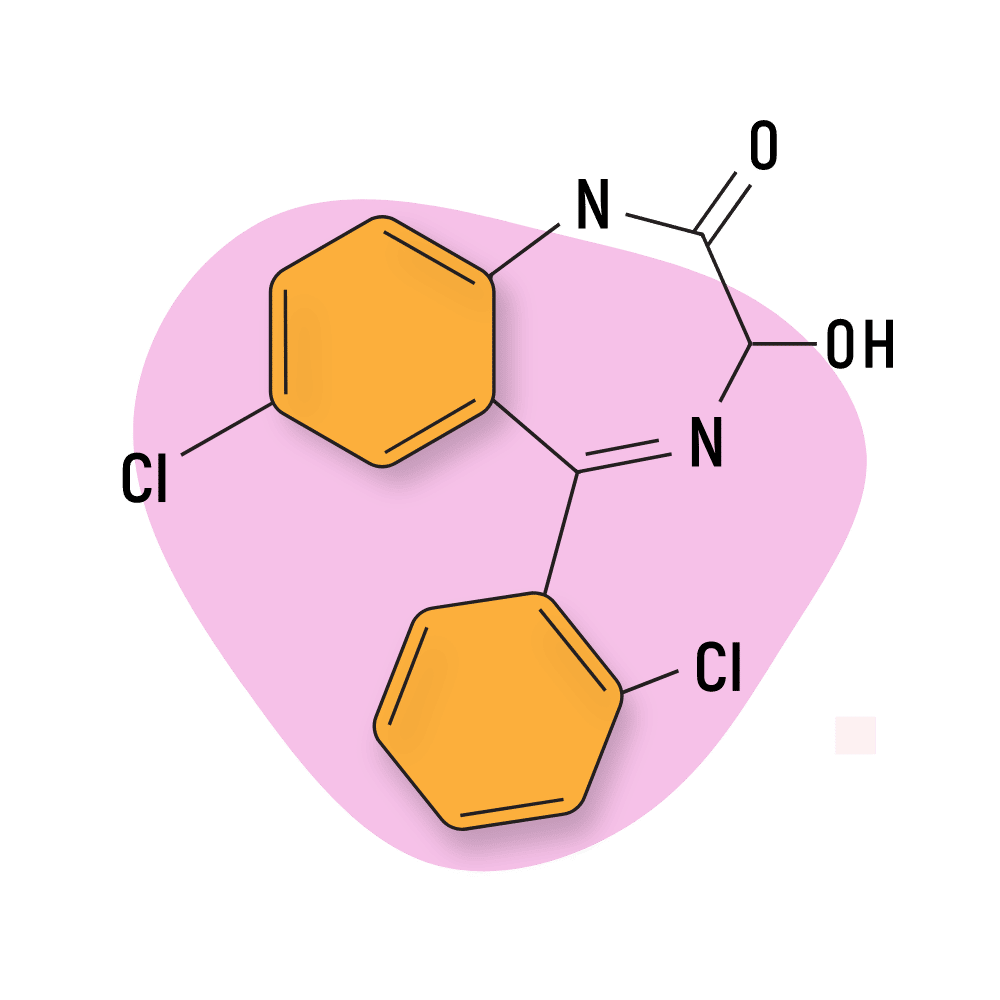
Lorazepam is considered an intermediate-acting benzodiazepine. This means it won’t kick in quite as fast as something like Xanax — but the effects last for over eight hours. This is a better option for long-lasting psychedelics, such as DOX compounds, 2CX compounds , or other amphetamine psychedelics .
Lorazepam is great for getting you out of a bad trip, but it may cause drowsiness to the point you fall asleep. This can be a plus since it allows you to rest easy after a bad experience, but it does put a complete halt on your psychedelic experience.
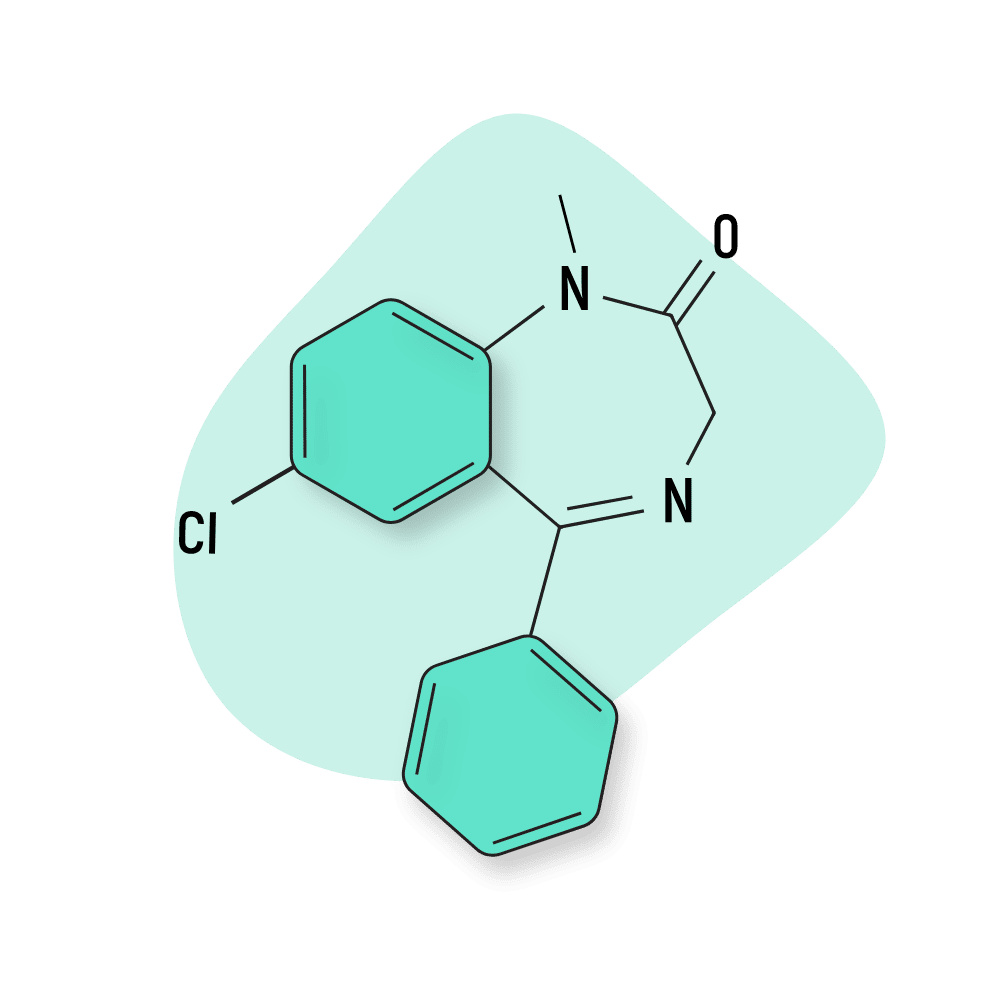
Diazepam isn’t as fast-acting as lorazepam and alprazolam, but it is one of the longest-lasting of the popular benzodiazepine trip killers. The effects of diazepam can last for over 12 hours.
It’s reported that this trip killer takes “too long” to take effect when swallowed in pill form. However, the onset of effects can be sped up significantly by chewing the drug, so it can be sublingually absorbed under the tongue.
Diazepam works great to get you out of a nightmarish thought loop, but it doesn’t have the same effect as lorazepam and alprazolam in the aspect of drowsiness. Many people report that taking diazepam during a bad trip helps them calm down without completely removing the psychedelic effects of the drug.
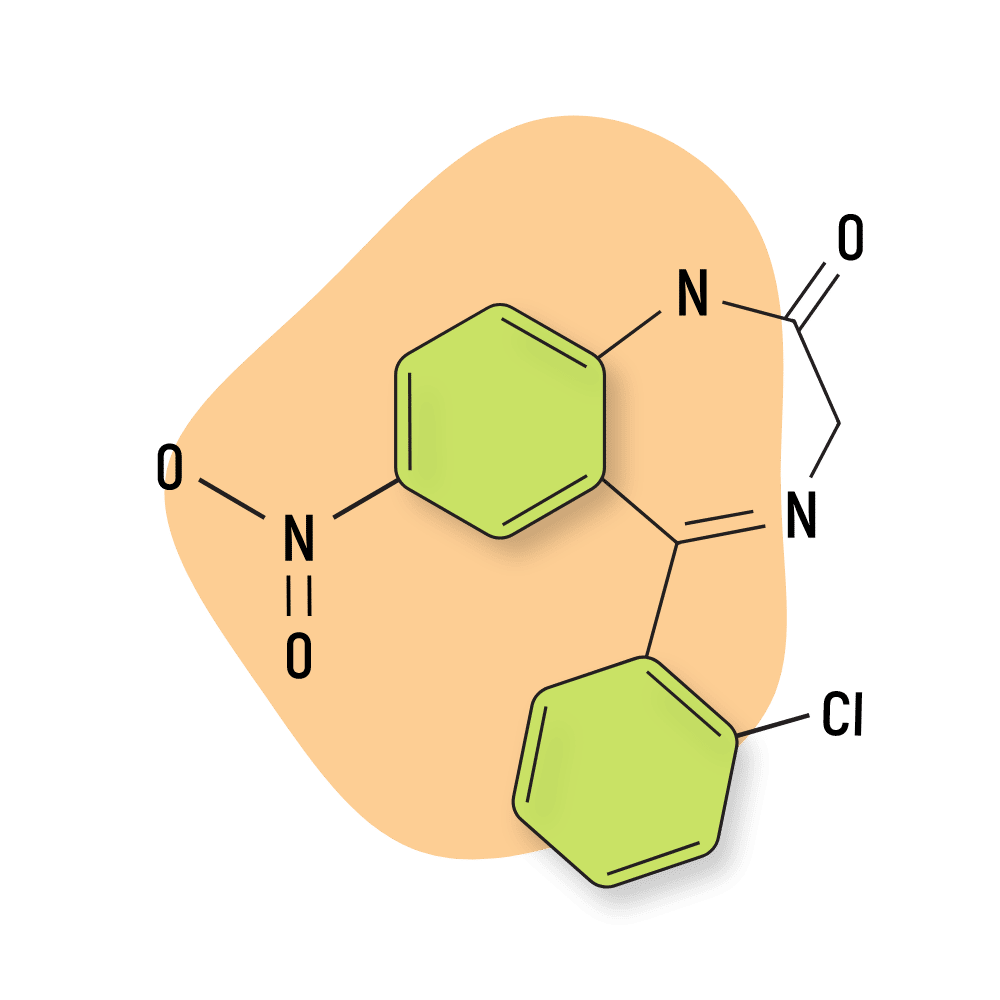
Clonazepam is considered the slowest-acting of the benzodiazepine trip killers. It can take between one and four hours after taking it to reach peak levels in the blood. Of course, this can be sped up by chewing the pill and allowing it to absorb sublingually.
Although clonazepam takes a long time to kick in, the effects can last up to 12 hours, and the half-life is also long, standing at around 40 hours — meaning it won’t be cleared from the body for a couple of days.
This is the least popular of the common benzodiazepine trip killers, but it’s often one of the easiest to get hold of (depending on where you live). Some like Klonopin for its euphoric nature, which many other benzodiazepines don’t have.
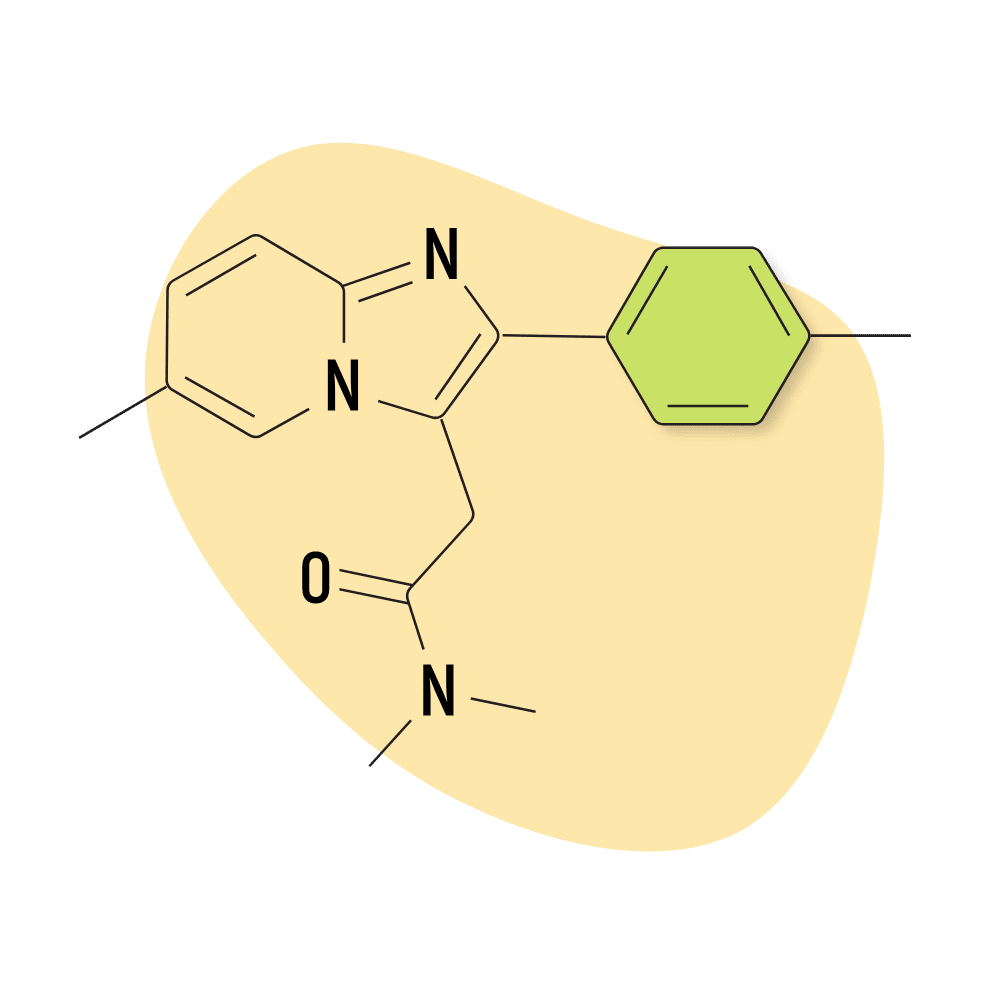
Zolpidem is classified as a Z-drug — which is a group of compounds that exert benzodiazepine-like effects but have an entirely different structure.
These drugs work in much the same way as benzos and are also considered useful as trip killers. But there’s one catch — these drugs tend to be much more sedative than their benzodiazepine cousins. People who take Ambien to stop a trip will almost always fall asleep shortly after. You may or may not remember the experience the following morning.
While Z-drugs carry a lower risk than most benzodiazepines, there’s still a great deal of risk associated with their use. Getting the dose right, avoiding mixing with other depressants, and only using if you’ve been approved by a doctor are still key elements for using these substances safely.
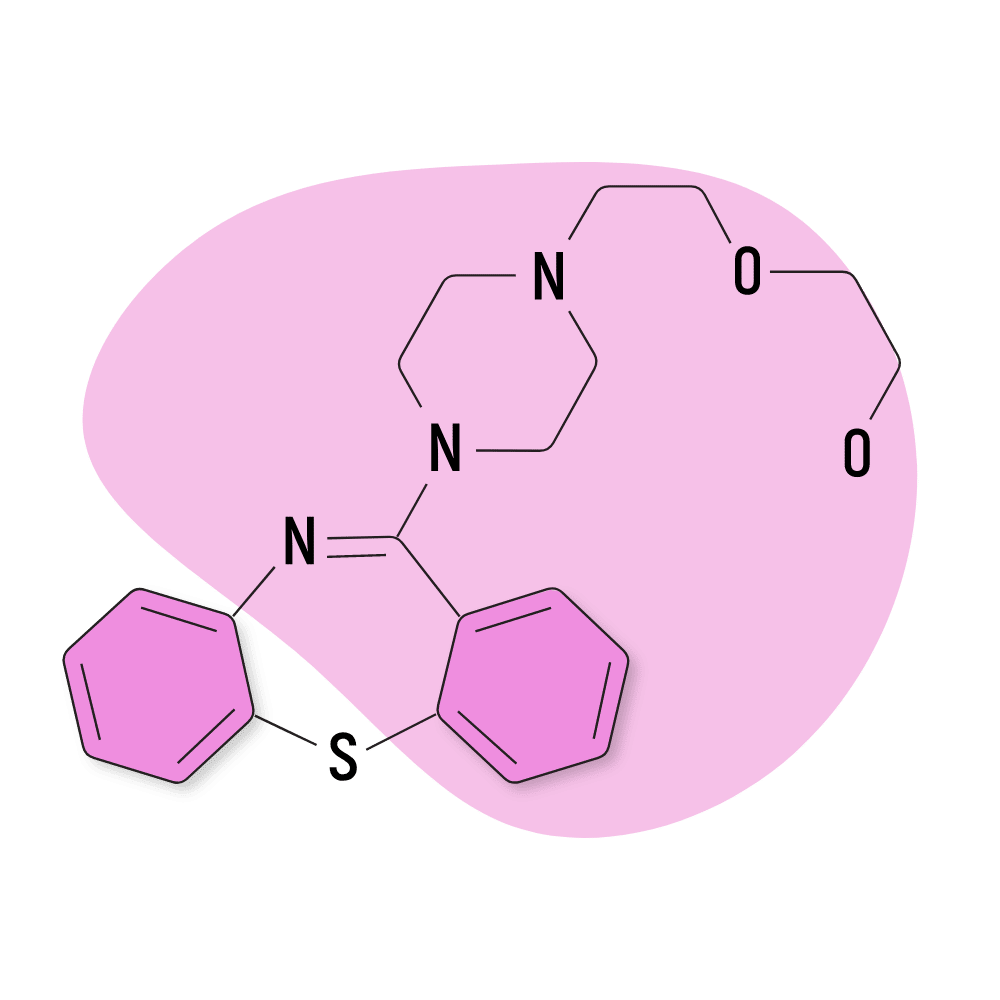
Although nowhere near as popular as benzos, another common option is antipsychotics like quetiapine (Seroquel).
Antipsychotic medications treat psychosis. People with schizophrenia, bipolar disorder, severe depression, and Alzheimer’s are often prescribed these.
Quetiapine is classified as an atypical antipsychotic. It differs from typical antipsychotics because it produces fewer extrapyramidal symptoms and has a lower risk of tardive dyskinesia. In simpler terms, it produces fewer side effects than typical antipsychotics, such as the inability to sit still, muscle contractions, tremors, and stiff muscles.
Antipsychotics are the best trip killers for people that can’t use benzodiazepines or Z-drugs.
Seroquel typically takes 20 to 60 minutes to kick in when consumed sublingually at a dose of around 25–50 mg.
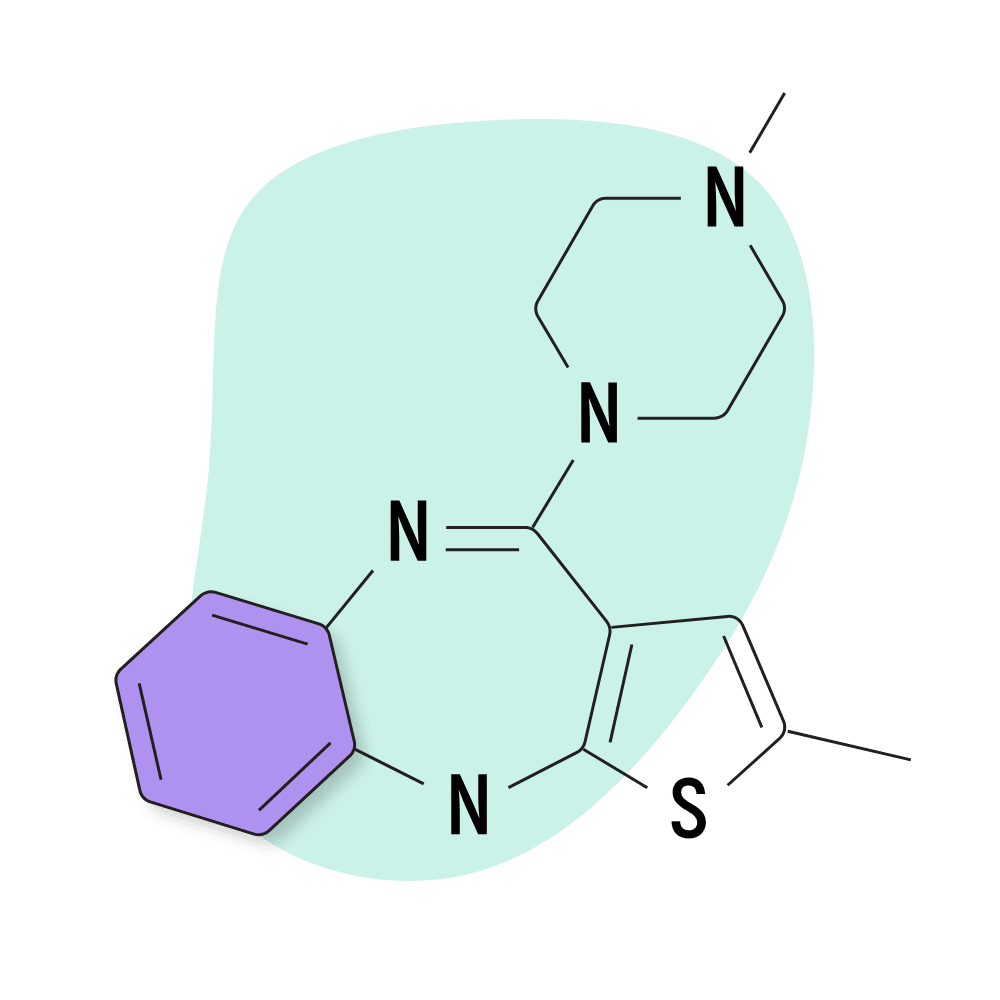
Olanzapine is another atypical antipsychotic reported to be effective in dulling the effects of psychedelics. This compound has a particularly high affinity for the 5HT2A receptor and is, therefore, better for killing the trips from tryptamine-based psychedelics like LSD, psilocybin, or DMT.
Zyprexa is less effective for dopaminergic or NMDA-based psychedelics such as the psychedelic amphetamines (MDMA, MDA, cathinones) or arylcyclohexylamines (PCP, ketamine, and others).
Olanzapine usually takes around 30 minutes to kick in at a 10–20 mg dose.
How Do Trip Killers Work?
Benzodiazepines such as diazepam or lorazepam (or other sedative anxiolytics) are usually the substances a doctor will administer if you’re submitted to the hospital due to signs of psychosis from consuming too much of a psychedelic substance.
These drugs work similarly to those for someone with a panic or anxiety attack. They have anxiolytic, sedative, and relaxant properties that all work to reduce anxiety levels and negative thought loops.
More specifically, benzodiazepines kill the trip by amplifying the activity of GABA in the brain. GABA is a neuroinhibitor — which means it reduces brain activity.
When we’re anxious, the inhibitory effects of GABA result in a dramatic reduction in anxiety levels. We think less, care less about our problems and feel more calm and relaxed. In higher doses, this causes full-on sedation.
The same concepts apply to psychedelic experiences. Paranoia, anxiety, and fear responses experienced during the psychedelic state can all be muted by dulling brain activity with GABA-boosting drugs.
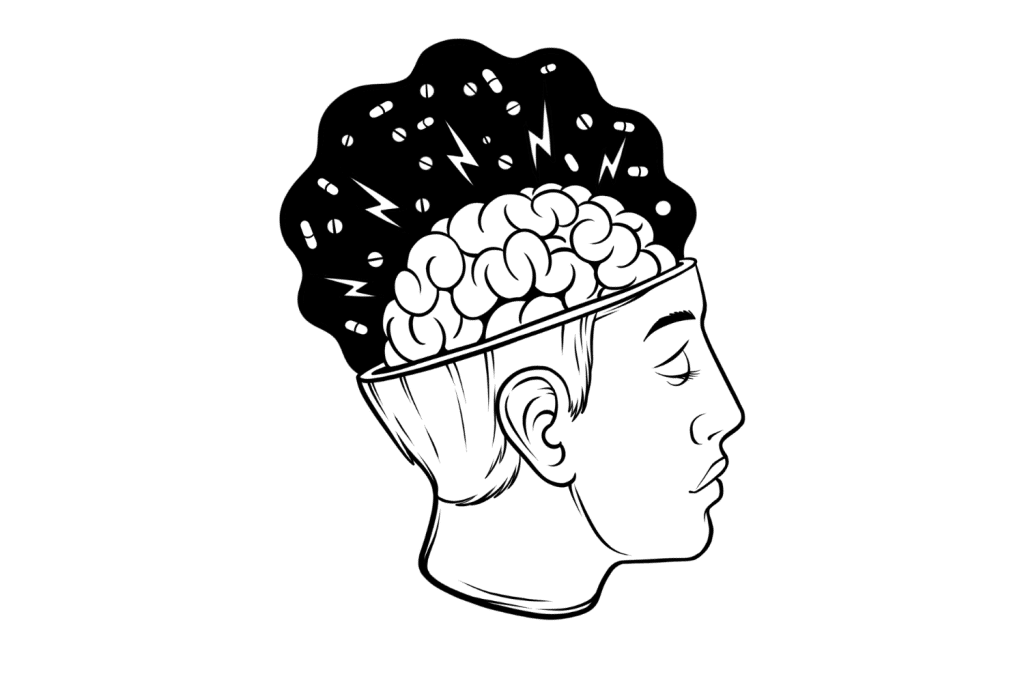
Antipsychotic trip killers work a little bit differently. These drugs work as serotonin and dopamine antagonists (blockers). The exact mechanism is still not fully understood, but the leading theory is that certain antipsychotics reverse the effects of psychedelics by blocking the 5-HT2A receptors.
5-HT2A is one of the main receptor sites on which psychedelics such as LSD and psilocybin work. Some, but not all, psychedelic substances bind to these receptors to induce their psychedelic effects.
Every trip killer is different — some kick in quickly (10–20 minutes); others take an hour or more.
Here are some of the average onset times for the four most popular benzo-based trip killers listed above.
These refer to the oral onset time of these drugs. It’s not a good idea to smoke, inject, or snort benzodiazepines for any reason.
- Alprazolam (Xanax): 10–20 minutes
- Lorazepam (Ativan): 20–45 minutes
- Diazepam (Valium): 1–2 hours
- Clonazepam (Klonopin): 45–60 minutes
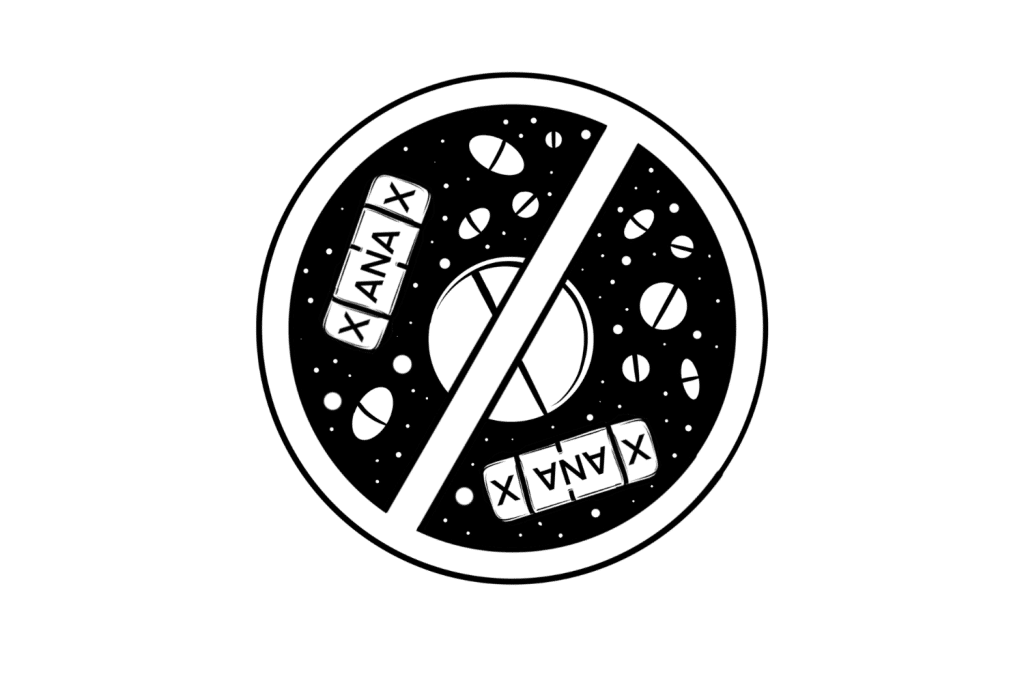
When Do Trip Killers NOT Work?
Trip killers don’t work on every psychedelic substance. Benzodiazepines and antipsychotic medications are effective for standard, serotonin-based psychedelics such as LSD and psilocybin. However, there are a few substances that don’t have any effective trip killers.
Always educate yourself on any substance before using it. You should know how much to take, what to expect during the trip, and onset times and duration. You should also know whether there’s an effective trip killer for it.
Psychedelic trips from some of the most commonly used psychedelics can be stopped by the use of benzodiazepines or antipsychotic medications.
These are the most prevalently used and have the most research surrounding them, though trip killers likely work on more substances than the ones listed below.
Here’s a list of commonly used psychedelic substances that do have effective trip killers:
- LSD (lysergic acid diethylamide) (and other lysergamide psychedelics )
- Psilocybin (the active compound in magic mushrooms )
- 4-AcO-DMT (synthetic shrooms)
- 5-MeO-DMT (the active compound in bufo toad venom )
- N,N-DMT (the active ingredient in ayahuasca )
- 2C-B (and other 2C psychedelics )
- NBOMes (N-bombs)
- Synthetic Cathinones (Bath Salts)
- MDMA (and other MDXX psychedelics )
- Mescaline (the active compound in Peyote & San Pedro cactus)
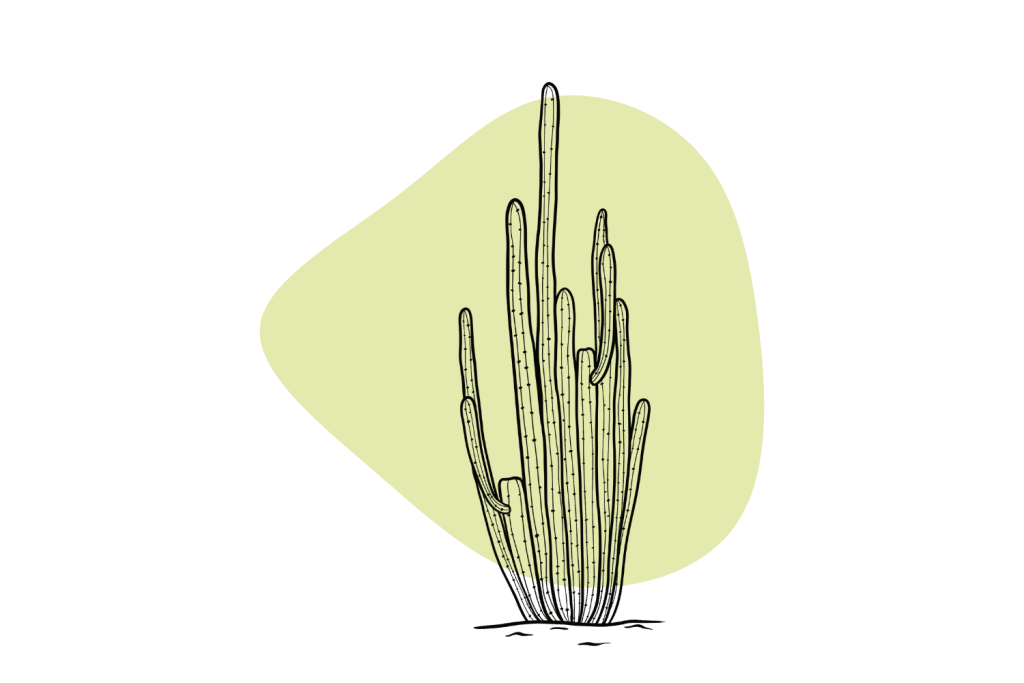
Some psychedelic substances do not have trip killers. Not all psychedelics affect the brain in the same way; therefore, trip killers, such as benzodiazepines, will not end all psychedelic experiences.
For example, many dissociative drugs like PCP or ketamine work via the NMDA receptors in the brain. The psychedelic trips these drugs produce appear to be unaffected by benzodiazepines. Making matters worse, most dissociatives are also considered sedatives — which are notoriously dangerous to mix with benzodiazepines.
Other substances, such as salvinorin A from salvia or any of the deliriant hallucinogenics, don’t diminish after taking benzodiazepines or Z-drugs. There are no effective trip killers for these substances.
If you plan on consuming any of the substances listed below, be warned that you have no option but to ride the experience out naturally. Never consume a substance that you’re not comfortable with.
It’s a good idea to have a trip sitter around that you trust who can help you through a difficult experience should it arise.
Here are some of the more common psychedelic substances that do not have effective trip killers:
- Datura (a hallucinogenic flower from the nightshade family)
- Brugmansia (commonly known as angel’s trumpet)
- Phencyclidine (and other arylcyclohexylamines )
- Ketamine (and other dissociatives )
- Grayanotoxins (found in Rhododendron flowers)
- Xenon gas or nitrous oxide gas
- Salvia divinorum
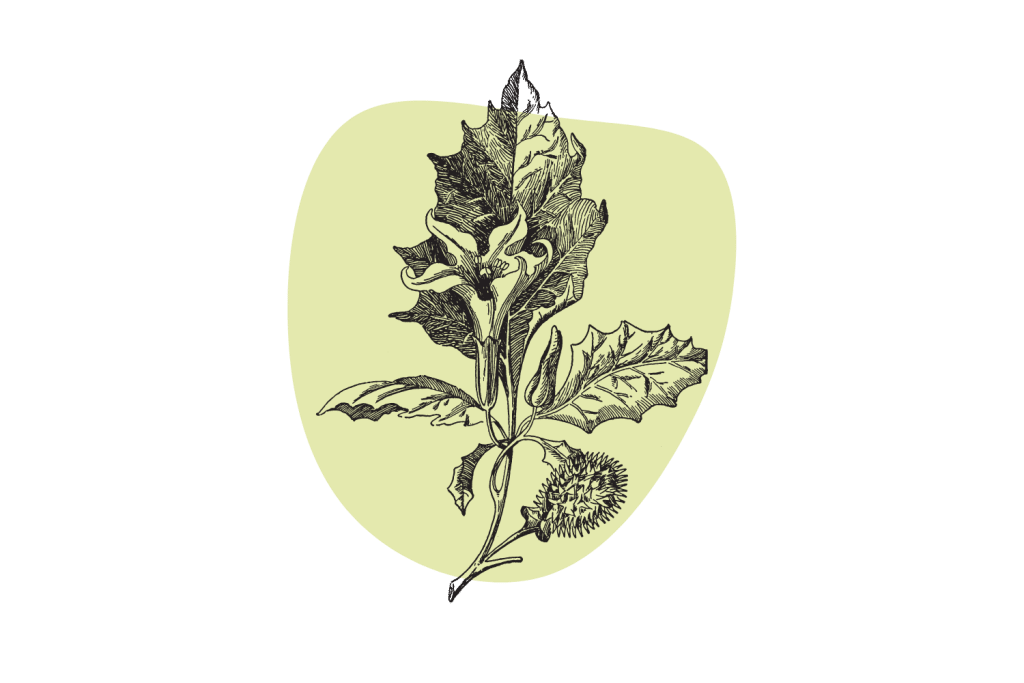
When Should You Use a Trip Killer?
Preferably, you should never consume a trip killer. A “bad trip” can often unlock a door that will show you traits in our personality (our “ shadow ”) or traumas and aspects in life that we need to heal in order to live a better life.
A typical “bad trip” is often a lesson containing vital information we can use to work on ourselves and get over mental blocks that reduce our quality of life. Using a trip killer to end an experience like this may be counterintuitive. Doing so could close “the door” that leads to healing.
Many experienced psychonauts swear off ever needing to consume trip killers to end a trip because they believe every vision has value. However, trip killers definitely have their place. You should always be safe rather than sorry and never bite off more than you can chew in terms of set, setting, and dosage. End the trip if you feel you’re in over your head.
As long as you use psychedelics responsibly , you’ll likely never need a trip killer. Proper dosing is the best way to ensure this, but having your frame of mind and setting fit for a psychedelic trip is also important. This way, if a bad trip occurs, you have the strength to deal with it.
Sometimes, we don’t get it right. A “bad trip” can spiral out of control into a nightmarish event that can be truly traumatic. When this happens, you and the others around you could be at risk.
People who swear off trip killers may have experienced a challenging trip but may not have had a truly terrifying one. It may never happen, but it could occur at any time, so it’s always wise to have some form of trip killer available.
A nightmarish loop of events during a trip can seem to last forever, and in some, it can lead them to cause harm to themselves or others. This is rare but not unheard of. Trip killers can be a lifesaver for those who find themselves trapped in such a situation.
In our opinion, trip killers should be a part of every psychonaut’s tool kit. You should strive never to use them, but they should be readily available in case a trip takes a dark turn that you feel you can’t benefit from or work through without putting yourself or others at risk.
No matter how responsible you are when planning a psychedelic trip, there are times when circumstances come up that are outside your control. You think you have the day to sit and trip, but suddenly something comes up (family emergency, etc.), and you need to be sober ASAP.
Even though a trip killer won’t make you feel “normal,” it’ll speed up the process and make you more clear-headed than you would be without it.
Some people should avoid benzodiazepine-based trip killers at all costs . This section outlines who should not take these types of trip killers and what they can use instead.
Although most psychedelics aren’t addictive, benzos definitely are. Anyone with an addictive personality or who has had a past dependence on benzos or similar substances should avoid using these as trip killers.
Benzos have some of the longest-lasting, worst, and most savage withdrawals of any substance on the planet.
Withdrawal symptoms can last for months. If you become addicted and prolong the use of these substances, quitting cold turkey isn’t an option. Simply quitting after prolonged benzo abuse can be life-threatening due to the body seizing up.
In simple terms: don’t use benzo-based trip killers if there’s a chance you’ll get addicted to them.
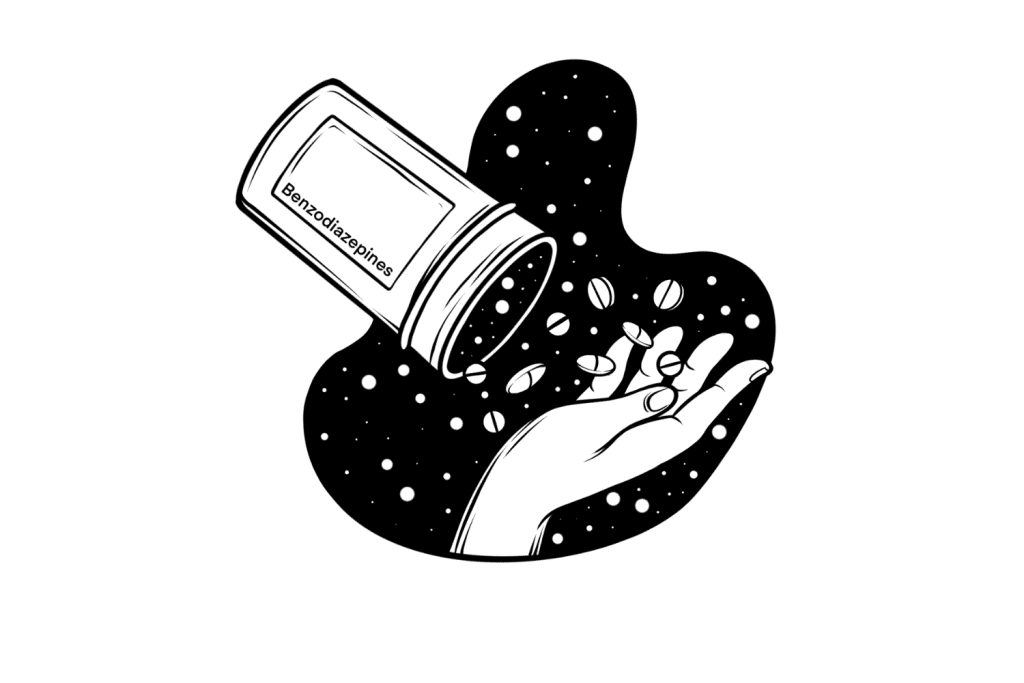
What To Expect When You “Kill” a Trip
As I’ve mentioned, trip killers aren’t an instant solution. You’re not going to magically become sober as soon as the pill touches your tongue. The onset time and experience will vary depending on the type of trip killer consumed, the dosage taken, the psychedelic consumed, and how far into your trip you are.
That being said, I can give you a rough idea of what happens when consuming a benzodiazepine trip killer during a bad experience.
Let’s paint a hypothetical picture.
A few hours after consuming your chosen psychedelic, you enter an area of dark and disturbing thoughts somewhere in your subconscious mind. At first, tell yourself, “It’s okay; it’s just the psychedelic messing with my brain.”
After a while, you start to convince yourself that this is, in fact, real, and you begin to sink into nightmarish thought loops.
If the situation starts to get out of hand, a trip killer might be employed to bring you back to some semblance of reality.
You chew one milligram of Xanax in the hope that the sublingual absorption will allow it to take effect quickly.
Although unpleasant, the acrid taste of the trip killer in your mouth relieves you. You associate the taste with the trip coming to an end. When you swallow your saliva, you feel a wave of calm rush over you because you know that this nightmare will all be over soon.
About 15 to 30 minutes later (depending on the trip killer consumed), you notice a wave of relaxation come over you. Any feelings of anxiety and panic start to wash away as the drug begins to take effect.
Not only do the dark thought loops start to diminish, but you also start to feel as though you don’t care about much of anything at all. You become emotionless and calm. You may or may not continue to experience hallucinations, but none of them seem to steal your attention.
If you’re not laying down already, you’ll probably seek out somewhere to post up and relax for a while as your muscles start to feel weak.
One hour after taking the trip killer, your hallucinations have likely died down substantially, and you feel much more rational and level-headed. You may even regret taking the trip killer — if you were in this head space originally, perhaps you wouldn’t have had such a terrifying experience.
Two to three hours after ingesting the trip killer, you feel more or less sober (depending on the psychedelic you consumed). Most of the effects of the psychedelics have worn off, and if you’re not already asleep, you’re probably feeling pretty drained and ready for some zzz’s.
You’ll be emotionally and physically exhausted by this time, and you’ll likely reach for a bottle of water and a hefty snack to restore the energy lost throughout the ordeal.
Safety Aspects to Consider When Using Trip Killers
There are a few things to consider when purchasing and adding trip killers to your psychedelic tool kit. The most effective trip killers — benzodiazepines — are restricted in terms of sale and use. This can make it difficult to legally purchase these drugs, which is where our first safety aspect stems.
If you cannot obtain trip killers (benzos) in a legal way — via prescription from a doctor — the level of risk goes up substantially.
The most popular benzodiazepines for recreational use are Valium (diazepam) and Xanax (alprazolam). These can be obtained on the black market, but it’s not recommended.
Illegal vendors distributing Valium and Xanax don’t necessarily consider the consumer’s best interest. Several samples of these substances have contained drugs such as fentanyl (an extremely dangerous synthetic opioid).
Clandestine drug manufacturers use tablet molds that produce exact replicas of the prescribed Xanax and Valium tablets. Criminals produce pills with these molds that look the same but contain a cocktail of potentially life-threatening substances. Whether you’re tripping or not, taking one of these pills at any time may pose a serious health risk.
Basically, unless you’re getting your drugs from a pharmacy, you can never be sure the drugs you’re using are safe.
If you absolutely have to purchase “trip killers” from the black market, you must test them using — at the minimum — a fentanyl test kit. We cannot stress this enough.
You can also buy benzo test kits to help identify what adulterants may be contained in your pills.
You should check your benzos before you need them. You’re not going to have time to test them for safety if using them as a trip killer.
Another safety aspect to consider is, of course, dosage. Getting the correct dosages for each substance is critical to avoid overdosing . However, you also need to consume enough of the substance to kill a trip.
Several individual drugs fall under the benzodiazepine classification; although similar, the required dosage for each differs.
It’s important to note that your weight, gender, and familiarity with the drug will affect the exact dose. A heavier person that regularly consumes benzos will need a far larger dose than a small-framed person that has never tried the substance before.
Below I’ve listed the recommended dosages of the four most popular trip killers based on first-hand reports and prescribed dosage guides. However, you should take these numbers with a grain of salt and do your own research outside before consuming anything to kill a trip. These substances can be dangerous.
- Alprazolam (Xanax): 0.5 to 1 mg
- Lorazepam (Ativan): 0.5 to 1.5 mg
- Diazepam (Valium): 5 to 10 mg
- Clonazepam (Klonopin): 1 to 1.5 mg
As you can see, the recommended dosages for killing a trip vary and depends on where you are on your trip.
Again, I can’t stress this enough — everyone’s required dosage will be different because of a variety of factors. Unfortunately, your required dose will be something you’ll have to find out through experience. Just be aware that trip killers of this nature don’t work immediately, so don’t keep dosing if you don’t experience any trip-calming effects right away . This is how overdoses occur.
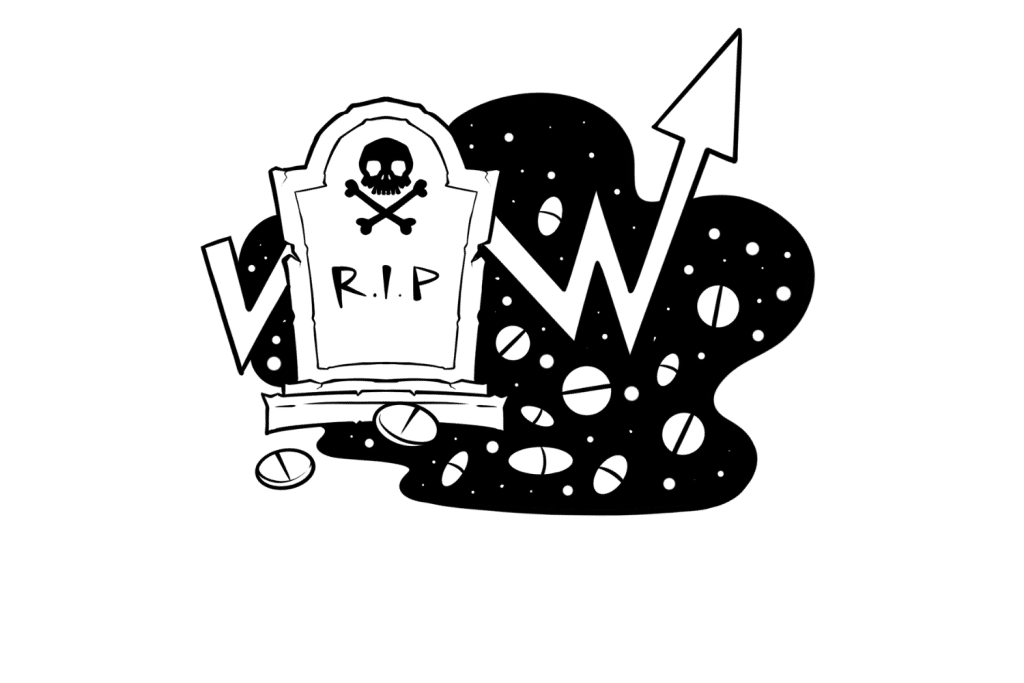
How To Minimize the Risk of a Bad Trip
Trip killers should only be used in an emergency when a trip takes a dark turn that could harm you or others around you. It’s best to avoid trip killers at all costs, and these steps can also help you have the best trip possible.
Preparation is key. If you’ve experimented with psychedelics before, you must have heard of set and setting.
The set is the frame of mind you’re in. When consuming psychedelic substances, you should never be in a negative, anxious, or unstable state of mind. Entering a trip with negative thoughts in your head is a surefire way to a nightmarish trip.
It’s important to relax your body and mind before entering a trip. This can be done by simply putting yourself in a good headspace by recalling a positive memory or experience. Practicing meditation and/or yoga can also help you relax into a positive state of mind.
The setting is the space you’ll experience the trip in. The setting is extremely important in psychedelics and will help you stay in the right “set.” Playing relaxing music, putting beautiful pictures around you, and lighting a few candles can make the setting more relaxed and inviting.
Many people also like to trip out in nature. This is a fantastic way to do it; however, several variables can affect your trip.
If you head out into nature for a psychedelic trip, ensure it’s in a safe area with no foot traffic. Make sure the weather is good, and there are no external factors that may “freak you out.” The last thing you want is bad weather (a storm, for example) or a stranger entering your space — this will likely lead to a bad experience.
Another way to ensure a smooth trip is to have an object nearby that means something to you. This object helps connect you to the physical world and can get you back on course if your trip dives into a dark place . Simply holding the object and looking at it may just be enough to snap you back to reality.
This technique is definitely something to try before resorting to the use of trip killers.
Trip killers may be an important part of the psychonaut’s tool kit. Hopefully, you will never need to use them, and you should strive to work through difficult experiences rather than chemically halt them.
However, if you have a truly terrifying psychedelic experience, they will help you get back to reality as quickly and safely as possible.
The most popular and effective trip killers are benzodiazepines or Z-drugs, but some antipsychotic medications are also effective and a good alternative for people with addictive personalities.
When sourcing trip killers, it’s important to test their purity. Several drugs on the black market are contaminated with fentanyl — an extremely dangerous synthetic opioid that’s similar to morphine but much stronger. This drug can be life-threatening, so it’s of paramount importance that any drug sourced on the black market is tested thoroughly.
Regardless of whether you have trip killers available, you should always practice safe psychedelic use. Ensuring that your set and setting are perfect before a trip helps mitigate the risk of a bad trip occurring. As we said, you should never need to use a trip killer, but they should be available as an absolute last resort.
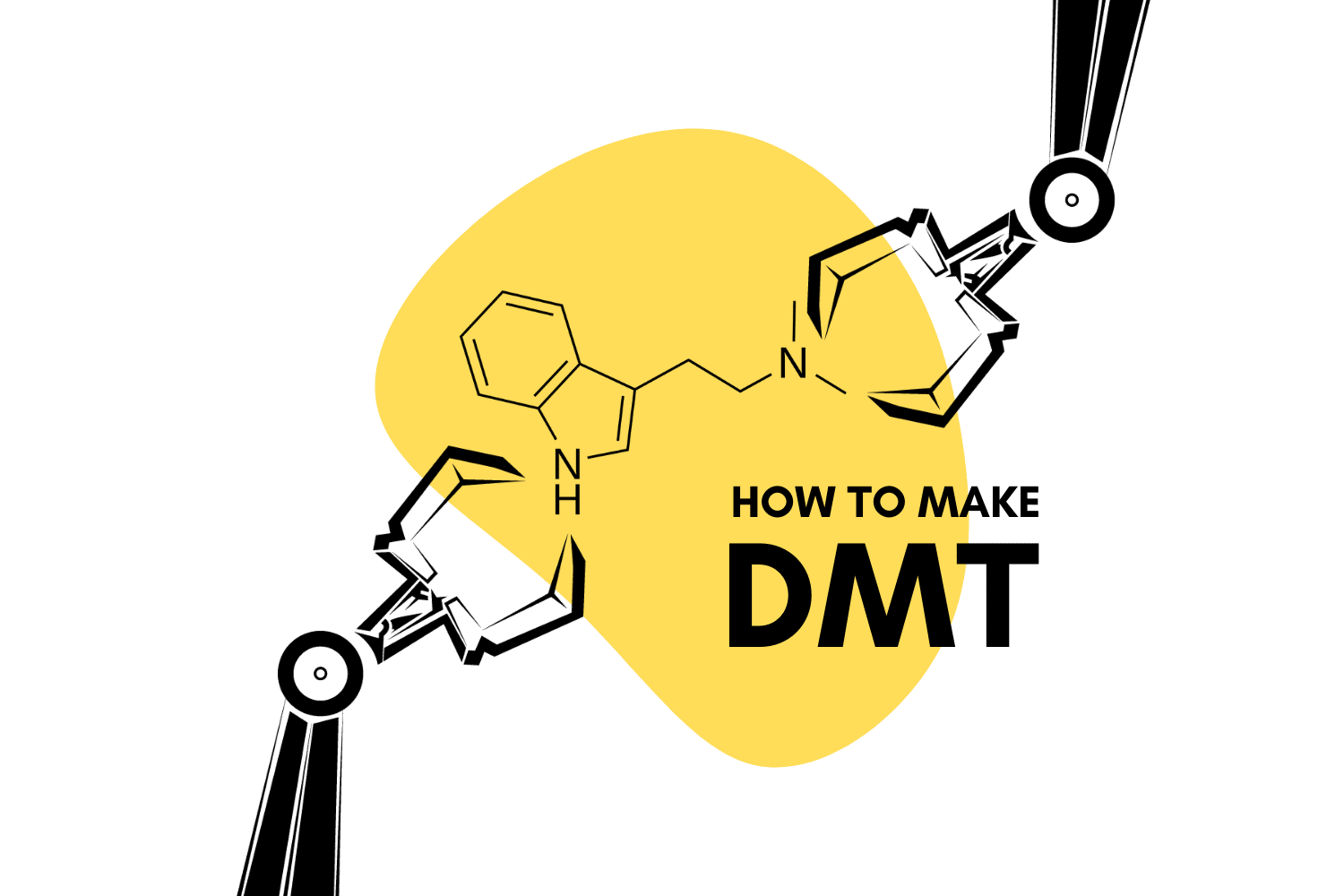
How to Make DMT: 3 Separate Methods (N,N,DMT & 5-MeO-DMT)
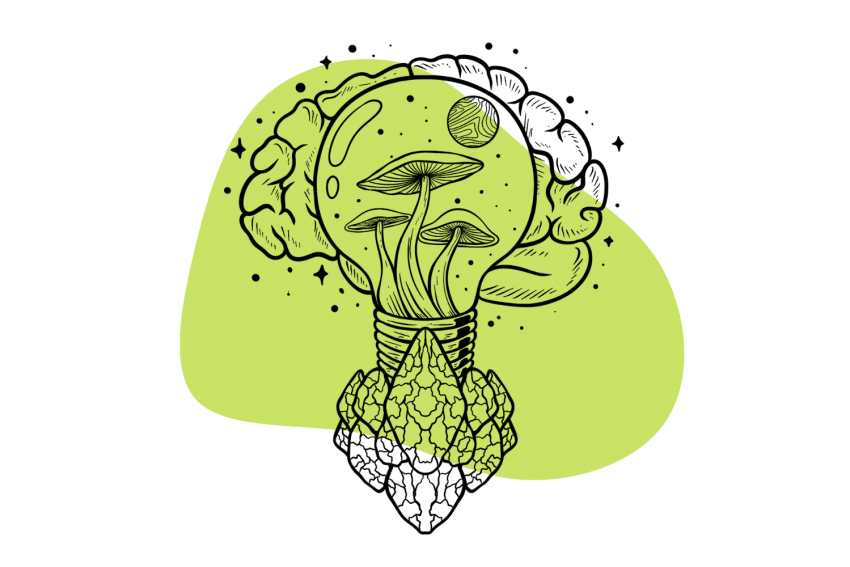
Can Psychedelics Help With Problem Solving?
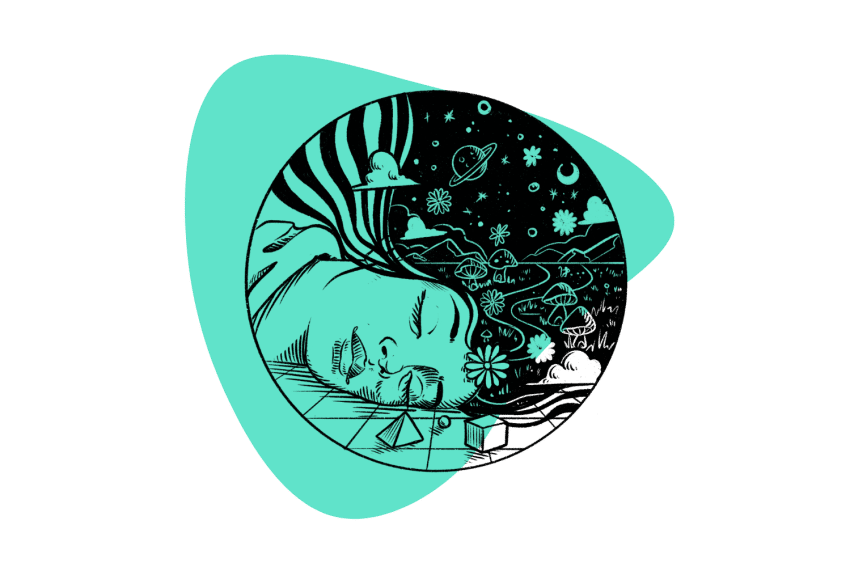
The Mind’s Theatre: Psychedelics & Dreams
What is the psilocybin cup (cup winners & strongest strains 2021 & 2022).
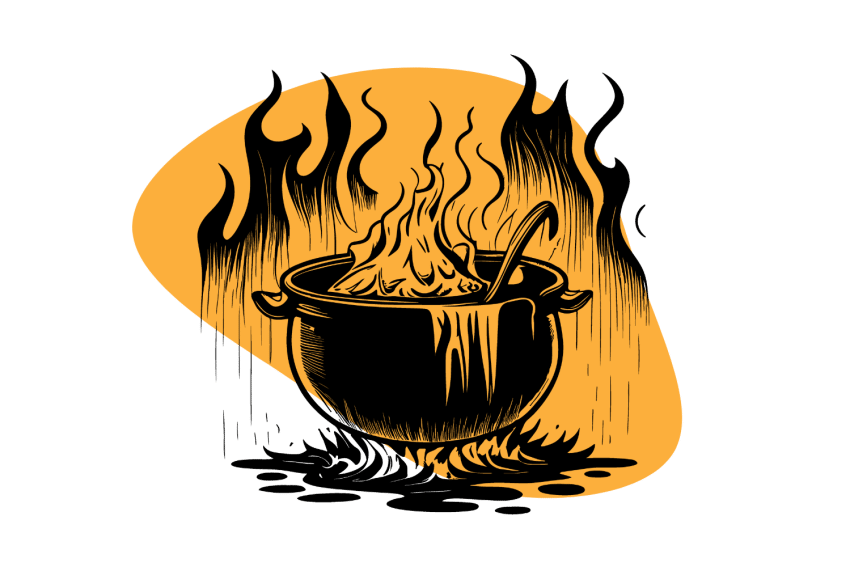
How to Make Ayahuasca: Step-by-Step Guide
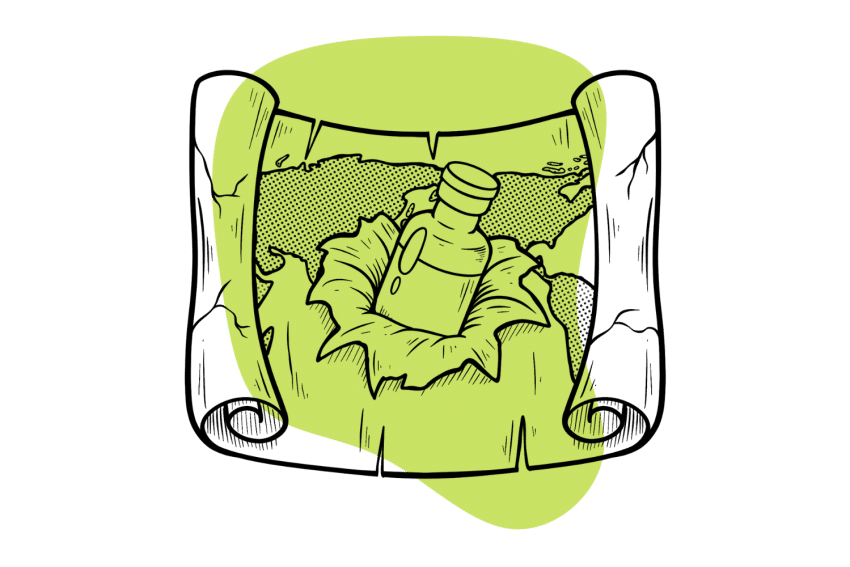
Where Does Ketamine Come from?
Subscribe for more psychedelics 🍄🌵.
This will close in 20 seconds
Featured Clinical Reviews
- Screening for Atrial Fibrillation: US Preventive Services Task Force Recommendation Statement JAMA Recommendation Statement January 25, 2022
- Evaluating the Patient With a Pulmonary Nodule: A Review JAMA Review January 18, 2022
- Download PDF
- Share X Facebook Email LinkedIn
- Permissions
Study Finds Hundreds of Reddit Posts on “Trip-Killers” for Psychedelic Drugs
- Viewpoint Emerging Challenges for Psychedelic Therapy Jacob S. Aday, PhD; Robin L. Carhart-Harris, PhD; Joshua D. Woolley, PhD, MD JAMA Psychiatry
- Viewpoint The Rapidly Shifting Ketamine Landscape in the US Samuel T. Wilkinson, MD; Joseph J. Palamar, PhD; Gerard Sanacora, MD, PhD JAMA Psychiatry
After decades of being outlawed across the globe, psychedelic drugs are returning to the psychiatric and neuroscience research scene. Although some of these mind-altering substances may be promising psychotherapeutics for issues including anxiety and depression, many unknowns remain, and they’re still mostly illegal recreationally. Nevertheless, nonmedical use is on the rise . While using psychedelics may result in a pleasurable experience, some people report having a “bad trip” that can be stressful and frightening—enough so to visit the emergency department (ED).
Read More About
Suran M. Study Finds Hundreds of Reddit Posts on “Trip-Killers” for Psychedelic Drugs. JAMA. 2024;331(8):632–634. doi:10.1001/jama.2023.28257
Manage citations:
© 2024
Artificial Intelligence Resource Center
Cardiology in JAMA : Read the Latest
Browse and subscribe to JAMA Network podcasts!
Others Also Liked
Select your interests.
Customize your JAMA Network experience by selecting one or more topics from the list below.
- Academic Medicine
- Acid Base, Electrolytes, Fluids
- Allergy and Clinical Immunology
- American Indian or Alaska Natives
- Anesthesiology
- Anticoagulation
- Art and Images in Psychiatry
- Artificial Intelligence
- Assisted Reproduction
- Bleeding and Transfusion
- Caring for the Critically Ill Patient
- Challenges in Clinical Electrocardiography
- Climate and Health
- Climate Change
- Clinical Challenge
- Clinical Decision Support
- Clinical Implications of Basic Neuroscience
- Clinical Pharmacy and Pharmacology
- Complementary and Alternative Medicine
- Consensus Statements
- Coronavirus (COVID-19)
- Critical Care Medicine
- Cultural Competency
- Dental Medicine
- Dermatology
- Diabetes and Endocrinology
- Diagnostic Test Interpretation
- Drug Development
- Electronic Health Records
- Emergency Medicine
- End of Life, Hospice, Palliative Care
- Environmental Health
- Equity, Diversity, and Inclusion
- Facial Plastic Surgery
- Gastroenterology and Hepatology
- Genetics and Genomics
- Genomics and Precision Health
- Global Health
- Guide to Statistics and Methods
- Hair Disorders
- Health Care Delivery Models
- Health Care Economics, Insurance, Payment
- Health Care Quality
- Health Care Reform
- Health Care Safety
- Health Care Workforce
- Health Disparities
- Health Inequities
- Health Policy
- Health Systems Science
- History of Medicine
- Hypertension
- Images in Neurology
- Implementation Science
- Infectious Diseases
- Innovations in Health Care Delivery
- JAMA Infographic
- Law and Medicine
- Leading Change
- Less is More
- LGBTQIA Medicine
- Lifestyle Behaviors
- Medical Coding
- Medical Devices and Equipment
- Medical Education
- Medical Education and Training
- Medical Journals and Publishing
- Mobile Health and Telemedicine
- Narrative Medicine
- Neuroscience and Psychiatry
- Notable Notes
- Nutrition, Obesity, Exercise
- Obstetrics and Gynecology
- Occupational Health
- Ophthalmology
- Orthopedics
- Otolaryngology
- Pain Medicine
- Palliative Care
- Pathology and Laboratory Medicine
- Patient Care
- Patient Information
- Performance Improvement
- Performance Measures
- Perioperative Care and Consultation
- Pharmacoeconomics
- Pharmacoepidemiology
- Pharmacogenetics
- Pharmacy and Clinical Pharmacology
- Physical Medicine and Rehabilitation
- Physical Therapy
- Physician Leadership
- Population Health
- Primary Care
- Professional Well-being
- Professionalism
- Psychiatry and Behavioral Health
- Public Health
- Pulmonary Medicine
- Regulatory Agencies
- Reproductive Health
- Research, Methods, Statistics
- Resuscitation
- Rheumatology
- Risk Management
- Scientific Discovery and the Future of Medicine
- Shared Decision Making and Communication
- Sleep Medicine
- Sports Medicine
- Stem Cell Transplantation
- Substance Use and Addiction Medicine
- Surgical Innovation
- Surgical Pearls
- Teachable Moment
- Technology and Finance
- The Art of JAMA
- The Arts and Medicine
- The Rational Clinical Examination
- Tobacco and e-Cigarettes
- Translational Medicine
- Trauma and Injury
- Treatment Adherence
- Ultrasonography
- Users' Guide to the Medical Literature
- Vaccination
- Venous Thromboembolism
- Veterans Health
- Women's Health
- Workflow and Process
- Wound Care, Infection, Healing
- Register for email alerts with links to free full-text articles
- Access PDFs of free articles
- Manage your interests
- Save searches and receive search alerts

Potentially harmful ‘trip-killers’ to cut short ‘bad’ drug trips, emerging concern, warn doctors
Benzodiazepines and antipsychotics most often recommended, but few safety warnings on social media
The use of potentially harmful ‘trip-killers’ to cut short ‘bad drug trips’ after taking psychedelics, such as LSD or magic mushrooms, is an emerging concern, warn doctors in a research letter, published online in Emergency Medicine Journal.
Their analysis of relevant threads on the social media platform Reddit, shows that drugs such as benzodiazepines (sedatives) and antipsychotics are the options most frequently recommended, but warnings about their potential side effects are rarely included, they highlight.
The intensity of a psychedelic drug trip can cause distress, agitation, and even psychosis, point out the authors, citing recent research indicating that more than 8% of drug-related attendances at European emergency care departments involve psychedelic drugs.
And this proportion may very well increase as the clinical use of these agents expands, they suggest.
One of the ways to cut short, or lessen the intensity of, a bad trip and avoid potentially requiring hospital treatment, is to take additional mind altering drugs, dubbed ‘trip-killers’.
Although not new, this option has gained much greater traction on social media in recent years, note the authors, who did a systematic keyword search of Reddit, looking for relevant threads in English to gain a better understanding of trip-killer use.
They found 128 threads created between 2015 and 2023, yielding a total of 709 posts.
Top of the league table, with 440 recommendations, amounting to nearly half (46%) of all the trip-killers mentioned in posts, were various benzodiazepines, followed by several different antipsychotics (171;18%).
One in 10 recommendations were for antidepressants, while 1 in 20 were for alcohol. Opioids, antihistamines, herbal remedies, such as camomile and valerian, and prescribed sleeping pills, attracted 3% each. Cannabis and cannabidiol each took 2% of the vote share.
Trip-killers were mostly discussed in reference to countering the effects of LSD (235 recommendations), magic mushrooms (143), and MDMA, popularly known as ecstasy (21).
Only 58 posts mentioned potentially harmful side effects.
“The popularity of benzodiazepines raises concerns,” write the authors. “Benzodiazepines are addictive and have been repeatedly implicated in overdose deaths. The doses described on Reddit risk over-sedation, hypotension [low blood pressure], and respiratory depression [stopping breathing or shallow breathing],” they point out.
Doses of one of the recommended antipsychotics, quetiapine, were also high (25 - 600 mg), they note, with only a few posts differentiating between fast and slower release formulations.
“Information on trip-killers isn’t available through drug advice services, despite the probable risks they pose,” highlight the authors.
20/12/2023
Notes for editors Research letter : Trip-killers: a concerning practice associated with psychedelic drug use doi: 10.1136/emermed-2023-213377 Journal: Emergency Medicine Journal
Funding: None declared
Link to Academy of Medical Sciences labelling system https://press.psprings.co.uk/ AMSlabels.pdf
Externally peer reviewed? Yes Evidence type: Observational; data analysis Subjects: People
BMJ Expert Media Panel
If you are a journalist needing to speak to an expert, please click here.
BMJ IN THE NEWS
Latest coverage of BMJ in the national and international media
JOIN OUR MEDIA LIST
If you are a journalist who would like to receive our press releases, please provide your details.
CONTACT OUR MEDIA RELATIONS TEAM
Email the UK media relations team for more information.
- Newsletters
Site search
- Israel-Hamas war
- Home Planet
- 2024 election
- Supreme Court
- TikTok’s fate
- All explainers
- Future Perfect
Filed under:
Psychedelics might revolutionize therapy. What happens if you remove the trip?
“Tripless” drugs might open more opportunities for psychiatry. Just don’t call them psychedelics.
Share this story
- Share this on Facebook
- Share this on Twitter
- Share this on Reddit
- Share All sharing options
Share All sharing options for: Psychedelics might revolutionize therapy. What happens if you remove the trip?
/cdn.vox-cdn.com/uploads/chorus_image/image/72481202/GettyImages_145958929.0.jpg)
Today’s psychedelic renaissance is thriving thanks to a list of drugs that you could count on just one hand. MDMA, psilocybin, LSD, and DMT are driving a revolution in psychiatry while opening new frontiers in the exploration of consciousness . If you expand to your other hand with drugs like ketamine and ibogaine , there’s enough mystery in that small gang of substances to keep researchers busy for decades.
But what if there were hundreds, or thousands, more? Drugs are like tiny Legos that can be rearranged in a staggering variety of ways. Chemists have hardly begun to discover all the endless molecular forms contained within the psychedelic arena. In the 1960s, the biochemist Alexander Shulgin, who introduced MDMA to the world, invented nearly 200 psychedelics (largely in his backyard laboratory, where he used sheet metal to keep the squirrels out). When President Richard Nixon outlawed psychedelics in 1970 , drug discovery went dark.
Nearly two decades into a revival of psychedelic research , the doors of drug discovery have swung wide open once again, and the latest development is roiling psychedelia, revealing fault lines that split the field into two.
The question: Can we tinker just enough with the molecular structure of psychedelic compounds so as to retain their therapeutic benefits, but ditch the trip? And should we? For many, the trip is the point. Cutting it out would be, to use 1960s terminology, a major bummer. Beyond a stream of unusual and profound experiences, many researchers believe that the insights people have on their trips are necessary for securing the long-term benefits, which can range from personally meaningful experiences to treating conditions such as depression or addiction .
For others, the trip is a barrier to treatment. Not everyone wants to have their entire consciousness rearranged in unfamiliar and sometimes unsettling ways for a little while. And integrating trips into existing models of therapy is both time-consuming and expensive. In Australia, the first country to legalize medically prescribed psychedelic therapy (which spans multiple days), one psychiatrist’s estimate put the combined cost of medication and the therapists’ time around $10,000 at the estimate’s lower end. In the US, Oregon is the first state to offer licensed access for adults over 21, where a single session costs $2,800 . “Take your pick: Comorbidities, cost, convenience, or other challenges will get in the way for some people who may not be able to access those [psychedelic] treatments,” Mark Rus, the CEO of Delix Therapeutics, a company working on developing variations on tripless psychedelics, told me.
In 2020, a group of researchers led by Delix co-founder and chemist David Olson published work suggesting tripless psychedelics are possible. In this case, a reengineered form of ibogaine — a psychoactive substance with dissociative properties found in a West African shrub, traditionally used by the Bwiti religion in Gabon and being studied today for its anti-addictive potential — still displayed therapeutic effects while leaving out the distortions of consciousness, at least in mice. In the years since, more papers have come out demonstrating that reengineered psychedelics like LSD can retain therapeutic effects while losing the trip — but again, all in mice.
Now, these psychedelic-inspired, tripless drugs are heading into human trials for the first time. In June, Delix Therapeutics announced a successful first round of dosing as part of their Phase I clinical trials of DLX-001, a ”non-hallucinogenic” version of MDMA. If the results replicate in humans, the implications could be significant. Rid of the trip, these drugs could prove safe and therapeutically effective to take at home, bypassing the need (and expense) for multiple in-person sessions and staffing. But even if such drugs prove effective in mitigating conditions like depression, anxiety, or addiction, according to others in the field, you’d be missing out on the very thing that makes psychedelics so reliably life-changing .
Why would you want a psychedelic without the trip?
With all the talk of a psychedelic renaissance , it’s easy to get the wrong idea. Sixty-eight percent of Americans have never tried psychedelics, according to a recent YouGov poll . A survey of mental health service users found that 20 percent still viewed psychedelics as unsafe, even under medical supervision, citing concerns about adverse effects (among other concerns like lack of knowledge and illegality). Leading researchers are already preparing for the “ bursting of the psychedelic hype bubble .”
Yet the vast majority of clinical psychedelic trips lean positive . Users consistently report them as among the most meaningful experiences of their lives , on par with the birth of one’s first-born child. And the list of promising therapeutic applications is growing. While uncommon, bad trips and negative side effects still happen , and the effects can persist for weeks or even years .
After a shot of mescaline (an LSD-like psychedelic found in several species of cacti), the French existential philosopher Jean-Paul Sartre saw a hallucinatory assortment of crustaceans that followed him around for weeks. “After I took mescaline, I started seeing crabs around me all the time. I mean they followed me into the street, into class,” he recalled . Today, we would call this episode hallucinogenic persisting perception disorder, an extremely rare side effect , and part of the reason clinical studies screen for participants with a predisposition for psychotic disorders.
No matter what sort of new mental health paradigm psychedelics may catalyze, between those with conditions that raise the risks of a trip, and those who may simply prefer to avoid experiencing one, there will be plenty of people who can benefit from different treatment options. If scientists can cut the trip out of psychedelics while leaving some of the therapeutic benefits intact, patients could take these drugs at home for a fraction of both the expense and time commitment of psychedelic therapy, widening the umbrella of treatment options to serve the over 50 million Americans who reported some kind of mental illness in 2020.
Just don’t call them psychedelics
One wrinkle in the development of these new drugs is semantic: If you successfully carve out the trip, what you are left with is not a psychedelic. And frankly, finding a name for these new compounds offers no simple options, and lots of room for confusion.
Olson coined the term “ psychoplastogen ,” drawing a boundary around the class of drugs that can rapidly boost neuroplasticity after a single dose. That distinguishes them from SSRI depression treatments like Prozac, which only boost neuroplasticity when taken over time . But both classical psychedelics and their new tripless relatives fit within the definition of psychoplastogens. To specify the tripless variety, you’ll find the offputting term “non-hallucinogenic psychoplastogen,” which poses no threat of catching on outside of academia. Instead, some have turned to calling them second-generation psychedelics , or “ non-hallucinogenic psychedelics ,” which grate against the very meaning of the word psychedelic.
Etymologically, psychedelic draws on the Ancient Greek for “mind manifesting,” referring directly to what scientists today call the “ acute subjective experiences .” The psychiatrist Humphry Osmond came up with the name in conversation with the philosopher and novelist Aldous Huxley in the 1950s, writing: “To fathom Hell or soar angelic / Just take a pinch of psychedelic.” A non-hallucinogenic psychedelic that subjectively manifests nothing out of the ordinary is an oxymoron.
To Rus and Olson, that’s fine. They’re in the business of psychoplastogens, not psychedelics. What matters is the untapped healing potential in rapid spikes of neuroplasticity, not how their new drugs compare and contrast to traditional psychedelics.
As far as naming goes, “neuroplastogen” is beginning to stick as a term describing the tripless category of psychoplastogens. We could still do with a Huxley-and-Osmand-like literary intervention to come up with something smoother, but until then, it’s an improvement.
How scientists carved the trip out of psychedelics (in mice)
While plenty of mystery still blankets the tripping brain, the classical psychedelics — psilocybin mushrooms, DMT, LSD, and mescaline — are at least known to all bind to the same serotonin 2A receptor , which is believed to be one of the main mechanisms underlying changes in activity across key brain circuits related to conscious experience.
One approach to untangling the trip from the therapy, published by a group of biochemists from the Shanghai Institute of Biochemistry and Cell Biology last year, involved zooming in a layer deeper. Instead of stopping at the observation of which receptor the drugs bind to, they looked at how the molecules actually fit into the curvature of the receptor. The fit is not perfectly snug, so using a method known as X-ray crystallography, they were able to see where the contact points are.
By shooting X-rays through a crystallized replica of a compound, and based on how the rays twist and turn through the crystal, you can determine how all the atoms therein are arranged, creating a sort of atomic map. A co-author on the publication, Sheng Wang, first used the method in a 2017 study to see how LSD fits into the related serotonin 2B receptor, and found that it slots into a cavity known as the orthosteric binding pocket (OBP).
In the 2022 publication, Wang and colleagues produced six new crystalline drug replicas, this time bound to the 2A receptor. They found that in addition to the OBP, some, but not all, compounds also nestle into a nearby second cavity, the extended binding pocket (EBP).
Next, they dosed mice with each of the drugs. In mice, head twitching is taken as the sign of a trip, while increasing the amount of time they struggle to stay afloat in a cylinder of water before simply allowing themselves to drown is the sign of antidepressant effects (this is known as the forced swimming test, and we should stop doing it ). Wang and colleagues learned that drugs slotting into the EBP show hallucinatory effects, while drugs that only fit into the OBP — like serotonin — display only antidepressant effects.
Armed with that insight, they created new variations of LSD designed to lean away from the EBP, focusing on the OBP. The result, at least in mice, was two relatives of LSD that achieved the hoped-for result: no head twitching, but more time spent keeping afloat in the depression tank; in other words, like Delix’s MDMA variant, a new potential neuroplastogen.
How much of the therapy will humans lose without the trip?
Despite recent advances, jumping from head-twitching and water-treading in mice to carving out psychedelic experiences while still treating depression in humans is a serious leap. “I just find it very implausible that you’ll see full and enduring benefits from psychedelics without the acute subjective effects [or: the trip],” David Yaden, an assistant professor at Johns Hopkins who works in the Center for Psychedelic and Consciousness Research, told me earlier this year .
In a 2021 paper , Yaden and his colleague Roland Griffiths contend that to get the full beneficial effects of psychedelics, the trip is necessary. That’s not exactly controversial: Even Olson, the Delix co-founder, who published a counterpoint on the same day, agrees. The trip may be “critical for achieving maximal efficacy,” he writes. However, Olson argues that whatever benefits are left over after cutting out the trip can still have value, especially since they may be able to reach wider patient populations.
How much benefit remains depends on an unsettled question in the world of psychedelic therapy: Is rapidly boosting neuroplasticity, on its own, good treatment? Olson believes so, and there’s some preclinical research in drugs like ketamine, MDMA , and ibogaine to back it up. More recently, however, a preprint study reported ketamine was given to subjects under anesthesia (eliminating any associated trip), and found no difference from placebo , suggesting that something about having the experience makes a difference.
At the University of Wisconsin-Madison, anesthesiology professor Matthew Banks is tinkering with something in between leaving the trip alone and anesthesia: What if you let people have their full-on psychedelic experience, but then erase their memory of the trip altogether? Do you need to remember a trip for the benefits to stick?
As part of an eight-person pilot study at the university’s Transdisciplinary Center for Research in Psychoactive Substances , participants received both psilocybin and midazolam, an amnesia-inducing drug used to leave conscious experience intact, but wipe away memories (it’s often used to help patients forget about colonoscopies ). “It’s like you’re one of those philosophical zombies. You’re conscious and having conversations, but you have no recollection the next day,” Banks said.
He explained that getting the dosing right is tricky because psilocybin seems to lay down durable memories, which Banks speculates is due to the elevated neuroplasticity. Once researchers boosted the dose enough to wipe most of the trip from memory, the benefits seemed to have departed, too. “There appears to be something happening where we’re wiping out some of those long-term behavioral effects of the drug,” Banks said.
In part, this was likely because participants were healthy volunteers, not patients suffering from conditions like treatment-resistant depression. Since neuroplastogens are imagined as therapies, the amnesia study doesn’t tell us much about their fate in treating mental illness. While Banks admitted that successful preclinical studies in mice “open the possibility that all the hallucinogenic stuff is largely irrelevant” for therapeutic outcomes, he believes that “it really does matter what you actually do with all that plasticity.”
If neuroplastogens become take-at-home pills, then they do away with both parts of psychedelic therapy : the psychedelic experience, and the therapy itself. Robin Carhart-Harris, a professor of neurology at the University of California, San Francisco, pointed out to the New York Times last year that plasticity is just a greater capacity to be reshaped. Whether for better or worse may depend on what happens after you take the drug. Pairing trips with therapy helps guide the plasticity towards beneficial outcomes. Without the trip, Carhart-Harris said in the Times, the result could be underwhelming: a drug that creates “a little bit of plasticity but it’s not really transformative.”
However, just because neuroplastogens are entirely unlike psychedelic therapy doesn’t mean they can’t still offer their own benefits. Instead of using plasticity to reprogram a particular habit, let alone altering one’s metaphysical view of the universe, Rus described how they may help repair the neuronal wear and tear associated with everything from chronic stress to neurodegenerative diseases such as Alzheimer’s. Sustained stress can grind away at neurons and affect brain connectivity, especially in key regions such as the prefrontal cortex . Simply spiking neuroplasticity may help repair the worn neurons, and bring those dampened networks of connectivity back online.
“What these new psychoplastogens are really good at doing is rapidly regrowing those spines [which connect neurons] and restoring circuit-level connectivity. The degree to which that repaired connectivity results in the behavioral changes or feelings that one seeks, time and data will ultimately tell,” Rus said.
No one believes current-generation antidepressants — SSRIs such as Prozac and Lexapro — are the pinnacle of depression treatments. In the space between Prozac and psychedelic therapy, there’s plenty of room for middling treatments that improve upon what we have now, but fall short of the transformative trips one might have on psychedelics.
Human trials will tell whether neuroplastogens may find a place in the cultural medicine cabinet. But these are just one category among hundreds of thousands of potential new psychedelic-inspired drugs that await discovery now that research is back online. Our single-digit list of psychoactive compounds is already transforming minds and industries alike. As that inventory expands, we may discover that the psychedelics we’re familiar with were only the modest beginnings of what will come next.
Will you support Vox today?
We believe that everyone deserves to understand the world that they live in. That kind of knowledge helps create better citizens, neighbors, friends, parents, and stewards of this planet. Producing deeply researched, explanatory journalism takes resources. You can support this mission by making a financial gift to Vox today. Will you join us?
We accept credit card, Apple Pay, and Google Pay. You can also contribute via
Next Up In Future Perfect
Sign up for the newsletter today, explained.
Understand the world with a daily explainer plus the most compelling stories of the day.
Thanks for signing up!
Check your inbox for a welcome email.
Oops. Something went wrong. Please enter a valid email and try again.

Philosophers are studying Reddit’s “Am I the Asshole?”

High interest rates probably aren’t going away anytime soon

Want to know how to reduce gun crime? Look at Detroit.

How La Niña will shape heat and hurricanes this year

The Kristi Noem puppy-killing scandal, explained

Drake vs. everyone, explained

What Happens During A ‘Bad Trip’ From Drugs?
Published on September 14, 2022
- Drugs That Cause Bad Trips
- Understanding Tripping
- Side Effects
- Fatal Trips
- Trip Lengths
A bad trip can occur after taking a hallucinogen or psychedelic like LSD or psilocybin. The duration of a bad trip can vary, depending on the drug and dose taken, and effects may be physical and/or psychological in nature.
Home > What Is A 'Bad Trip'?

Certain types of illicit drugs can cause what’s known as a “bad trip.” A bad trip can generally be described as a negative experience with a drug. Typically, a hallucinogen.
A bad trip from hallucinogenic or dissociative drug use may cause side effects that can be distressing and potentially dangerous.
What Drugs Can Cause A Bad Trip?
The term “bad trip” is typically associated with hallucinogens and dissociative drugs that can warp your sense of time and perception. These drugs are also known as psychedelic drugs.
Examples of drugs that can cause you to trip include:
- lysergic acid diethylamide (LSD)
- ecstasy/MDMA/molly
- psilocybin (magic mushrooms)
- peyote (mescaline)
How Do You Know If You’re Tripping?
An experience on psychoactive drugs like LSD is referred to as a “trip” because they have effects that may make you feel as though you’ve traveled to an unfamiliar land.
You might see or hear things that aren’t real, have a warped sense of how much time has passed, and you may develop false beliefs about objects, concepts, or people around you.
Other signs of tripping might include:
- feeling disconnected from your body
- feeling of floating
- feeling of relaxation
- high body temperature
- reduced pain response
- reduced appetite
- increased heart rate
- mood changes
A trip has been described by some as producing a spiritual or positive experience. But hallucinogen use can also sometimes cause powerful, unpleasant effects, or, a bad trip.
How Do You Know If You’re Having A Bad Trip On Drugs?
A bad trip on drugs can be a highly unpleasant and distressing experience. What this looks or feels like for you can vary somewhat from person to person.
Side effects of hallucinogenic drug intoxication may be mild, moderate, or intense in nature.
Side Effects And Symptoms Of A Bad Trip On Drugs
A bad trip on drugs may be identified by a number of signs and symptoms of drug intoxication. These can be physical, psychological, or cognitive in nature.
Signs and symptoms of a bad trip may include:
- overwhelming anxiety
- visual or auditory distortions (hallucinations)
- false belief that someone is trying to hurt you
- severe mood swings
- high blood pressure
- psychosis (loss of touch with reality)
Risks And Dangers Of A Bad Trip
A bad trip can pose some serious risks and dangers to your health and livelihood. This is one reason why taking drugs alone (and illicit substance use in general) is not recommended.
Some risks and dangers of a bad trip include:
- accident or injury
- panic attack
- thoughts of suicide
- drug overdose
- hallucinogen persisting perception disorder (HPPD)
Can A Bad Trip On Drugs Become Deadly?
A bad trip could become life-threatening if certain symptoms of drug use become severe. For instance, if a false belief or hallucination causes you to get into a serious accident.
Very high body temperature and other physical symptoms of hallucinogens can also become serious in some cases, and could lead to dehydration or organ damage.
Fatal overdose can also occur if too much of a drug is taken. This is a greater risk among those who ingest multiple drugs within a short window (e.g. hallucinogens with alcohol or cannabis).
How Long Does A Bad Trip On Drugs Last?
Some drugs may cause trips that last less than half an hour, while others — LSD, for instance — may cause trips that last up to 12 hours.
The length of a trip may depend on:
- the type of drug taken
- how it’s taken (e.g. snorted, swallowed)
- how quickly your body metabolizes the drug
Getting Help For Illegal Drug Abuse
A growing body of research shows that psychedelics may be helpful for the treatment of certain mental health issues when taken as directed by a qualified healthcare professional.
However, frequent hallucinogen use can also be a sign of drug abuse or self-medication.
Substance abuse treatment, beginning with detox , may be recommended if this is the case. For information about treatment options for illicit drug abuse, call our helpline today.
- Journal of Psychedelic Studies — Inside bad trips: Exploring extra-pharmacological factors https://akjournals.com/view/journals/2054/2/1/article-p53.xml
- Journal of Psychopharmacology — The Challenging Experience Questionnaire: Characterization https://doi.org/10.1177%2F0269881116678781
- U.S. National Institute on Drug Abuse (NIDA) — Hallucinogens DrugFacts https://nida.nih.gov/publications/drugfacts/hallucinogens
- Access to licensed treatment centers
- Information on treatment plans
- Financial assistance options
100% confidential. We respect your privacy.
- 10 Most Common Causes Of Addiction Relapse
- List Of The 12 Most Commonly Abused Drugs In The Workplace
- Drug Rehab Vs. Detox: What’s The Difference?
Where Do Calls Go?
About Our Helpline
The helpline at DetoxRehabs.net is available 24/7 to discuss the treatment needs of yourself or a loved one. This helpline is answered by Ark Behavioral Health , an addiction treatment provider with treatment facilities in Massachusetts and Ohio.
When you call our helpline, you’ll be connected with a representative who can assist you in finding mental health and addiction treatment resources at any of the Ark Behavioral Health addiction treatment facilities.
You nor your loved one are under any obligation to commit to an Ark Behavioral Health treatment program when calling our helpline.
If one of our treatment centers is not a good fit, our representatives may refer you to another detox or treatment center, or the Substance Abuse and Mental Health Services Administration ( SAMHSA ) hotline to find a program that best suits your needs. We do not receive any compensation or commission for referrals to other treatment facilities.
This helpline is a free resource at no cost to the caller. We are here to provide assistance in locating an Ark Behavioral Health treatment center that may meet your treatment needs.
To find a treatment program, browse the top-rated addiction treatment facilities in each state by visiting our homepage , or by viewing the SAMHSA Treatment Services Locator.

Detox Rehabs

- News Releases
Potentially harmful ‘trip-killers’ to cut short ‘bad’ drug trips, emerging concern, warn doctors
Benzodiazepines and antipsychotics most often recommended, but few safety warnings on social media
The use of potentially harmful ‘trip-killers’ to cut short ‘bad drug trips’ after taking psychedelics, such as LSD or magic mushrooms, is an emerging concern, warn doctors in a research letter, published online in Emergency Medicine Journal.
Their analysis of relevant threads on the social media platform Reddit, shows that drugs such as benzodiazepines (sedatives) and antipsychotics are the options most frequently recommended, but warnings about their potential side effects are rarely included, they highlight.
The intensity of a psychedelic drug trip can cause distress, agitation, and even psychosis, point out the authors, citing recent research indicating that more than 8% of drug-related attendances at European emergency care departments involve psychedelic drugs.
And this proportion may very well increase as the clinical use of these agents expands, they suggest.
One of the ways to cut short, or lessen the intensity of, a bad trip and avoid potentially requiring hospital treatment, is to take additional mind altering drugs, dubbed ‘trip-killers’.
Although not new, this option has gained much greater traction on social media in recent years, note the authors, who did a systematic keyword search of Reddit, looking for relevant threads in English to gain a better understanding of trip-killer use.
They found 128 threads created between 2015 and 2023, yielding a total of 709 posts.
Top of the league table, with 440 recommendations, amounting to nearly half (46%) of all the trip-killers mentioned in posts, were various benzodiazepines, followed by several different antipsychotics (171;18%).
One in 10 recommendations were for antidepressants, while 1 in 20 were for alcohol. Opioids, antihistamines, herbal remedies, such as camomile and valerian, and prescribed sleeping pills, attracted 3% each. Cannabis and cannabidiol each took 2% of the vote share.
Trip-killers were mostly discussed in reference to countering the effects of LSD (235 recommendations), magic mushrooms (143), and MDMA, popularly known as ecstasy (21).
Only 58 posts mentioned potentially harmful side effects.
“The popularity of benzodiazepines raises concerns,” write the authors. “Benzodiazepines are addictive and have been repeatedly implicated in overdose deaths. The doses described on Reddit risk over-sedation, hypotension [low blood pressure], and respiratory depression [stopping breathing or shallow breathing],” they point out.
Doses of one of the recommended antipsychotics, quetiapine, were also high (25 - 600 mg), they note, with only a few posts differentiating between fast and slower release formulations.
“Information on trip-killers isn’t available through drug advice services, despite the probable risks they pose,” highlight the authors.
Emergency Medicine Journal
10.1136/emermed-2023-213377
Method of Research
Observational study
Subject of Research
Article title.
Trip-killers: a concerning practice associated with psychedelic drug use
Article Publication Date
19-Dec-2023
Disclaimer: AAAS and EurekAlert! are not responsible for the accuracy of news releases posted to EurekAlert! by contributing institutions or for the use of any information through the EurekAlert system.

5 Ways to Trip Without Psychedelics
Turns out, you don't need psychedelics to have a psychedelic experience..
Article by console.log(""); console.log("author name"); console.log("James McClure"); James McClure .author-bio * {display: unset !important;} Fact Checked by: Shelby Hartman Published on March 25, 2020 Updated April 15, 2024
While the word “psychedelic” may always be associated with LSD , shrooms , and other entheogens, taking these substances isn’t the only way to have a psychedelic experience. In fact, there are several ways to alter your perception without having to ingest anything at all, and some of these methods may even have their own therapeutic benefits. Looking for a sober trip? Here are five ways to have a psychedelic experience without a psychedelic.
Holotropic Breathwork
You don’t need LSD to experience life-altering visions. In fact, all you need is already inside your chest, according to proponents of Holotropic Breathwork (HB), which unlocks the psychedelic potential of your lungs.
Holotropic Breathwork is a form of self-healing and self-discovery developed by LSD researcher Stanislav Grof and his wife Christina. HB involves lying down with your eyes closed and breathing in fast, deep and forceful breaths until you induce a non-ordinary state of consciousness that’s like a vivid, waking dream.
What you see in that dream is determined by what you need to experience in order to develop your mind and spirit, according to HB pioneer Mark Boroson , who believes that Holotropic Breathwork conjures images and symbols needed to help you achieve the next level in your personal evolution.
For journalist Michael Pollan, that image was a surreal race through a forest:
“There wasn’t much visual imagery [at first], just the naked sensation of exhilaration, until I began to picture myself on the back of a big black horse, galloping headlong down a path through the forest,” Pollan wrote of his experience with HB in a chapter from his 2018 book How to Change Your Mind . “I could feel myself absorbing the animal’s power. It felt so fantastic to fully inhabit my body, as if for the first time.”
And that’s not the only benefit you can get from the exercise. Holotropic Breathwork has been used to help people work through several conditions, including severe trauma , stress, addiction, depression and chronic pain. Studies have shown that HB can reduce death anxiety, boost self-esteem, promote higher levels of self-awareness and improve behavioral problems like hostility, neediness and controllingness.
How to Grow Shrooms Bundle
Take both of our courses and save $90.
But you probably won’t get those benefits just by lying on the floor of your living room and hyperventilating. For best results, you should consider working with a trained Holotropic Breathwork facilitator , who will design the right setting (including evocative music) for the session, which usually lasts three hours.
Afterward, the facilitator will encourage you to express your experience verbally or through art. The Grofs designed Holotropic Breathwork to empower people to take control of their own healing and personal growth, so an HB facilitator may ask questions to help you probe the meaning of your experience, but they won’t interpret it for you. HB facilitators are taught that the experience is intensely personal, so the only way for you to understand what it means is to work it out for yourself.
Sensory Deprivation

If you’re an extreme introvert, there’s no better way to enjoy a drug-free psychedelic experience than inside a sensory deprivation tank, which isolates you from everyone else on earth as well as your own senses.
The traditional tank is an unlit, soundproof chamber containing about 10 inches of skin-temperature water that is saturated with epsom salts to help you float, which reduces your sense of touch. Getting used to those conditions can be difficult, and many first-timers experience panic attacks and even nausea . But if you can breathe deep and work through those unpleasant side effects, the sensory-deprivation experience eventually induces a deep meditative state that can result in feelings of euphoria, hallucinations, and even out-of-body experiences.
Those hallucinations can involve seeing surreal images or hearing imaginary music.
“I heard a beautiful aria drifting in and out, like music from a faraway phonograph; soon it morphed into a full symphony before settling into a simple, tribal beat,” Shelly Fan of Discover wrote after a session at Vancouver’s Float House in 2014. “Incredibly, I did not recognize any of these tunes; my brain was spontaneously generating them.”
Fan isn’t the only one who’s found that sensory deprivation tanks can boost the creative juices. A handful of studies suggest that floating can boost originality, imagination and intuition. There’s also research to support using sensory deprivation to help people quit smoking, reduce drinking, lower blood pressure, manage symptoms of General Anxiety DIsorder, enhance physical flexibility, improve sleep quality, alleviate stress, and combat depression. Additional research is needed to support those findings, but the initial results suggest that sensory deprivation could treat everything from anxiety to writer’s block.
Those findings might make you wonder why more people aren’t flocking to “float spas” every day. Well, there are two reasons why sensory deprivation hasn’t been embraced by mainstream health enthusiasts. The tanks have had a bad reputation ever since it was discovered that the CIA studied them in the 1970s as an alternative form of torture. That reputation only worsened when the tank’s inventor—neuroscientist and psychoanalyst John C. Lilly—started experimenting with his invention while under the influence of LSD and ketamine (because sensory deprivation wasn’t trippy enough for him, apparently).
“Due to Lilly’s unconventional methods, his public relationship with recreational drugs and seemingly unscientific experiments, research on floatation tanks and anything under the umbrella of sensory deprivation were abandoned due to stigma from both Lily and torture,” Kimberley Carder, a doctoral student at Alliant International University, wrote in her 2018 dissertation on sensory deprivation .
But that could change in the near future. Perceptions of hallucinogenic drugs have been steadily improving as more and more studies suggest that psychedelics have therapeutic potential . As that progress continues, we’ll probably see attitudes toward sensory deprivation tanks improve, as well.
Anechoic Chamber
Sensory deprivation tanks are soundproof, but they aren’t completely soundless. While your ears won’t pick up anything outside the chamber, you can hear the swishing of the water and other ambient noises inside the tank. To experience total sound deprivation, you have to visit special facilities like the anechoic chamber at the Orfield Laboratories in Minneapolis, Minnesota.
The chamber is so quiet that it actually registers a negative level of decibels, which means that it’s below the threshold for human hearing . Reachers achieved this feat by installing large wedges made of fibreglass on all six sides of the room, so that any noise made inside the chamber is quickly swallowed up by the ridges in the walls. And to keep outside noises from penetrating the chamber, researchers encased the room in 12-inch thick walls of solid concrete.
The Anechoic Chamber at Orfield Laboratories: 99.99% sound absorbent and makes you hallucinate http://t.co/lq0PwUstlF pic.twitter.com/7Lf9is896Q — Basement Jaxx (@TheBasementJaxx) March 5, 2013
The first thing that people notice when they sit inside the anechoic chamber is that they can hear noises inside their bodies much clearer than ever before. Visitors have reported that their heartbeat and the gurgling of their digestive system sounds louder than ever in the chamber. Some have even said that they could hear the sound of their blood flowing and their bones moving.
Visitors have also experienced hallucinations after sitting in the room for a few minutes with the lights out.
“I began to feel weightless and detached, as though my consciousness was separating from my body,” journalist Bill Hanstock wrote in a 2017 article for UPROXX after spending 10 minutes in the chamber. “My head began to feel elongated, like a balloon filling with air. I’ve never taken any hallucinogenic drugs, but I believe you would describe the sensations I felt as ‘mildly tripping balls.’ I didn’t see any colors or visions; I didn’t see anything at all, of course [because it was pitch black]. But I felt the perfect stillness and serenity of the room, I heard nothing, I saw nothing, and I began to feel as though I was stretching in all directions; that my being was filling the void.”
If you’re brave enough to stare into the void, you can check out the anechoic chamber in Minneapolis for an entrance fee of $125 USD per person (minimum $250).
Most of the entries on this list can’t be induced at home unless your neighbours happen to be Holotropic Breathwork facilitators or you have enough cash to buy your own sensory deprivation tank or build an anechoic chamber. But this entry is different. All you have to do is watch the video below, which was designed to create hallucinations based on the motion aftereffect (MAE) illusion.
MAE is also known as the “ Waterfall Illusion ” because it often happens naturally when people stare at a waterfall for a while and then look at a stationary object, which will appear to be moving because their eyes have become accustomed to watching things in motion.
This video takes that illusion and puts it on steroids by adding visual effects to enhance the distorted view of the world that you’ll get after staring at your screen for about 90 seconds.
“I was watching tv and doing this and looked back [and] the TV was moving,” said YouTube commenter Oblivion.EXE.
Another noticed that the decorations in their room had turned into a Salvador Dali painting: “The paintings on my walls stretched apart from eachother [sic] and then flowed back inwards lol” wrote a user called malfunction.
Some found the results downright terrifying: “I did this and looked at my girlfriends [sic] face…..I screamed” wrote watchEm.
One commenter lamented that the trippy experience was too brief: “Wish it would last longer than 10-20 secs” said Robert Lance. Others were frustrated with how long the effects lasted: “I just watched this about 15 minutes ago and my eyes are still tripping out, when Im [sic] typing this, i cant [sic] see everything on the screen ffs” wrote avd.
If you want to find out what they’re talking about, check out the video below. But don’t watch it while you’re in the middle of anything important as the effects of the clip can be extremely disorienting.
The Vortex Tunnel
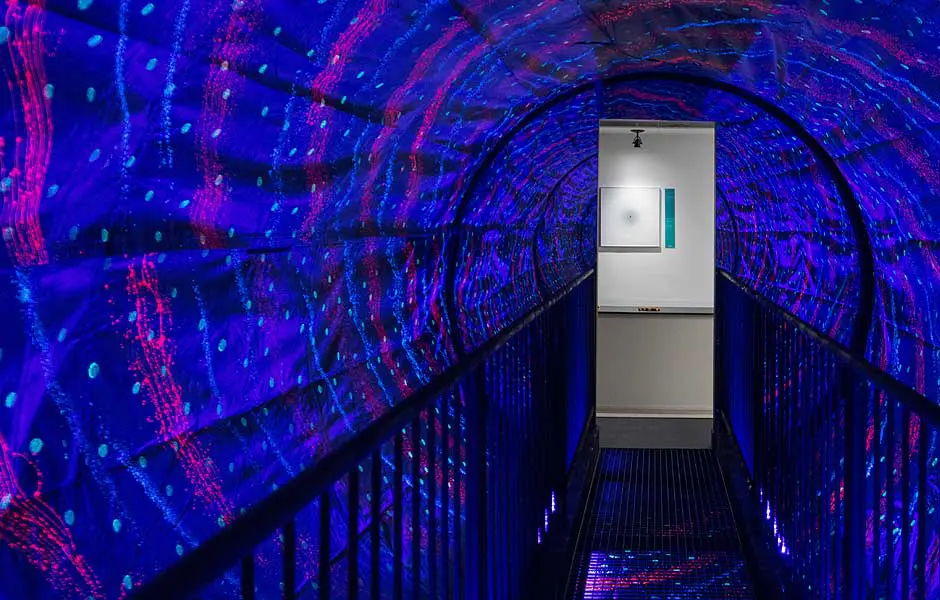
If you’re looking for a mind-bending experience during your next trip to Canada, consider swinging by the Museum of Illusions in Toronto. Inside, you’ll find The Vortex Tunnel, which is basically a bigger version of the video above, but instead of watching it on YouTube, you can step inside the illusion.
The Vortex Tunnel is a large corridor with rotating walls that are lit with blacklights. As you walk into the tunnel, the fluorescent paint on the spinning walls will make you feel like you’ve been thrown inside a washing machine full of neon pink and purple clothes. I made it about a third of the way down the metal catwalk in the centre of the tunnel before freaking out because it felt like I was about to go cartwheeling into a technicolour abyss.
After doubling back, I took a few deep breaths to steady myself and work up the courage to face the vortex again. This time, I kept a tight grip on the metal railing that runs through the tunnel, which provided just enough support to convince my panicking brain that I wasn’t actually tumbling through the eye of a psychedelic cyclone.
A minute later, I emerged on the other side and felt the euphoria of triumph for a few fleeting seconds before crashing into a wall. Turns out, the tunnel’s disorienting effects last for a little while after you’ve left the spinning room behind. As soon as I could walk straight again, I went back through the tunnel one more time to snap a video for all of you to see.
Admission to the Vortex Tunnel is included in the price of admission to the museum ($28.36 CAD), which includes many other trippy attractions.
Related posts:
- How to Make Sense of Your Last Trip
- How to Trip Sit Someone on Psychedelics
- What You Should Know to Have a Safe Kambo Experience
- Mushroom Coffee 101: A Detoxifying, Invigorating Potion

How to Take Shrooms
How much shrooms should a beginner take, preparing for your first mushroom trip we've got you..

Can Psychedelics Make You Fall in Love Faster?
Psychedelics can speed up the process of falling in love—but does that love remain in tact after the trip is over.

Shrooms vs. Acid
Psilocybin mushrooms and lsd are among the most popular of the classic psychedelics, but do you know the difference in each of their effects.
WORLD TRADE ORGANIZATION
Home | About WTO | News & events | Trade topics | WTO membership | Documents & resources | External relations
Contact us | Site map | A-Z | Search
español français
- trade topics
- drug patents
Pharmaceutical patents and the TRIPS Agreement
The purpose of this note is to describe those provisions of the Agreement on Trade-Related Aspects of Intellectual Property Rights (TRIPS Agreement) that relate to the standards of patent protection to be accorded to inventions in the area of pharmaceuticals.
- that, together with some 25 other legal texts, it is an integral part of the Agreement Establishing the World Trade Organization (and therefore subject to the WTO dispute settlement system);
- that it covers not only patents but all the other main areas of intellectual property rights; and
- that it lays down not only the minimum substantive standards of protection that should be provided for in each of these areas of intellectual property, but also the procedures and remedies that should be available so that rights holders can enforce their rights effectively.
What pharmaceutical inventions must be patentable under the TRIPS Agreement?
The main rule relating to patentability is that patents shall be available for any invention, whether a product or process, in all fields of technology without discrimination, where those inventions meet the standard substantive criteria for patentability — namely, novelty, inventive step and industrial applicability. In addition, Members are required to make grant of a patent dependent on adequate disclosure of the invention and may require information on the best mode for carrying it out. Disclosure is a key part of the social contract that the grant of a patent constitutes since it makes publicly available important technical information which may be of use to others in advancing technology in the area, even during the patent term, and ensures that, after the expiry of the patent term, the invention truly falls into the public domain because others have the necessary information to carry it out.
Three types of exclusion to the above rule on patentable subject-matter are allowed. These may be of interest from a public health perspective:
- inventions the prevention of whose commercial exploitation is necessary to protect ordre public or morality, including to protect animal or plant life or health;
- diagnostic, therapeutic and surgical methods for the treatment of humans or animals; and
- certain plant and animal inventions.
What are the rights conferred by a patent under the TRIPS Agreement?
The minimum rights that must be conferred by a patent under the TRIPS Agreement follow closely those that were to be found in most patents laws, namely the right of the patent owner to prevent unauthorized persons from using the patented process and making, using, offering for sale, or importing the patented product or a product obtained directly by the patented process.
Term of protection
Under the TRIPS Agreement, the available term of protection must expire no earlier than 20 years from the date of filing the patent application. It should be noted that, although the issue of patent term extension to compensate for regulatory delays in the marketing of new pharmaceutical products was raised in the Uruguay Round negotiations, the TRIPS Agreement does not contain an obligation to introduce such a system.( 1 )
Limitations/exceptions to these rights
Under the TRIPS Agreement, patent rights are not absolute but can be subject to limitations or exceptions. These can be put into four categories:
the Agreement allows limited exceptions to be made by Members provided that such exceptions do not unreasonably conflict with a normal exploitation of the patent and do not unreasonably prejudice the legitimate interests of the patent owner, taking account of the legitimate interests of third parties. Thus, for example, many countries allow third parties to use a patented invention for research purposes where the aim is to understand more fully the invention as a basis for advancing science and technology. The WTO Panel in Canada — Patent Protection for Pharmaceutical Products decided that this provision, allowing limited exceptions, covered a provision of Canadian law which permits the use by generic producers of patented products, without authorization and prior to the expiry of the patent term, for the purposes of seeking regulatory approval from public health authorities for the marketing of their generic version as soon as the patent expires. (This provision is sometimes referred to as the “regulatory exception” or as a “Bolar” provision.) The Panel Report was adopted by the WTO Dispute Settlement Body on 7 April 2000;
the Agreement also allows Members to authorize use by third parties ( compulsory licences ) or for public non-commercial purposes ( government use ) without the authorization of the patent owner. Unlike what was sought by some countries in the negotiations, the grounds on which this can be done are not limited by the Agreement, but the Agreement contains a number of conditions that have to be met in order to safeguard the legitimate interests of the patent owner. Two of the main such conditions are that, as a general rule, an effort must first have been made to obtain a voluntary licence on reasonable commercial terms and conditions and that the remuneration paid to the right holder shall be adequate in the circumstances of each case, taking into account the economic value of the licence;
the Agreement recognizes the right of Members to take measures, consistent with its provisions, against anti-competitive practices and provides more flexible conditions for the grant of compulsory licences where a practice has been determined after due process of law to be anti-competitive. For example, the conditions referred to above for the grant of compulsory licences may be relaxed in these circumstances. The Agreement also provides for consultation and cooperation between Members in taking action against anti-competitive practices;
the TRIPS Agreement makes it clear that the practices of WTO Members in regard to the exhaustion of intellectual property rights (e.g. a Member’s decision to have a national exhaustion regime, under which right holders can take action against parallel imports, or an international exhaustion regime, under which they cannot) cannot be challenged under the WTO dispute settlement system, provided that they do not discriminate on the grounds of the nationality of right holders.
Other policy instruments
Governments have a range of public policy measures outside the field of intellectual property to address issues of access to and prices of drugs. For example, many countries use price or reimbursement controls. Article 8 of the TRIPS Agreement makes it clear that WTO Members may, in formulating or amending their rules and regulations, adopt measures necessary to protect public health and nutrition, provided that such measures are consistent with the provisions of the Agreement.
Transition provisions
The TRIPS Agreement lays down some transition provisions which gave WTO Members periods of time in order to adapt their legislation and practices to their TRIPS obligations. Those periods differ according to the type of obligation in question and the stage of development of the country concerned. With respect to those transition provisions which relate to the application of the obligations on substantive standards for the protection of pharmaceutical inventions, the obligations are mainly divided into two categories of countries:
(i) as the basic rule, developing countries had until 1 January 2000 to apply the provisions of the TRIPS Agreement, including the obligations regarding the protection of process and product patents. As regards product patents for pharmaceutical products, those developing countries which did not grant such protection on 1 January 2000 had an extra period until 1 January 2005 to introduce it. Since most developing country Members of the WTO already provided for product patent protection for pharmaceuticals, a relatively small number of countries were concerned( 2 );
(ii) least-developed countries originally had until 1 January 2006 to meet their TRIPS obligations. The TRIPS Council has extended this deadline three times, most recently until 1 July 2034 (Decision of 29 June 2021).
In both cases, the rules of the TRIPS Agreement apply or will apply not only to new patent applications but also to patents still under protection at the end of the respective transition periods.
Notwithstanding proposals to the contrary, the TRIPS Agreement did not require the bringing under protection of pharmaceutical inventions that were in the “pipeline” in these countries at the time of entry into force of the WTO.(3) However, with effect from that date (1 January 1995), those developing and least-developed countries that did not already make available patent protection for pharmaceutical products, were under an obligation to provide a system whereby applications for patents for pharmaceutical product inventions could be filed (often referred to as a “mailbox” system). These applications did not have to be examined until after 1 January 2005 in the case of developing countries. If found to be patentable by reference to their filing (or priority) date, a patent would have to be granted for the remainder of the patent term counted from the date of filing. The General Council has waived this obligation for least developed country members until 1 January 2033 (Decision of 30 November 2015).
In the event that a pharmaceutical product that was the subject of a “mailbox” application obtained marketing approval prior to the decision on the grant of a patent, an exclusive marketing right of up to five years had to be granted provided that certain conditions were met. The General Council has also waived this obligation for least developed country members until 1 January 2033 (Decision of 30 November 2015).
Concluding remarks
Most developing and least developed countries already granted patent protection for pharmaceutical products prior to the entry into force of the TRIPS Agreement. In these countries, the TRIPS Agreement therefore did not lead to fundamental changes in this regard, although a certain amount of adjustment in legislation, for example in respect of patent term and compulsory licencing, was often necessary. With respect to the countries that did not provide patent protection for pharmaceutical products at the time of entry into force of the WTO Agreement, some, including Brazil and Argentina, decided to bring such protection into effect more quickly than is required under the TRIPS Agreement.
The TRIPS Agreement pays considerable attention to the need to find an appropriate balance between the interests of rights holders and users. This was an important theme in its negotiation. This is not only reflected in the basic underlying balance related to disclosure and providing an incentive for R&D, but also in the limitations and exceptions to rights that are permitted and in the transition provisions. The flexibilities in the TRIPS Agreement have subsequently been clarified and reinforced by the Doha Declaration on the TRIPS Agreement and Public Health, as well as by the Waiver Decision of August 2003 and the Amendment Decision of December 2005 to facilitate compulsory licenses for export to needful countries.
It should also be appreciated that the protection of pharmaceutical inventions was one aspect of a much wider agreement, covering not only the protection of intellectual property in general in a coherent and non-discriminatory way but also further liberalization and strengthening of the multilateral trading system as a whole. While it is true that some countries put particular emphasis on TRIPS matters in the Uruguay Round negotiations, it is also true that other countries attached great importance to other areas, for example textiles and agriculture. It is a belief shared by all WTO Members that a strong and vibrant multilateral trading system is essential for creating conditions for economic growth and development worldwide. This in turn provides for the generation of the resources required to tackle health problems.
> back to text
(2) Thirteen WTO Members (Argentina, Brazil, Cuba, Egypt, India, Kuwait, Morocco, Pakistan, Paraguay, Tunisia, Turkey, United Arab Emirates and Uruguay) have notified “mailbox” systems to the TRIPS Council, thus indicating that they did not grant patent protection to pharmaceutical products. Some of them, such as Argentina, Brazil and Turkey, have since introduced such protection. (It cannot be excluded that there were a few other WTO Members who should have notified but did not done so).
(3) The “pipeline” refers to the backlog of inventions of new pharmaceutical products that were no longer patentable on that date, because disclosed, but not yet on the market because pending marketing approval.

IMAGES
VIDEO
COMMENTS
A psychedelic experience (known colloquially as a trip) is a temporary altered state of consciousness induced by the consumption of a psychedelic substance (most commonly LSD, mescaline, psilocybin mushrooms, or DMT). [citation needed] For example, an acid trip is a psychedelic experience brought on by the use of LSD, while a mushroom trip is a psychedelic experience brought on by the use of ...
It is called a trip because the sensations that a psychedelic ( hallucination-causing) drug causes can be so strange that it feels as if you are in a whole different world. A bad trip, also sometimes called a bad acid trip, occurs when the trip a psychedelic drug causes is negative. Bad trips can lead to excessive fear, agitation or emotionally ...
What It's Like to Trip on DMT. Everything to know about the hallucinogenic "spirit molecule"—common side effects include seeing aliens and finally connecting with the universe. MH. by ...
It is often referred to as the "happy chemical" due to its influence on feelings of happiness and well-being. 1. LSD. Lysergic acid diethylamide, more commonly known as LSD or acid, is an illegal semi-synthetic drug famous for causing extreme distortion of sensory perception as well as hallucinations.
Some of the trip-killing drug doses suggested in the Reddit posts were high. For example, quetiapine was suggested to be used at 25mg to 600mg, but clinical guidance for these drugs suggests a ...
1. It's totally legal. This is probably the biggest upside of taking a technodelic trip. Even if you go to a place where psilocybin has been decriminalized under state (or city) law, its status ...
Credit: Ted Kinsman/SPL. Psychedelic drugs can cause lasting effects on the brain. Just a single dose of these mind-altering substances can spur neurons to grow new offshoots called dendritic ...
Unfortunately, things don't always turn out that way. Even if you're an experienced drug user, chances are you might have a bad trip someday, a negative experience while high on psychedelics ...
The study, "Trip-killers: a concerning practice associated with psychedelic drug use," was published in Emergency Medicine Journal on Dec. 19. It was announced in a news release the same day ...
More information: Trip-killers: a concerning practice associated with psychedelic drug use, Emergency Medicine Journal (2023). DOI: 10.1136/emermed-2023-213377. The use of potentially harmful ...
Participants reported using a number of drugs — mostly LSD and psilocybin — in a broad range of settings, including solo trips, underground ceremonies, clinical trials, therapy sessions, and ...
DMT, or the spirit molecule, has a profound effect on human consciousness. DMT, or its chemical name N, N-Dimethyltryptamine, is a psychedelic drug found throughout nature. With similar effects as ...
Perhaps unsurprisingly, the majority of bad trips happen when individuals on drugs feel overwhelmed in a noisy, chaotic setting like that of a concert or party. Drug-drug interactions are also often at play during difficult trips, for example, when people combine alcohol with psychedelics.
Lorazepam is considered an intermediate-acting benzodiazepine. This means it won't kick in quite as fast as something like Xanax — but the effects last for over eight hours. This is a better option for long-lasting psychedelics, such as DOX compounds, 2CX compounds, or other amphetamine psychedelics. Lorazepam is great for getting you out of a bad trip, but it may cause drowsiness to the ...
After decades of being outlawed across the globe, psychedelic drugs are returning to the psychiatric and neuroscience research scene. Although some of these mind-altering substances may be promising psychotherapeutics for issues including anxiety and depression, many unknowns remain, and they're still mostly illegal recreationally. Nevertheless, nonmedical use is on the rise.
Benzodiazepines and antipsychotics most often recommended, but few safety warnings on social media The use of potentially harmful 'trip-killers' to cut short 'bad drug trips' after taking psychedelics, such as LSD or magic mushrooms, is an emerging concern, warn doctors in a research letter, published online in Emergency Medicine Journal.
If scientists can cut the trip out of psychedelics while leaving some of the therapeutic benefits intact, patients could take these drugs at home for a fraction of both the expense and time ...
A.J., a 30-year-old who requested anonymity to discuss his drug use and medical history, said he suffers from hallucinogen persisting perception disorder, a rare condition brought on by the use of ...
People often use drugs in order to feel good. However, sometimes, a person who is using hallucinogens or other drugs can experience a condition known as a "bad trip," sometimes referred to as a "psychedelic crisis." The phrase "bad trip" is sometimes used to describe a situation where using the drug creates an intensely negative psychological response. 1
A bad trip on drugs can be a highly unpleasant and distressing experience. What this looks or feels like for you can vary somewhat from person to person. Side effects of hallucinogenic drug intoxication may be mild, moderate, or intense in nature. Side Effects And Symptoms Of A Bad Trip On Drugs. A bad trip on drugs may be identified by a ...
The intensity of a psychedelic drug trip can cause distress, agitation, and even psychosis, point out the authors, citing recent research indicating that more than 8% of drug-related attendances ...
Holotropic Breathwork is a form of self-healing and self-discovery developed by LSD researcher Stanislav Grof and his wife Christina. HB involves lying down with your eyes closed and breathing in fast, deep and forceful breaths until you induce a non-ordinary state of consciousness that's like a vivid, waking dream.
6 Practical Safety Tips to Do During a Bad Drug Trip. Handling a bad drug trip requires practical and calm measures, especially if you are helping out during an episode. Here are six safety tips to help you manage this situation: Stay Calm and Reassuring; Keep yourself calm and try comforting the person experiencing the bad trip.
TRIPS: DRUG PATENTS, TECHNICAL NOTE Pharmaceutical patents and the TRIPS Agreement. The purpose of this note is to describe those provisions of the Agreement on Trade-Related Aspects of Intellectual Property Rights (TRIPS Agreement) that relate to the standards of patent protection to be accorded to inventions in the area of pharmaceuticals.
The psychedelic experience of tripping is most commonly known through the use of mushrooms and lsd, but eye gazing is an amazing practice which has been show...